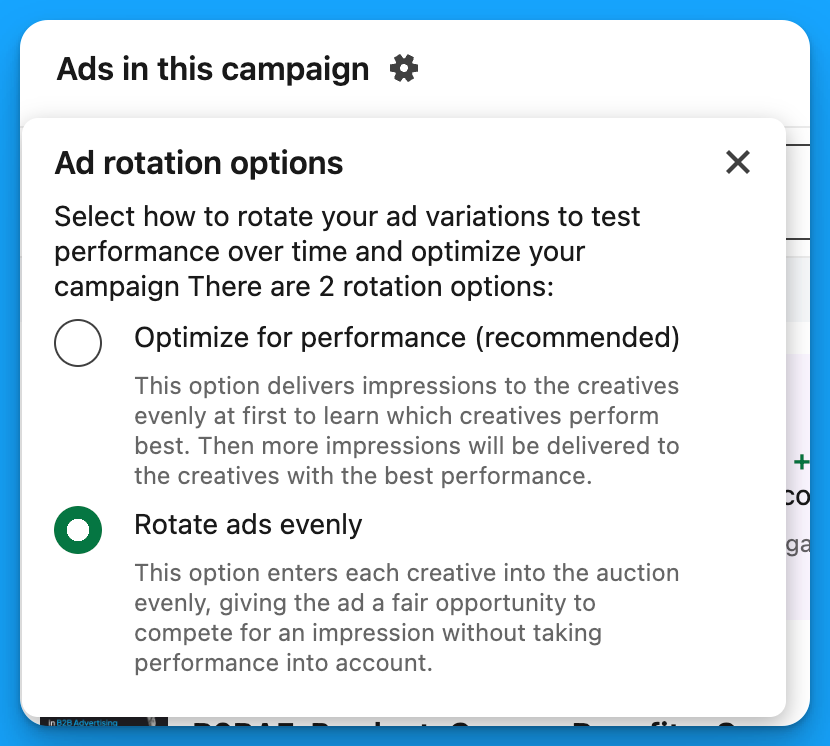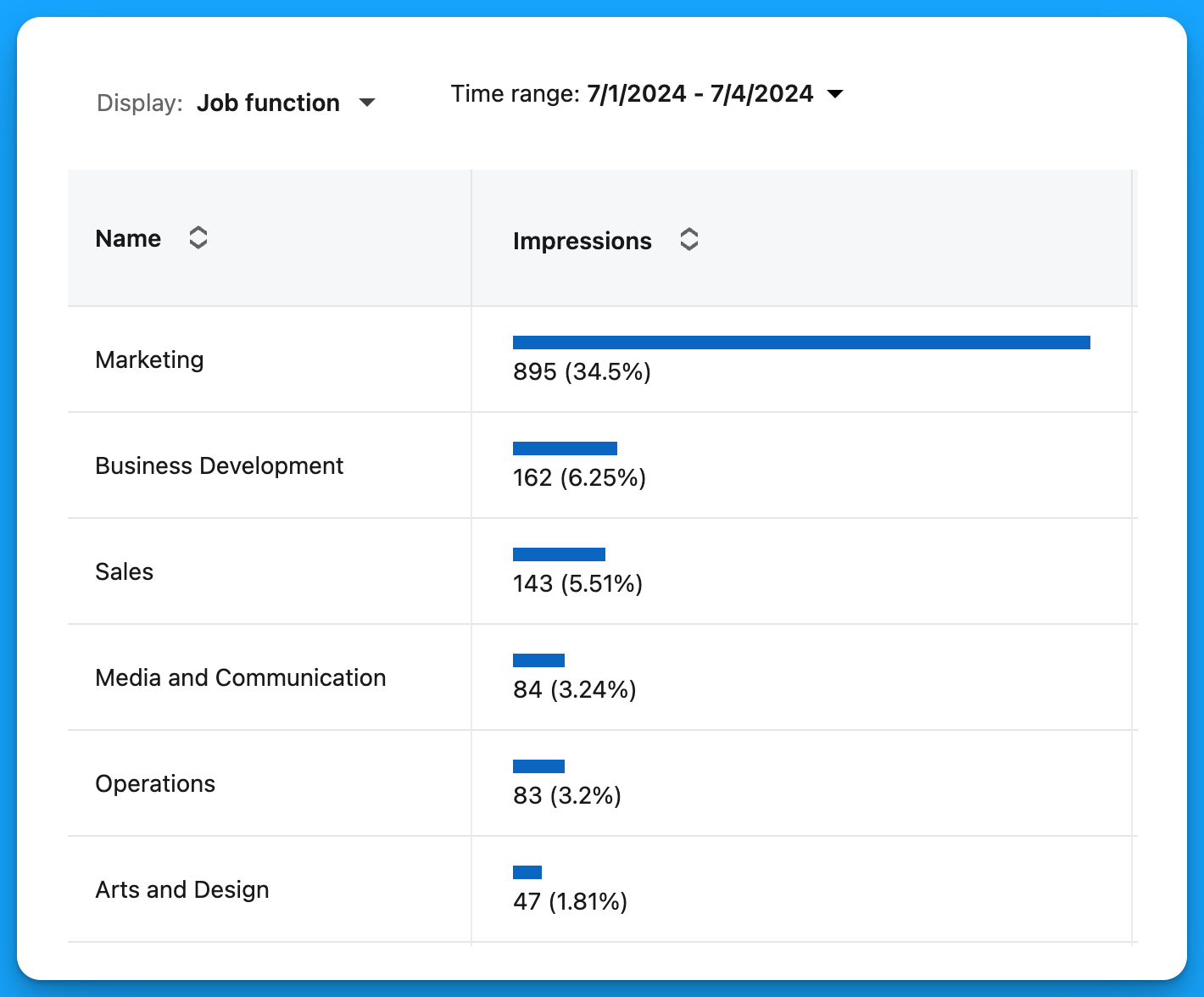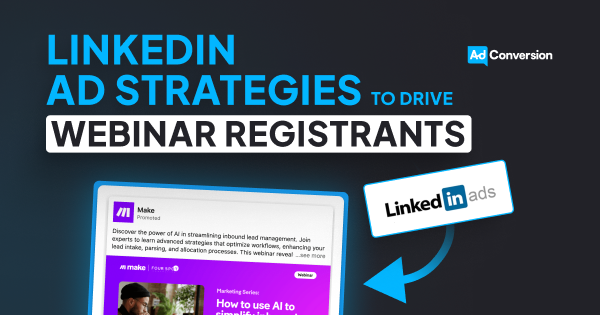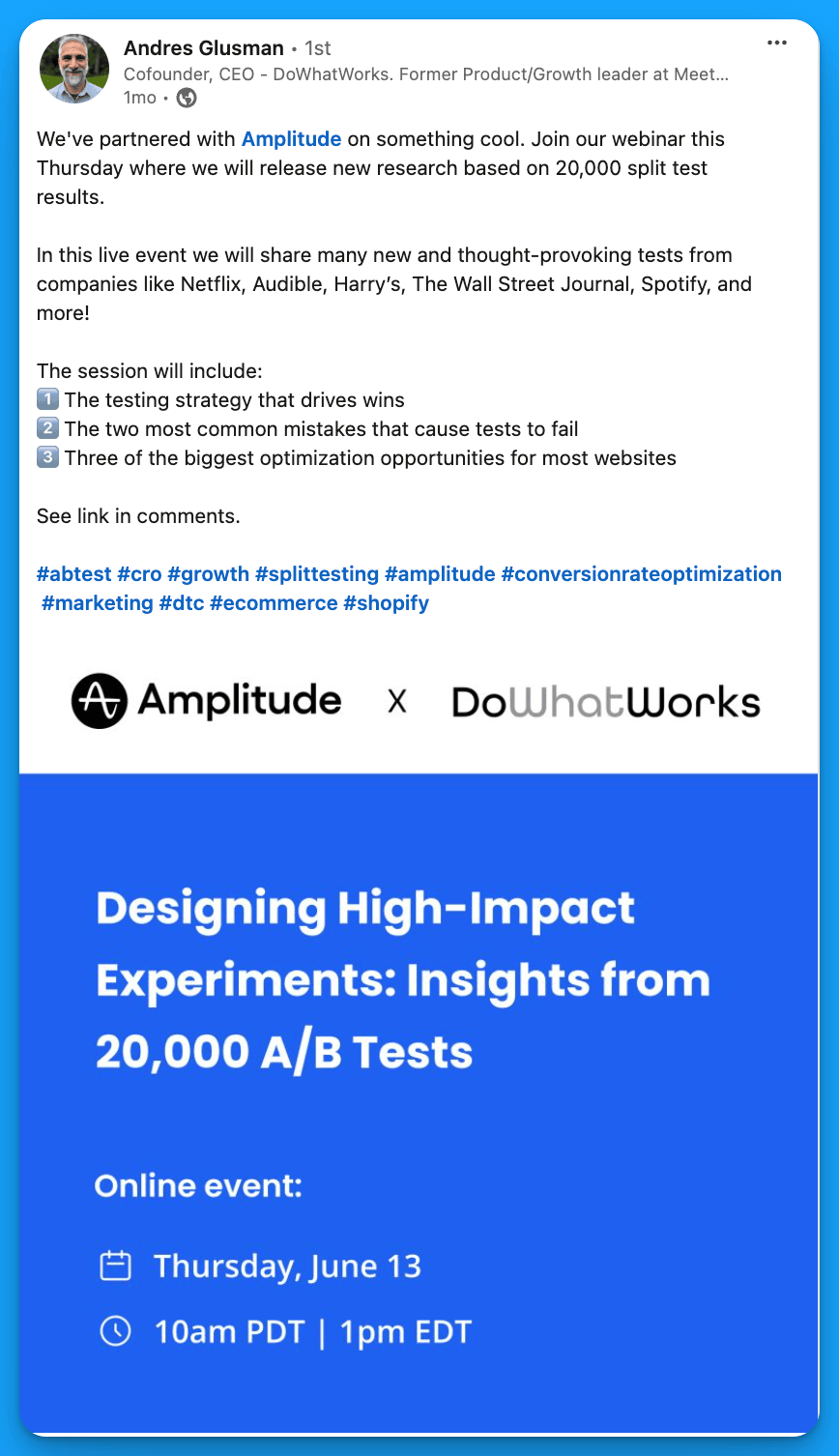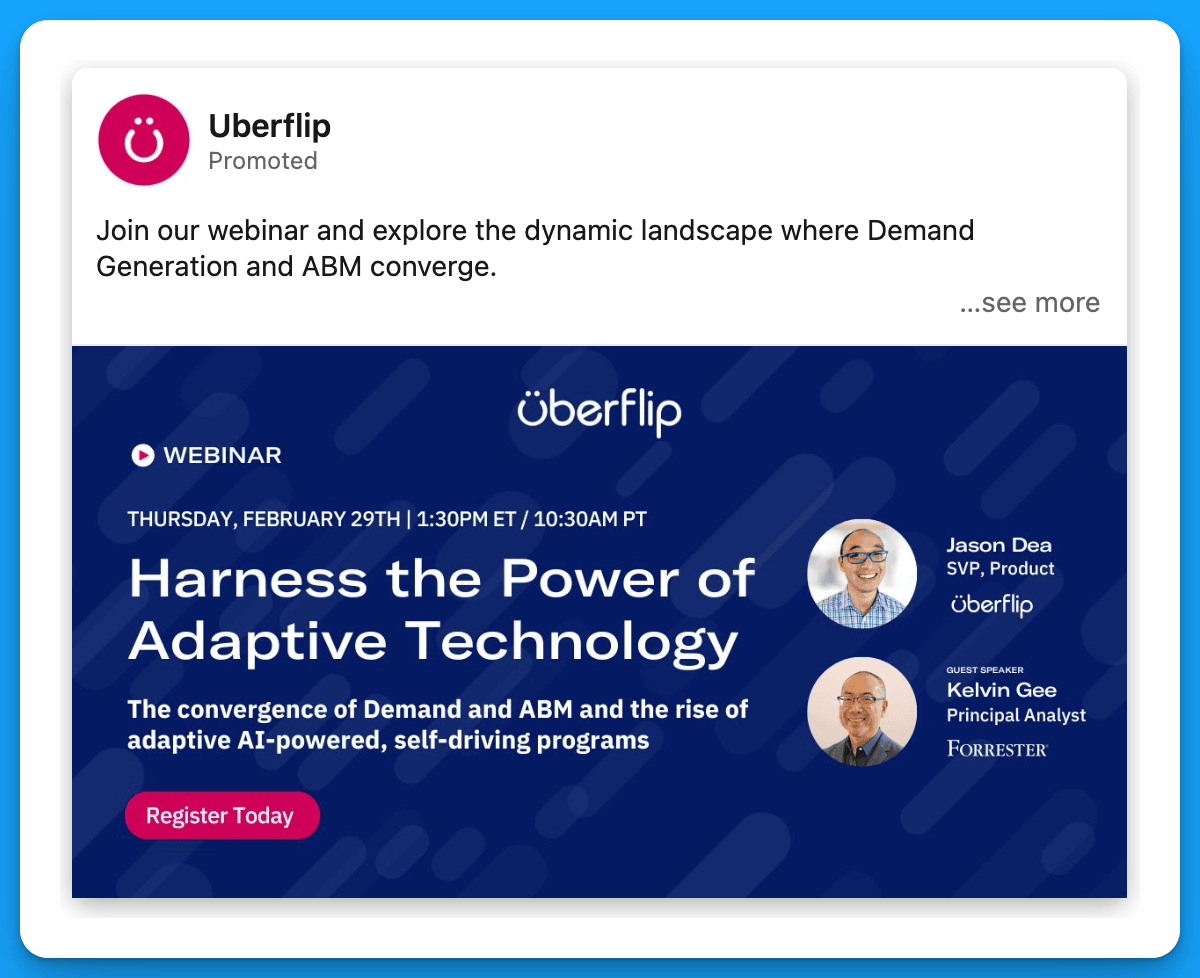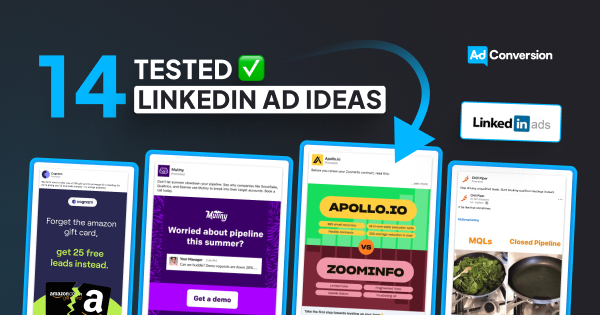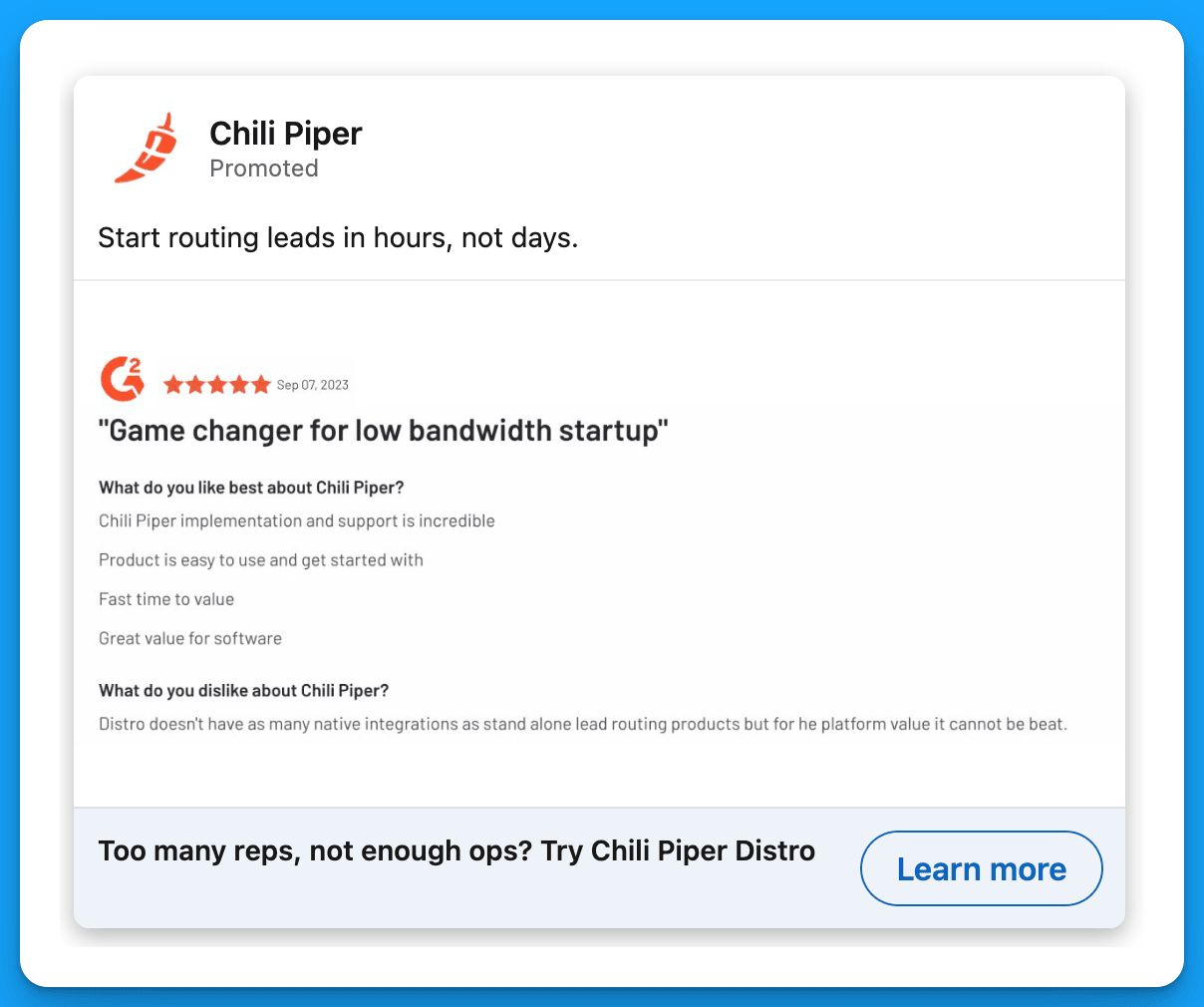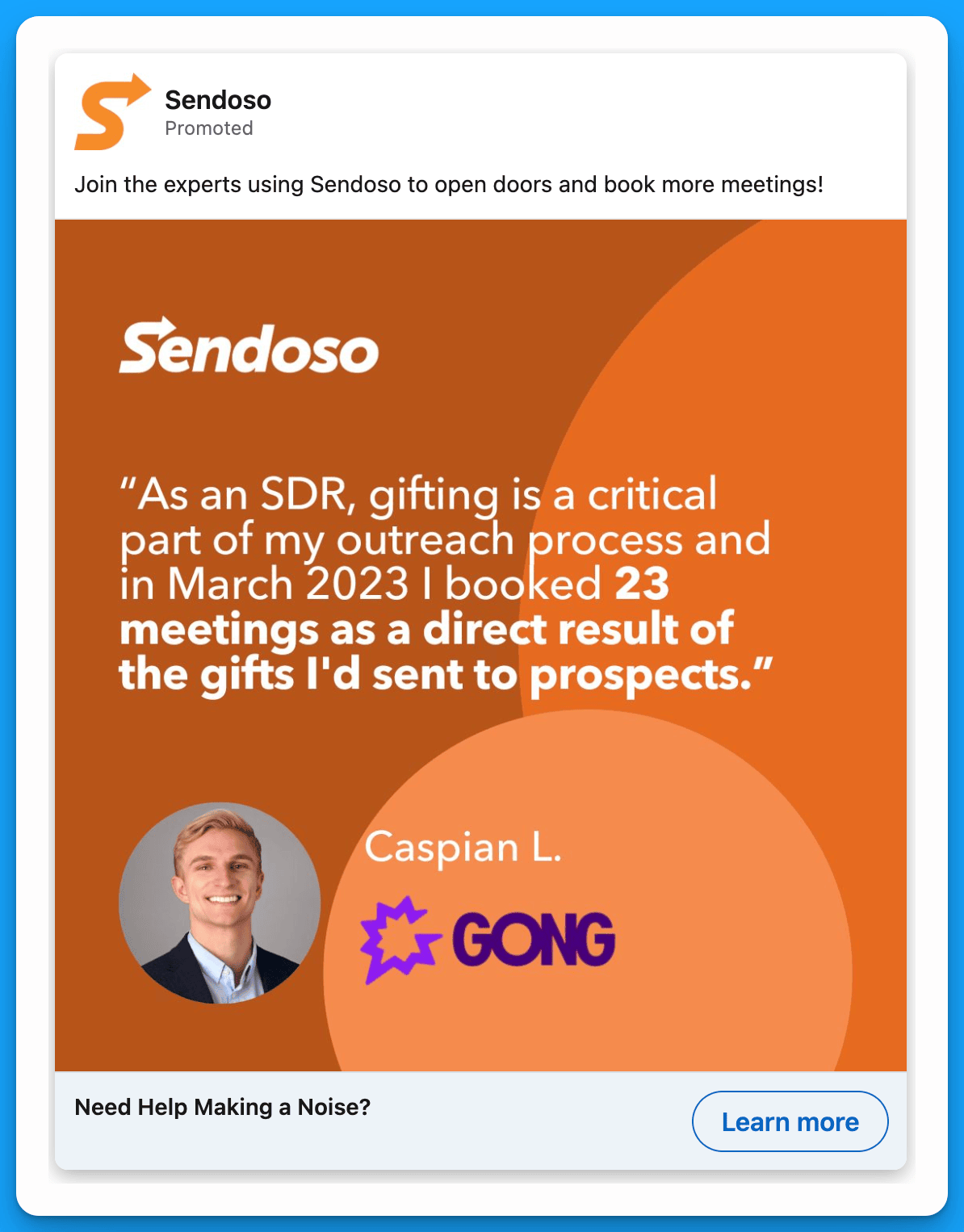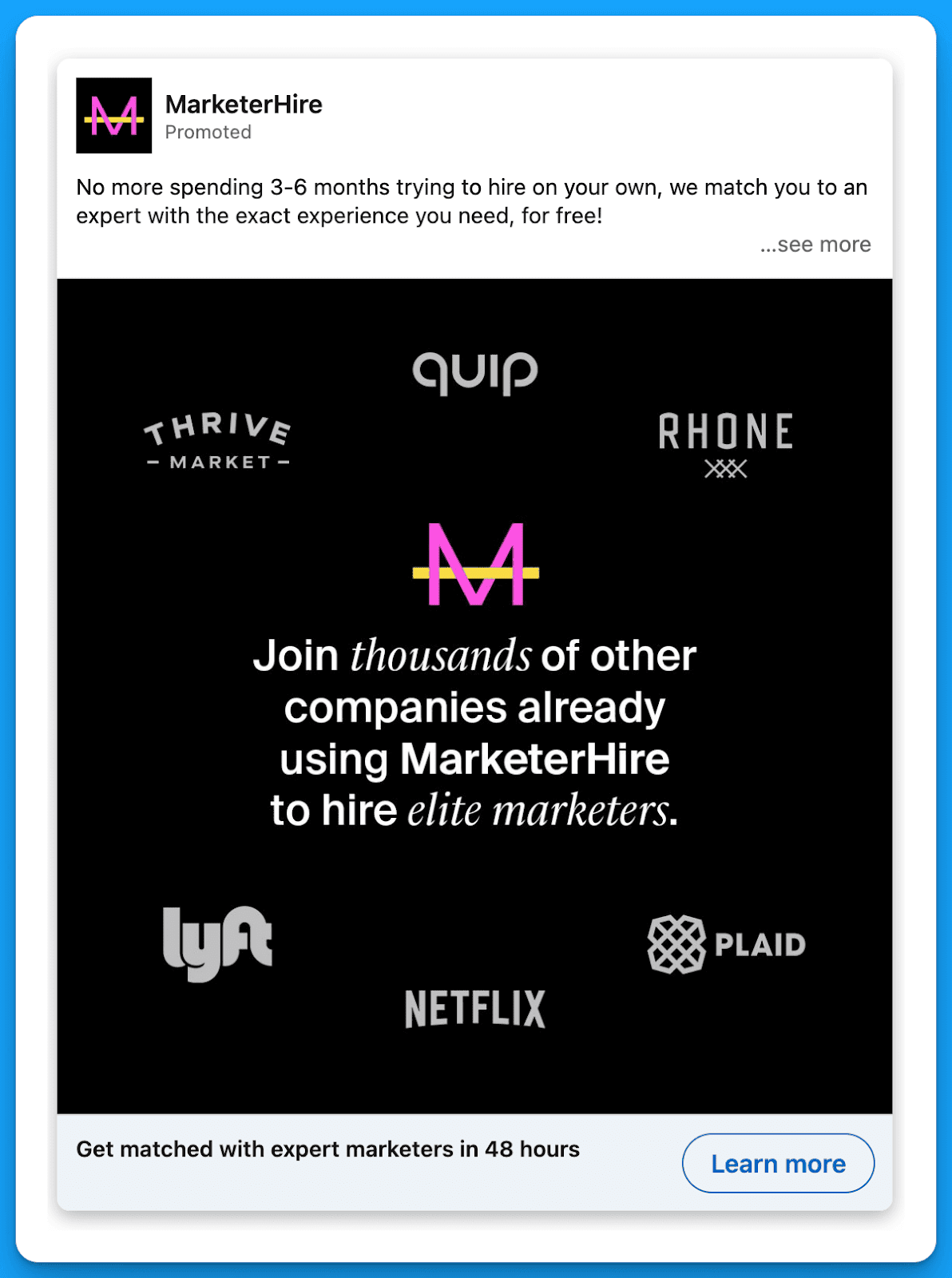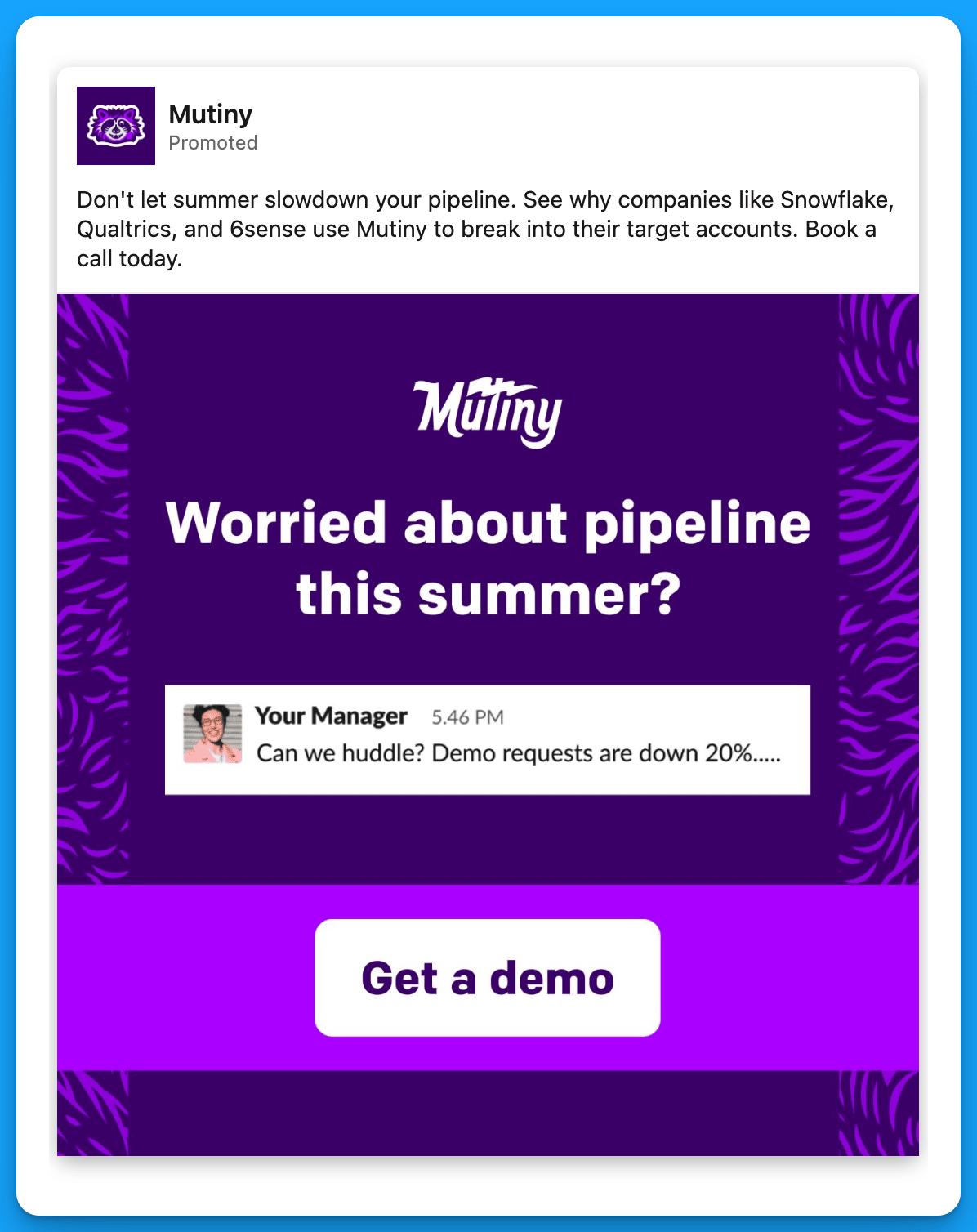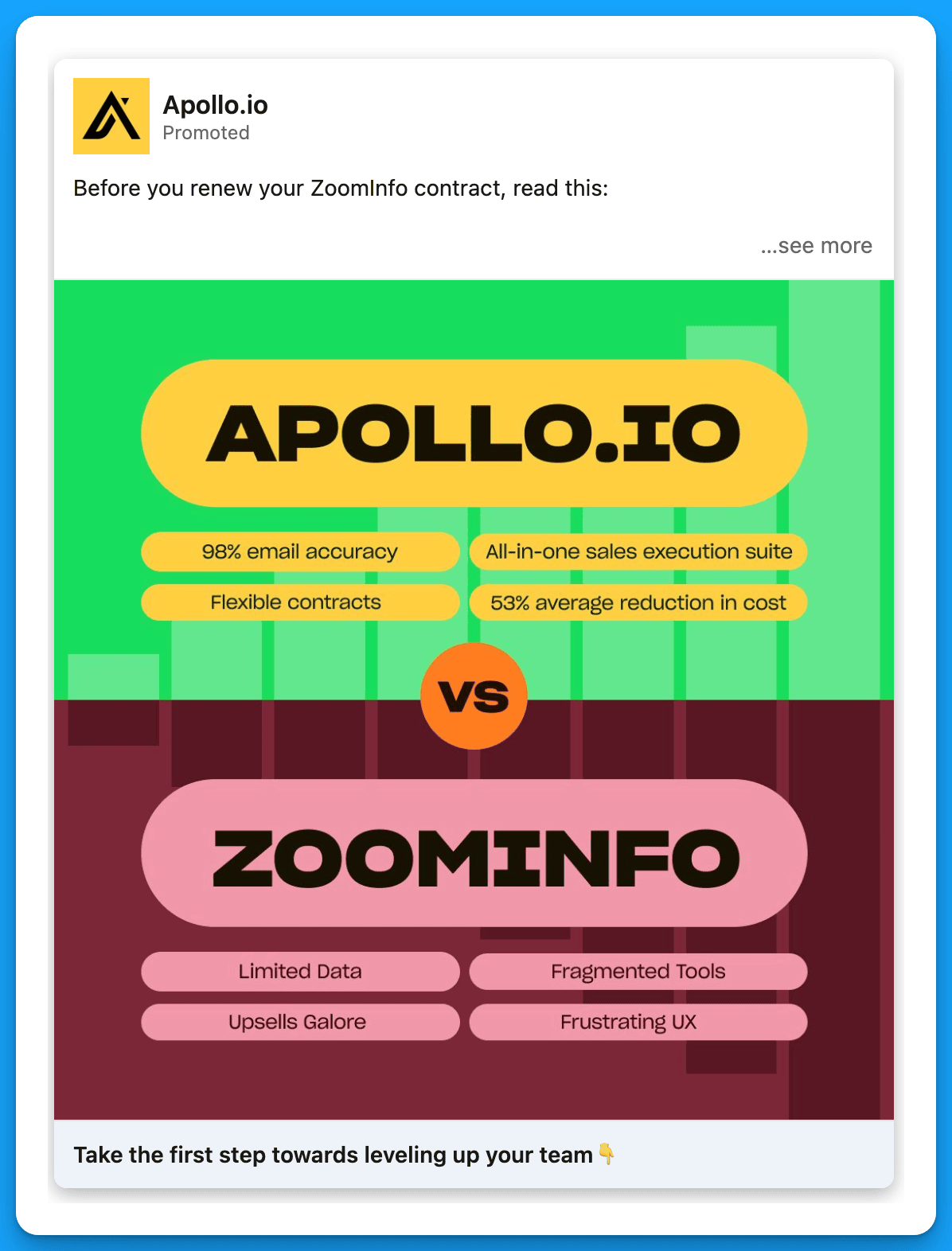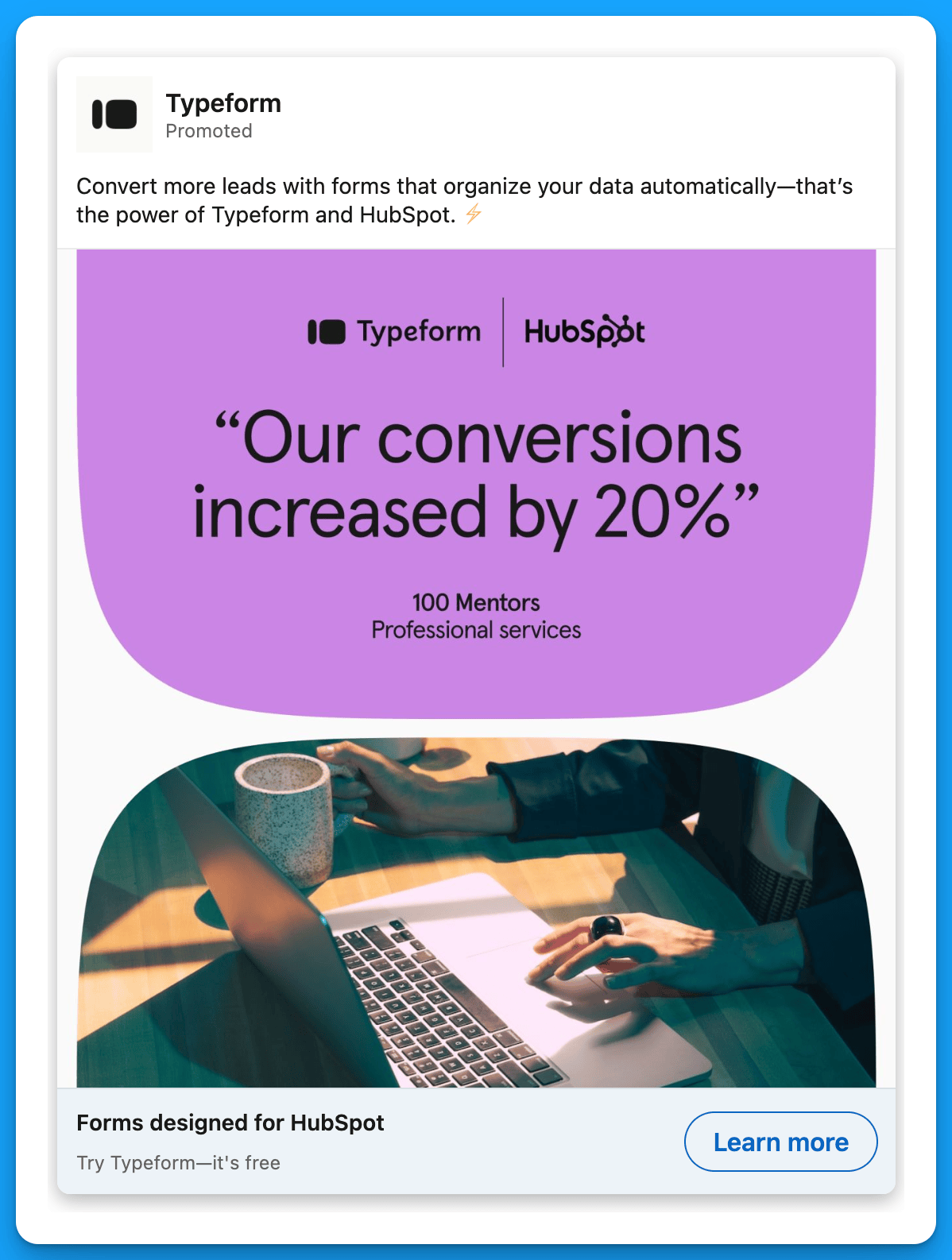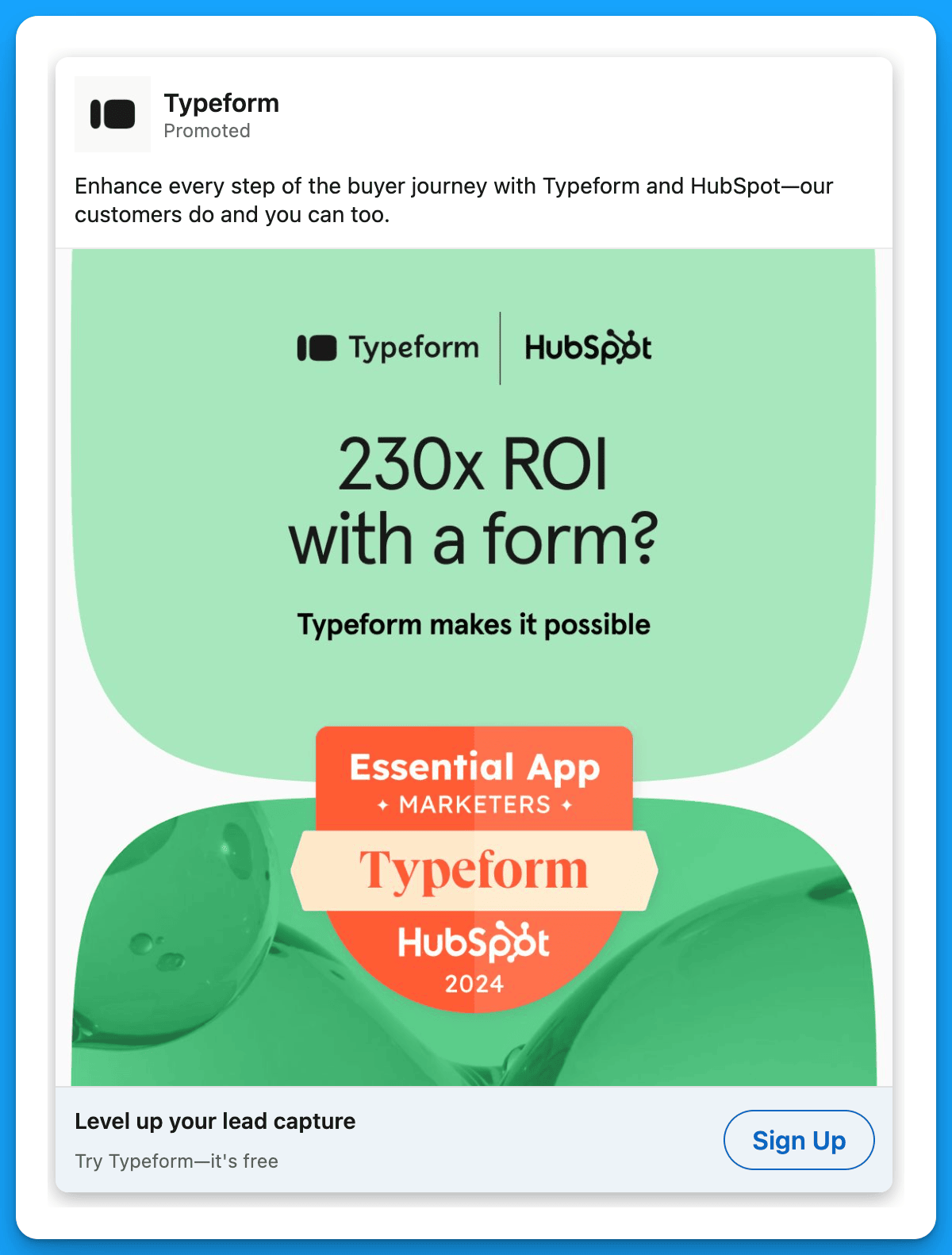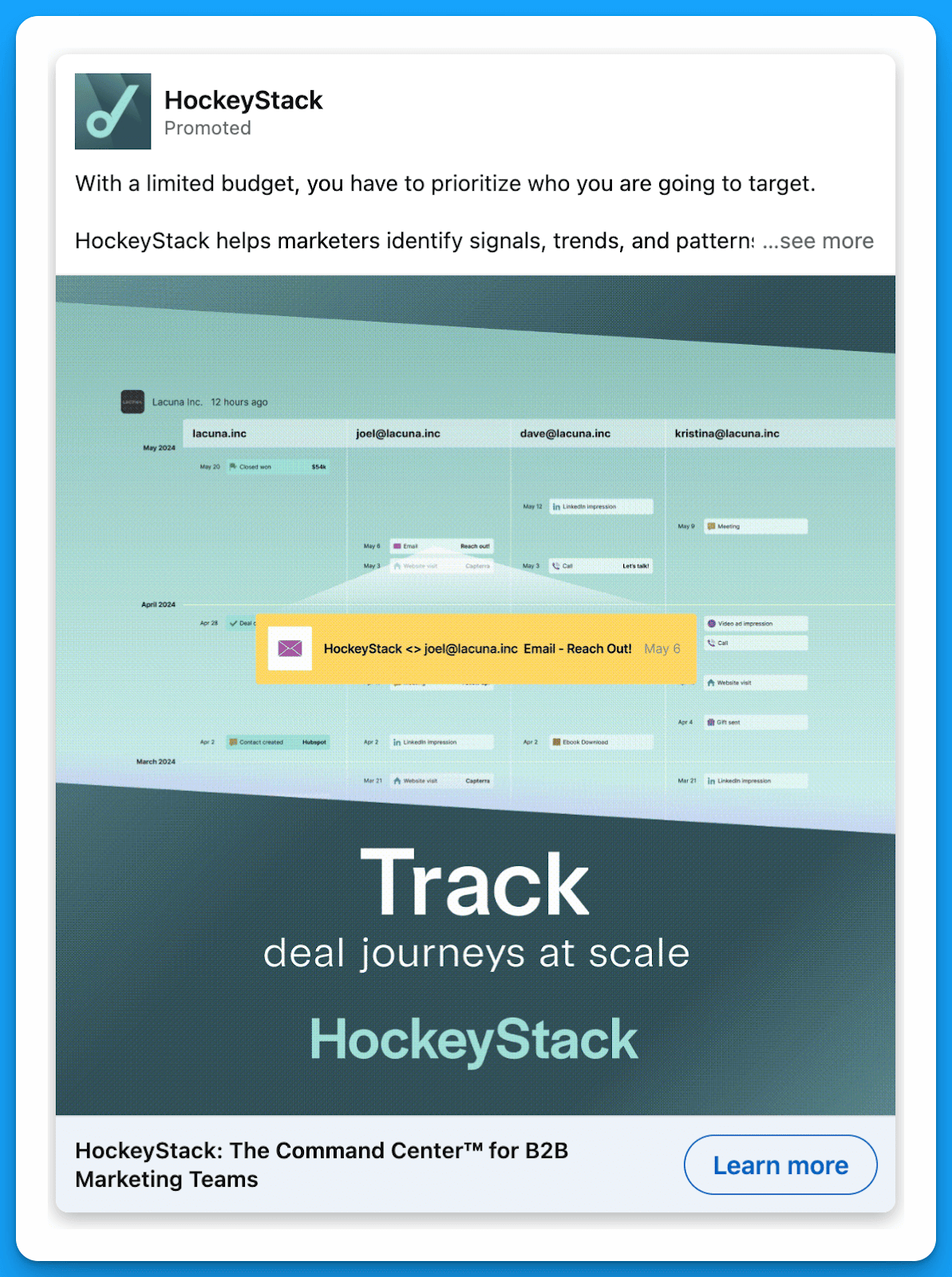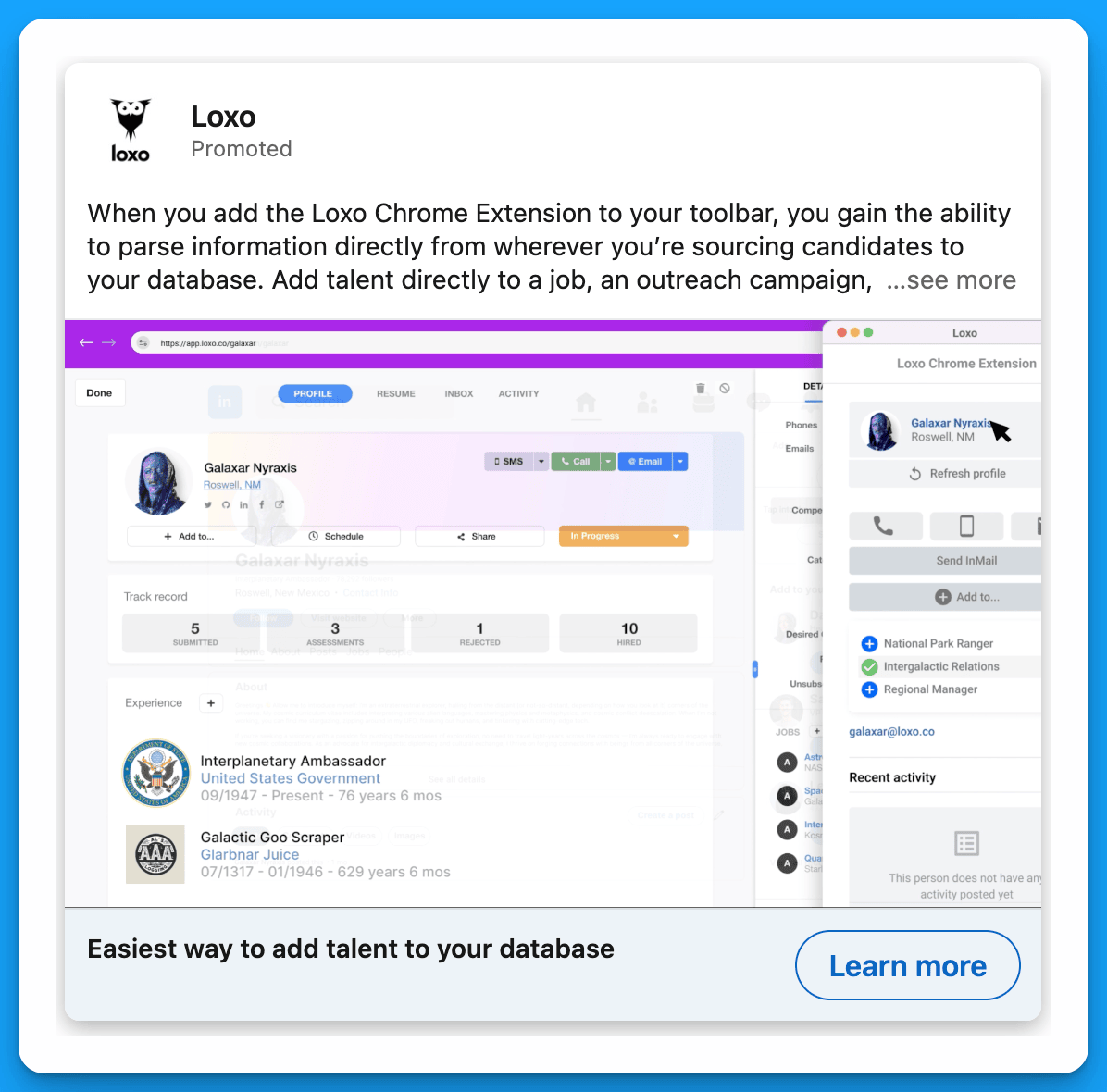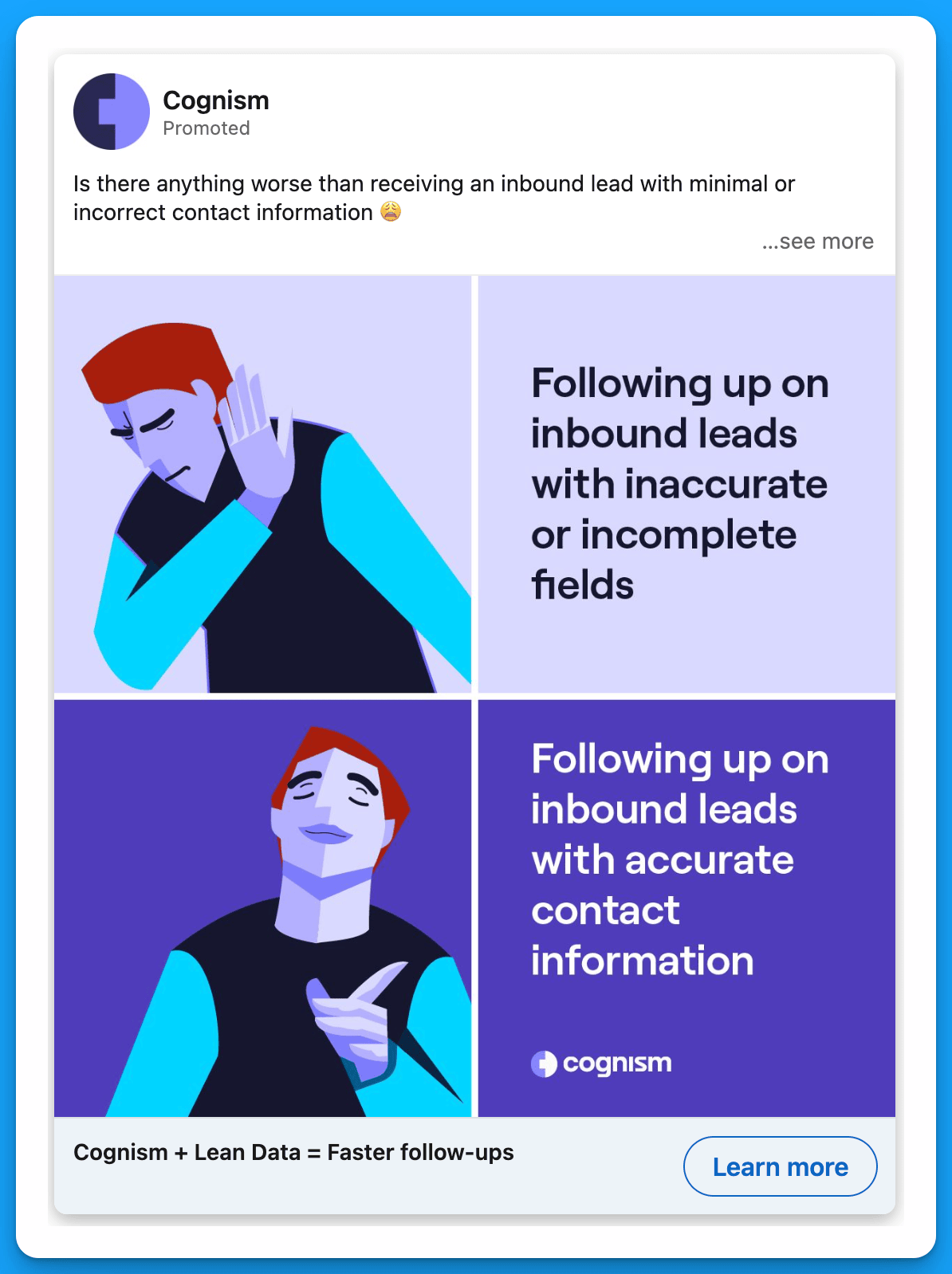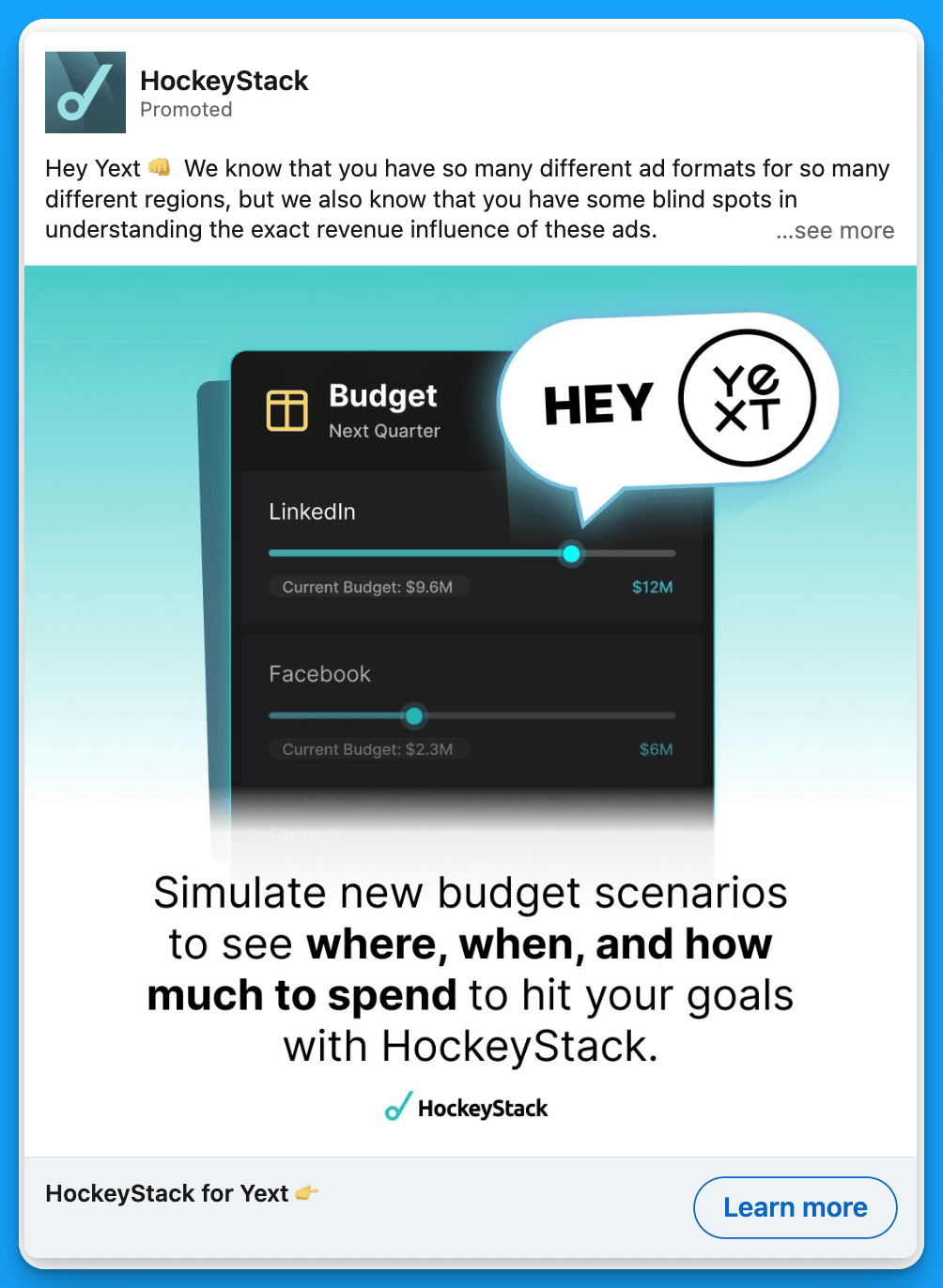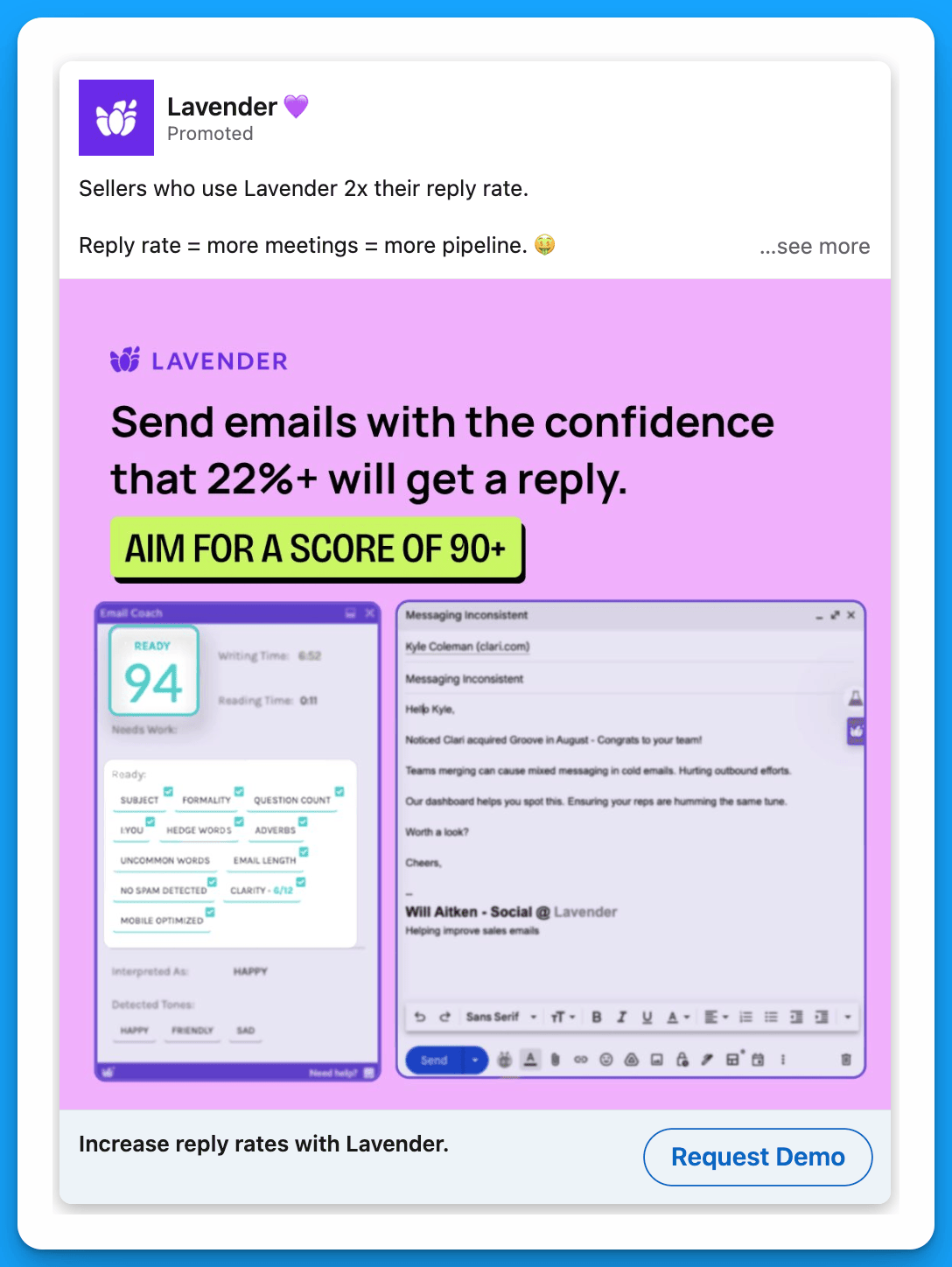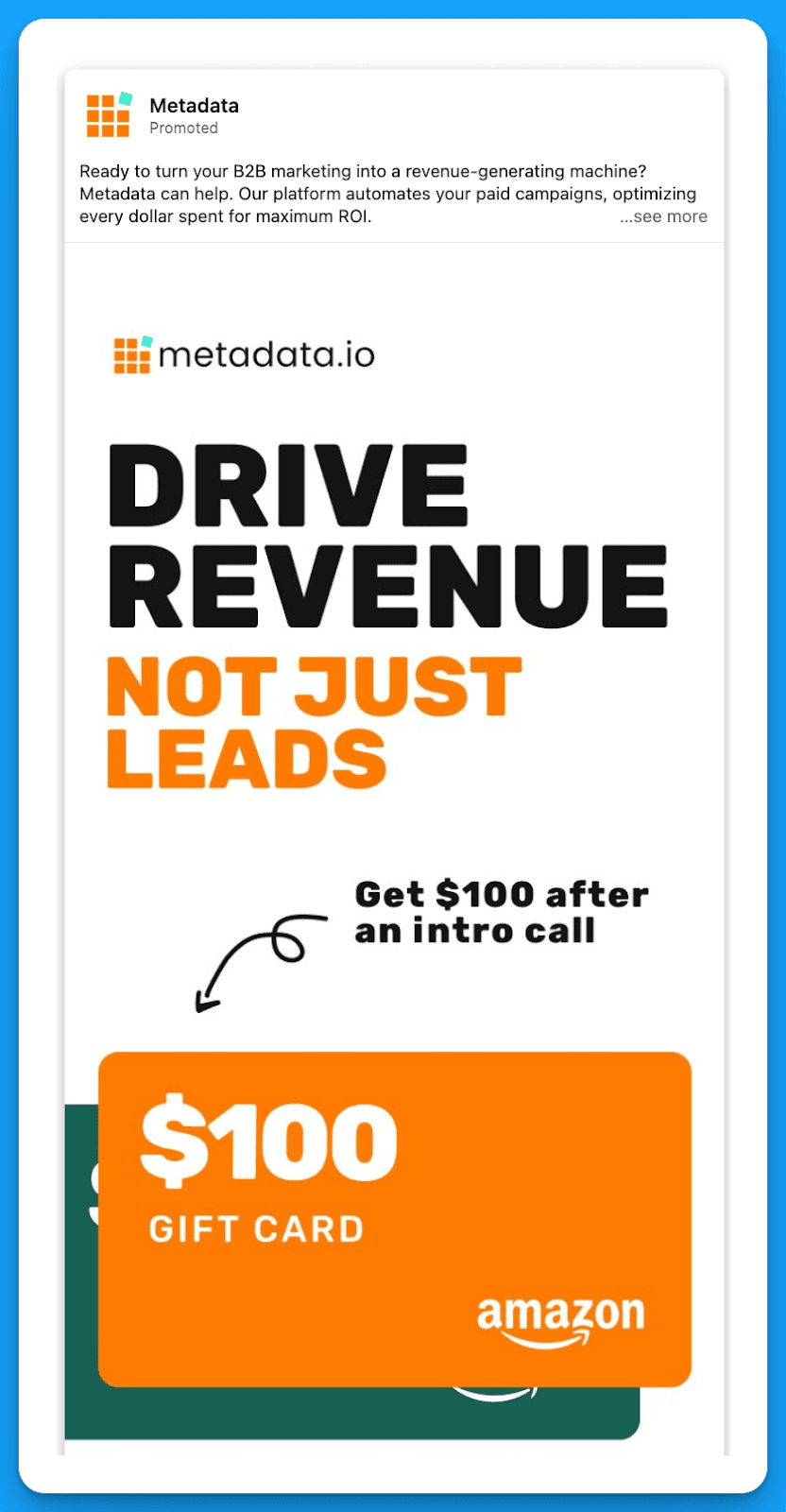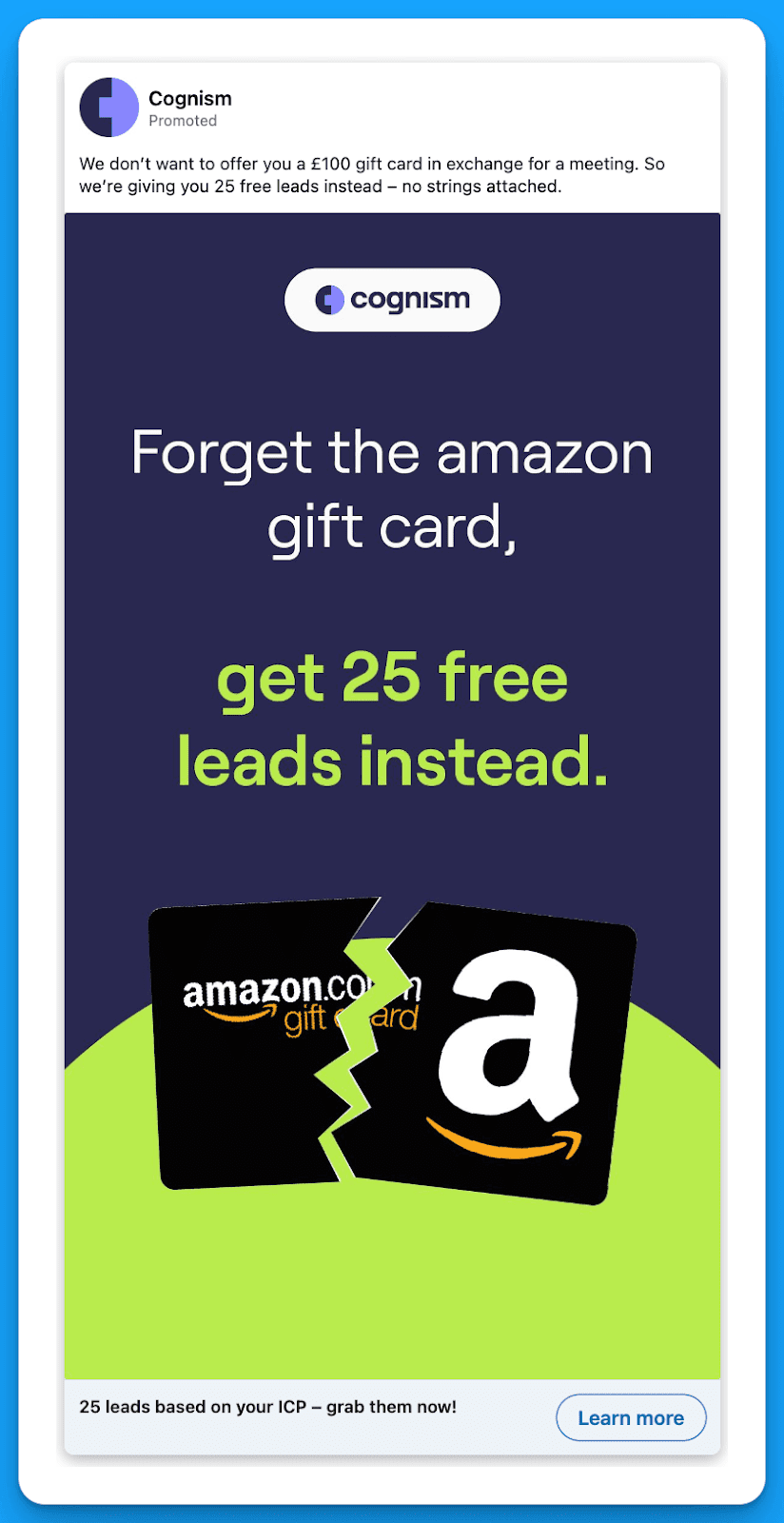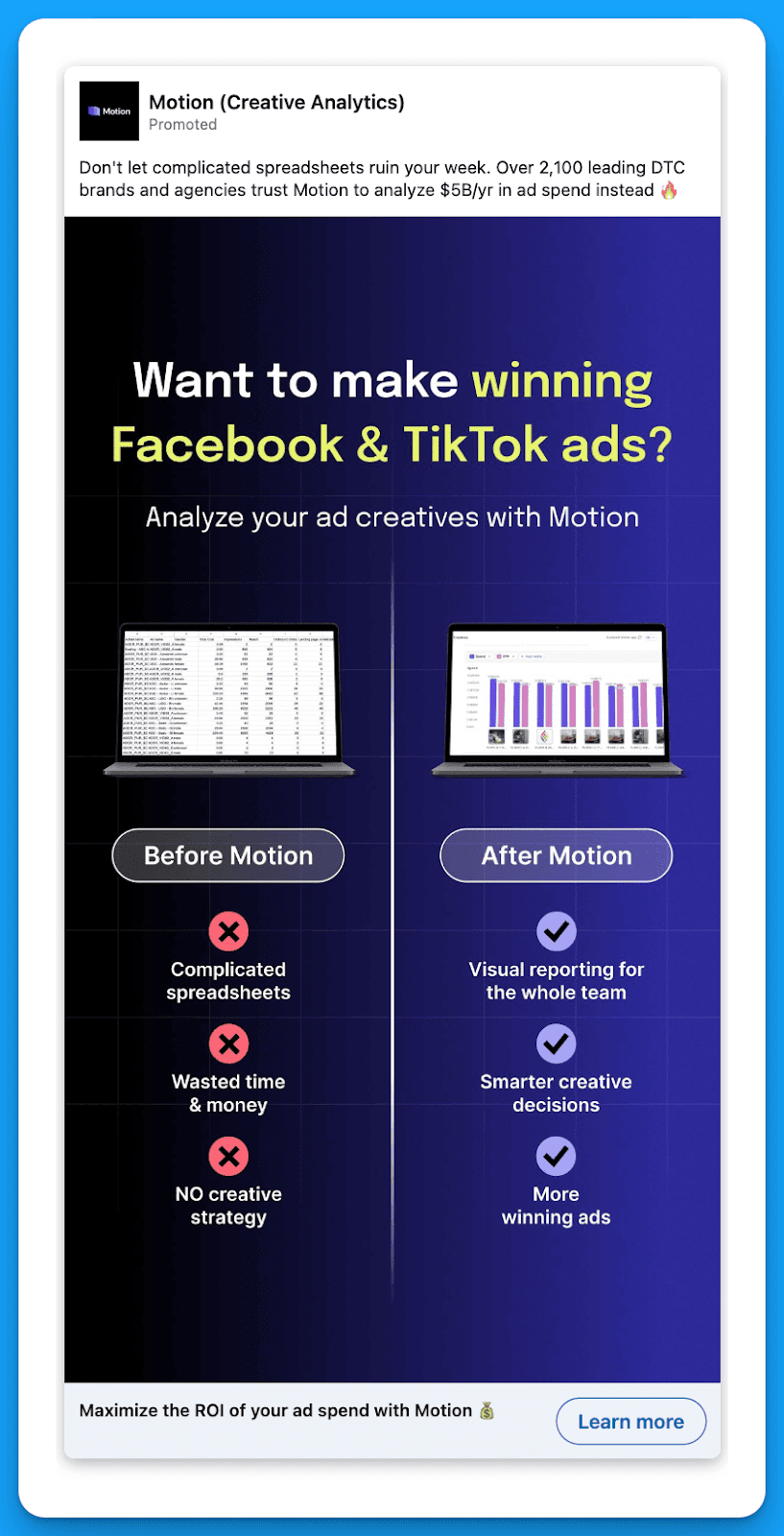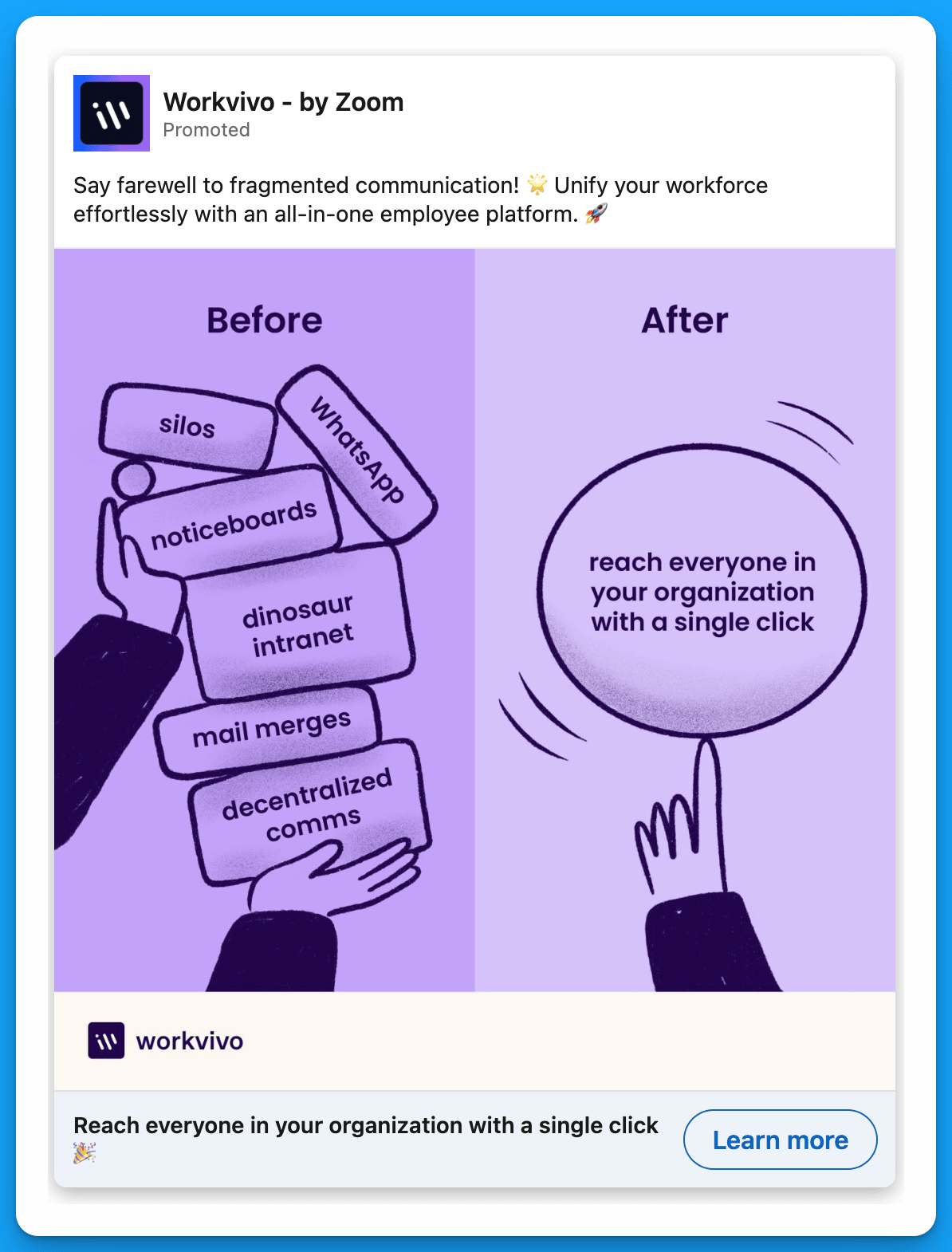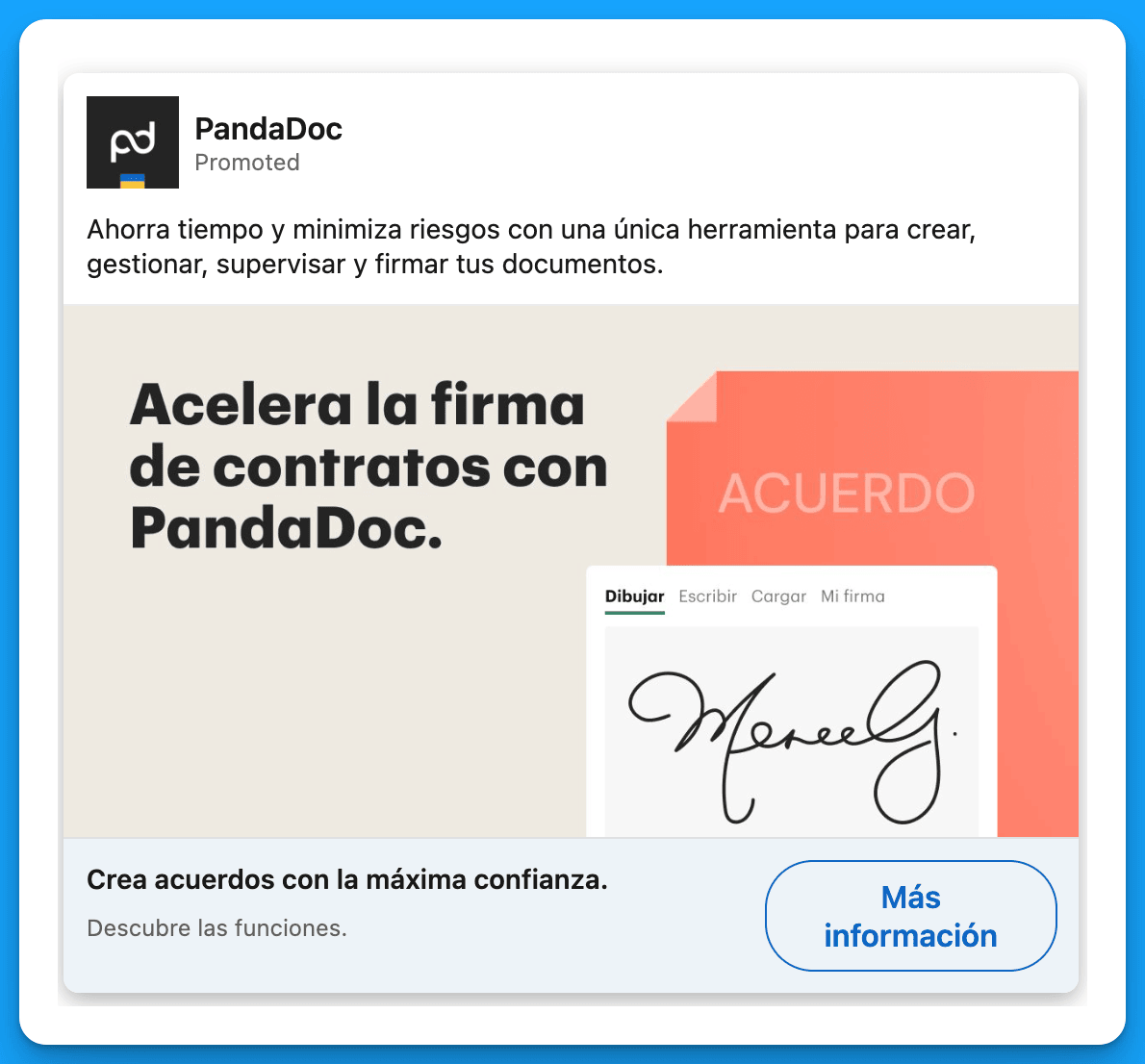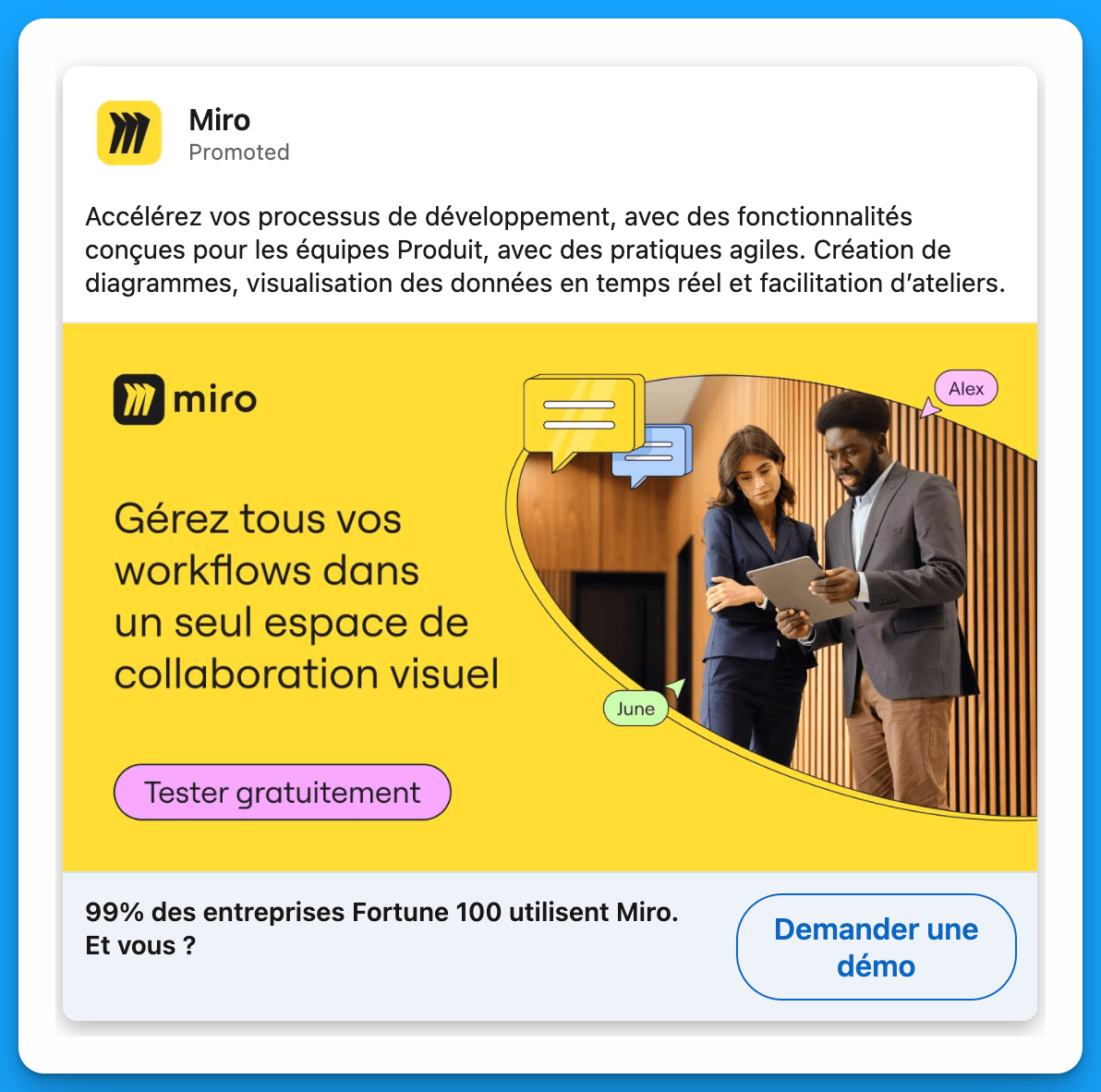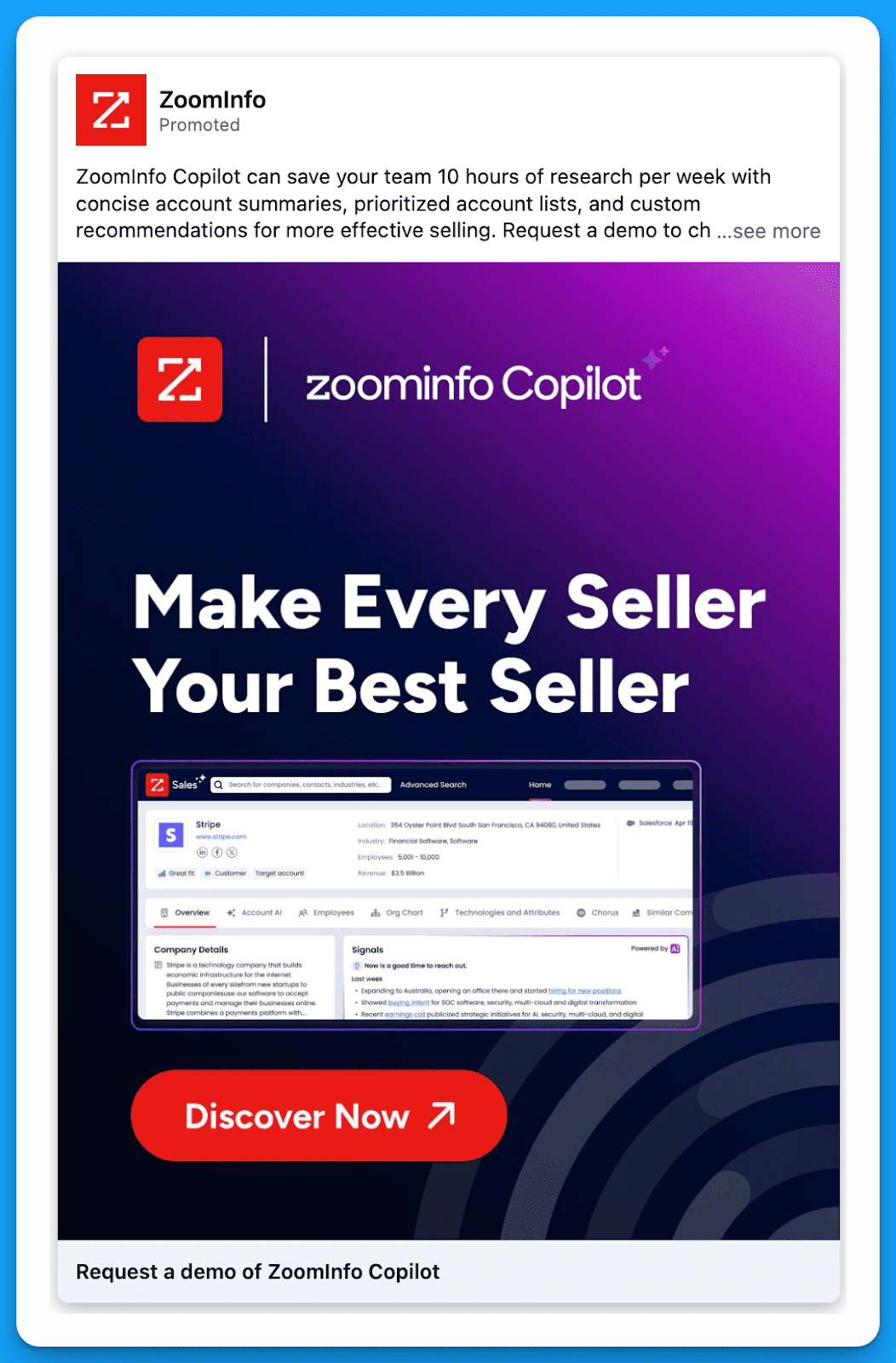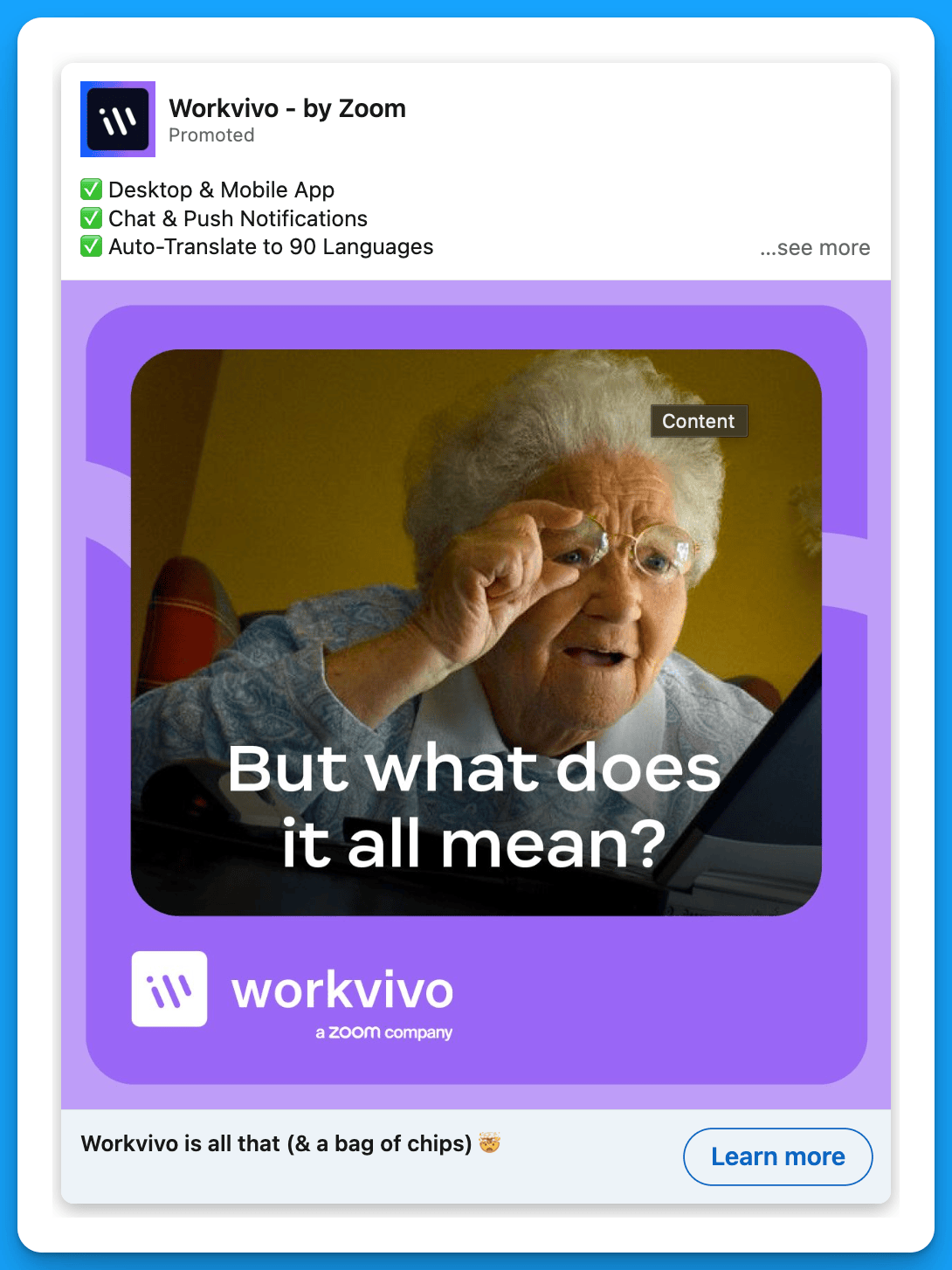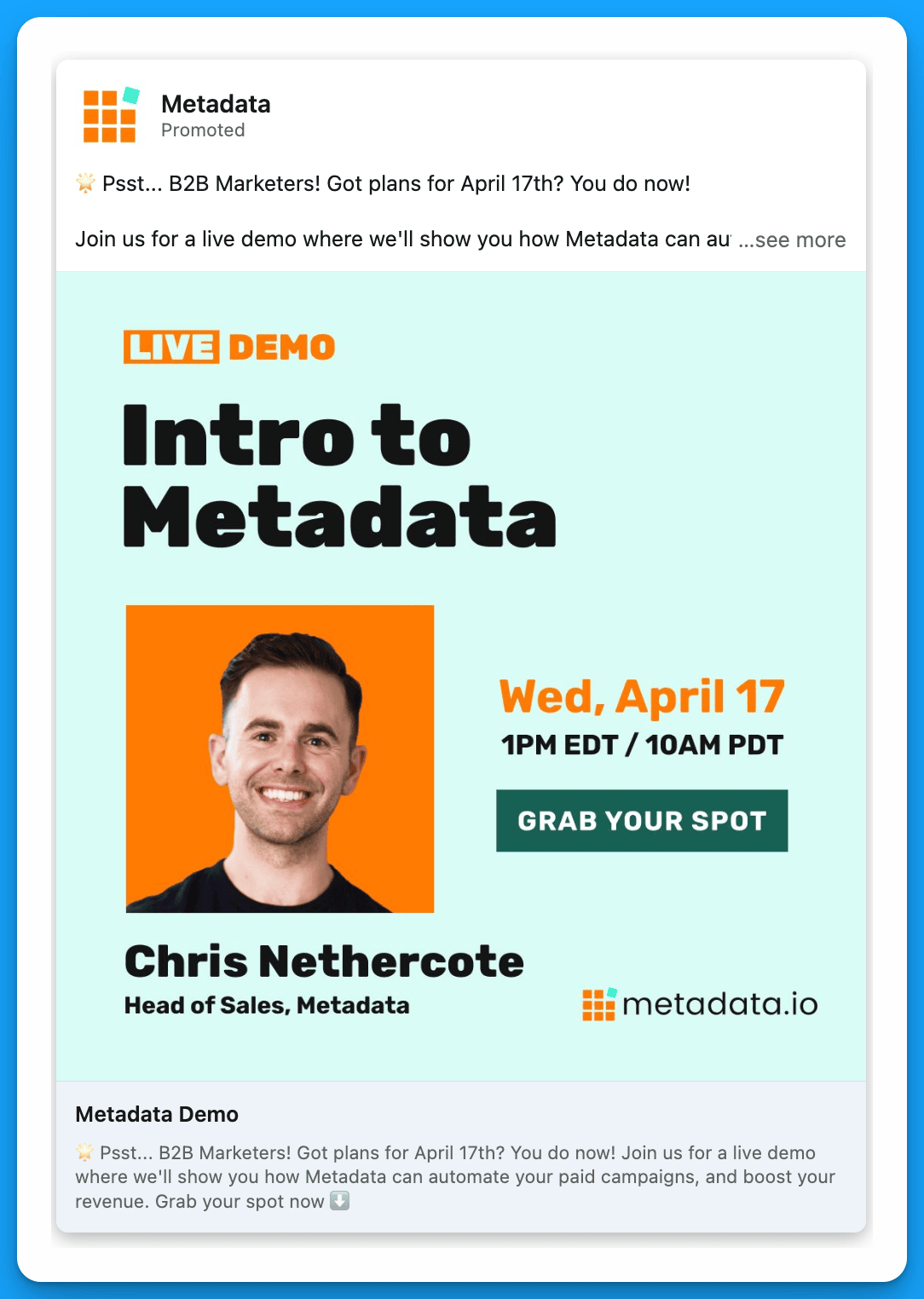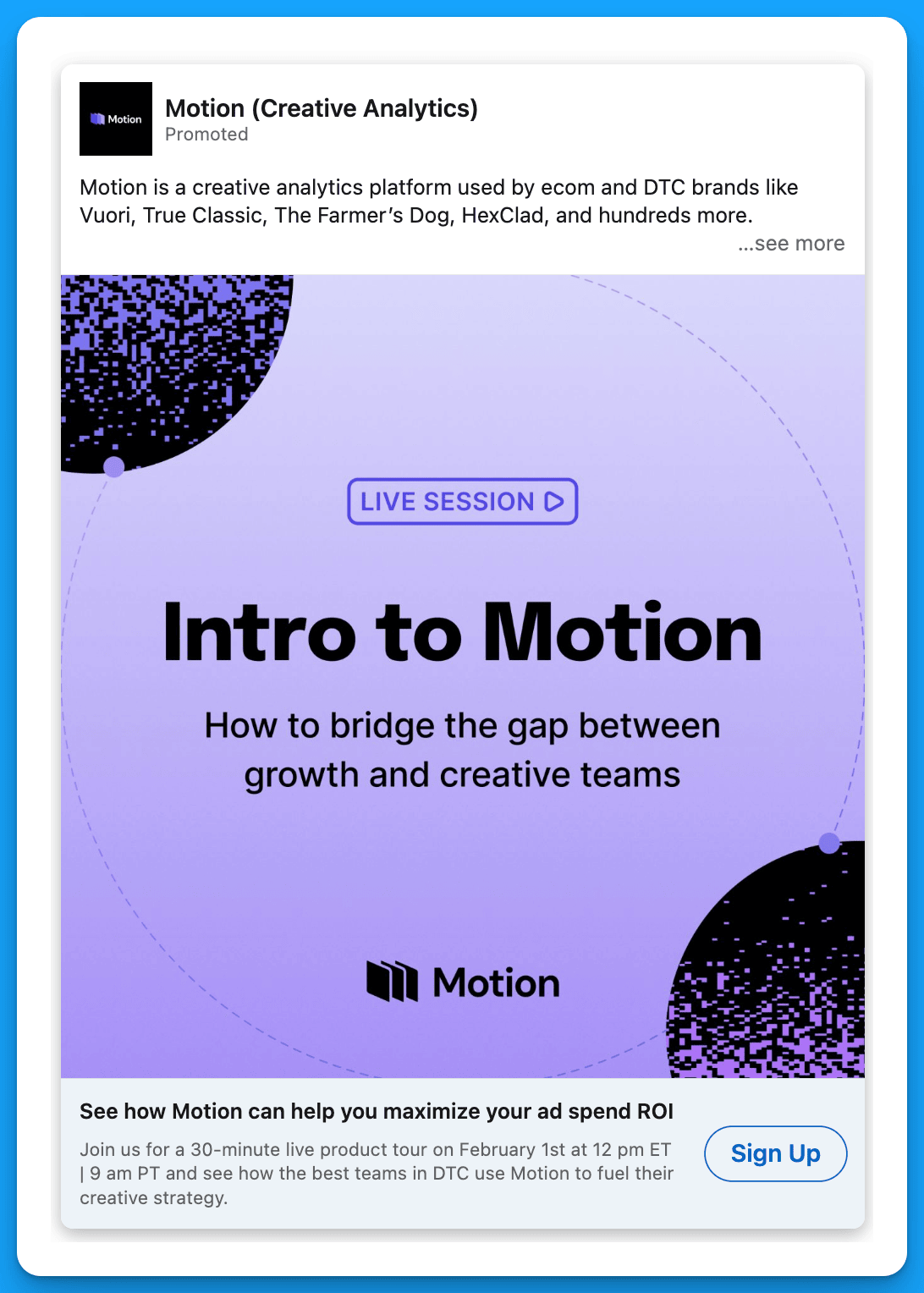
How to Audit B2B Google Ads Accounts [+Free Template]
Google Ads is not getting any cheaper, so frequently auditing your account is critical to keep your campaigns profitable.
In this step-by-step guide, I will walk you through the exact same process we use internally to audit our clients’ Google Ads accounts.
As a bonus, you can get a free copy of my 8-Part Google Ads Audit Checklist from Module 1, Lesson 5 of my B2B Google Ads 102 free course, so you can have it on hand while you go through the tasks below.
So let’s get started 👇
TABLE OF CONTENTS
- Part 1 - Account Review
- Part 2 - Campaign Review
- Part 3 - Ad Group Review
- Part 4 - Keyword Review
- Part 5 - Ads & Extensions Review
- Part 6 - Landing Page Review
- Part 7 - Budget & Performance Review
- Part 8 - Visibility Review
- Resources to Master B2B Google Ads
- Google Ads Audit FAQ
Part 1 - Account Review
First and foremost, you can’t improve your account performance without mastering the basics. So let’s dive in!
1. Billing Information
Is your billing information correct?
Checking this will ensure that your ads continue to run smoothly and you don't face any unexpected billing issues.
To check your billing information, follow these steps:
- Sign in to your Google Ads account.
- Click on the "Billing" icon on the left-hand menu.
- Click on "Settings" to view your current billing information.

Here, you can view your payment method, payer details (name, address, etc), and other important details.
Make sure all the information is correct and up-to-date. If you notice any errors, click on the pencil next to each detail to make the necessary changes.
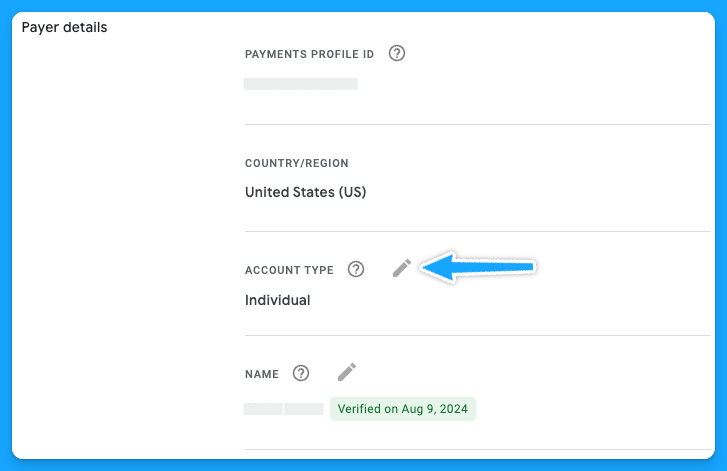
It's important to note that any changes you make to your billing information may take up to 24 hours to take effect.
Additionally, if you have any pending charges on your account, you won't be able to make changes until those charges are paid off.
2. Is your time zone correct?
The accuracy of your account's time zone setting is more crucial than it may seem at first glance. The time zone affects how you schedule ads, interpret performance data, and manage billing cycles.
You cannot change your time zone manually, and it can only be reset once, so as Google advises, choose your new time zone carefully.
To request a change, you’ll need to fill out this form and follow the instructions below:
- The form must be filled out by an Admin user of a manager account.
- Your time zone can only be shifted eastward, for example, from GTM (Greenwich Mean Time) to IST (India Standard Time).
3. Do you have auto-tagging turned on?
Auto-tagging is an easy 3-step process:
- Sign in to your Google Ads account
- On the left-hand side, under admin> click on Account Settings
- Click on “Auto-tagging” - check the box and save.
Once you enable this feature, Google will automatically mark your source_medium as “cpc”
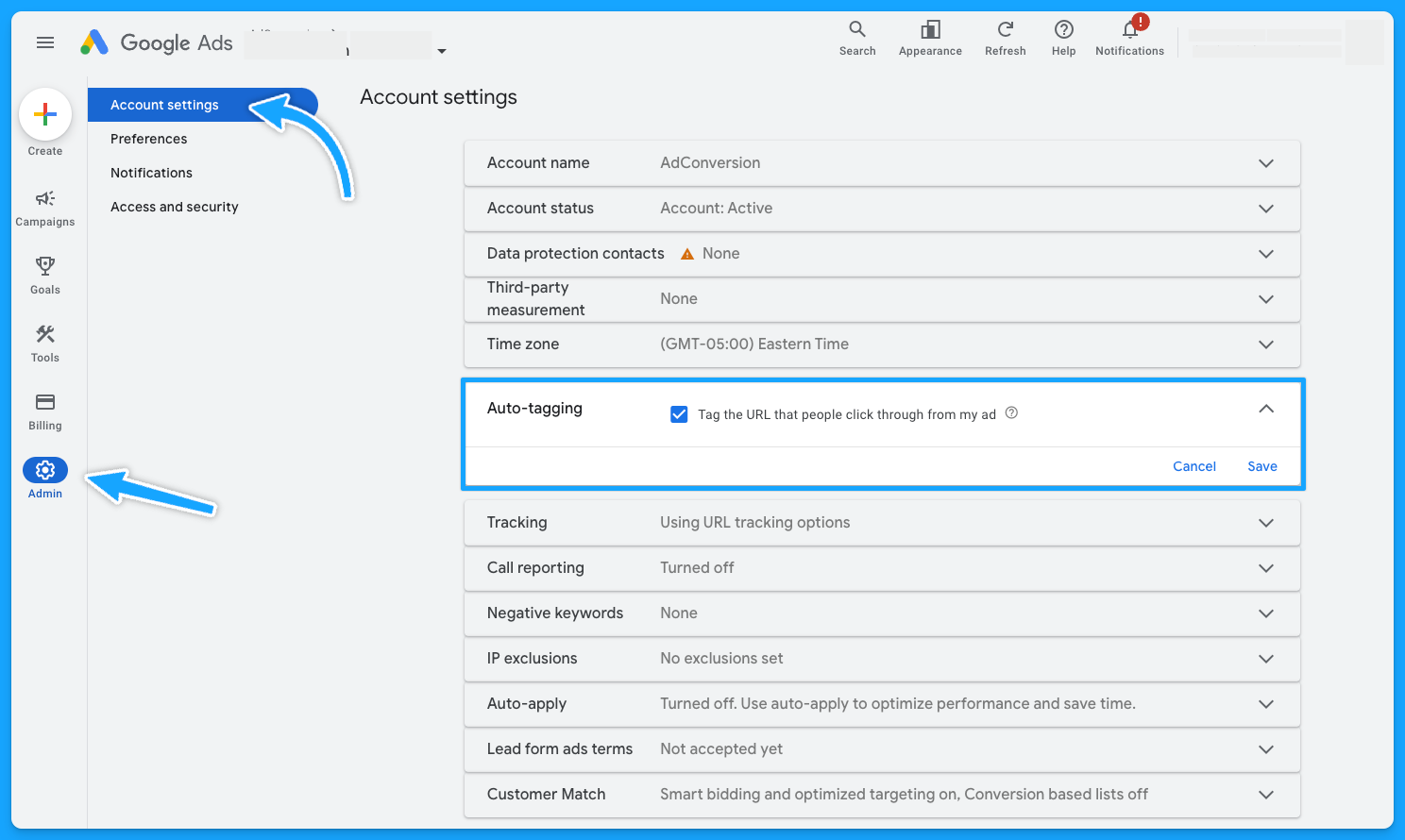
4. Did you turn off ad suggestions?
Have you ever gone to your Google Ads account and noticed a bunch of changes that weren’t made by you or anyone on your team?This probably happened because you didn’t turn off the ad suggestions 😅
So follow these steps to have peace of mind:
- Sign in to your Google Ads account.
- Click on the "Campaigns" on the left-hand menu.
- Click on "Recommendations" and go to “Auto-apply”
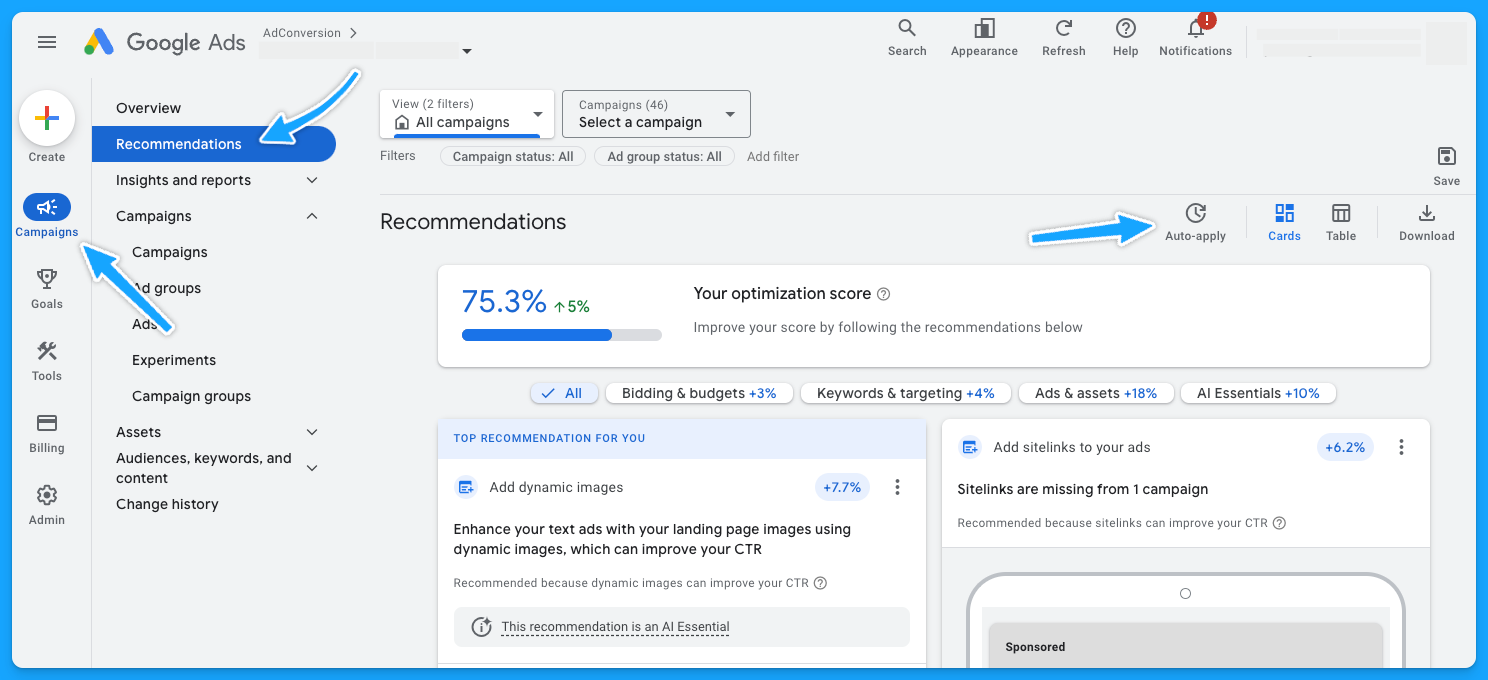
Make sure you turn off all of the recommendations that aren’t relevant to your account.
I personally like to turn off all of them, so I don’t have any changes made by Google without my consent.
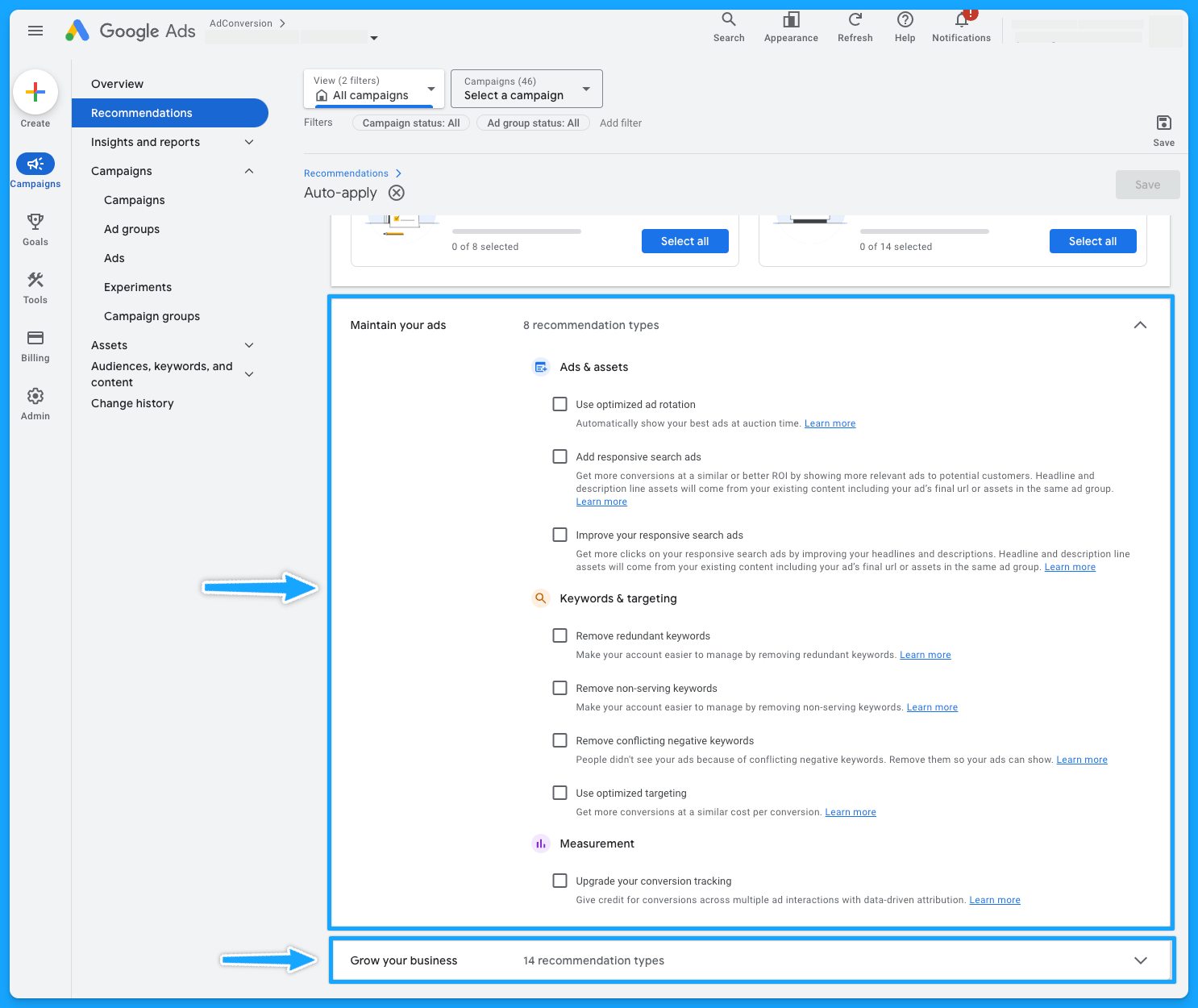
5. Is your conversion tracking still working accurately?
This is crucial because if your conversion tracking is not working correctly, you won’t feed Google’s algorithm with essential data to make the best bidding choices for your conversion-based strategies.
Here’s how you can check if your tracking is in place:
- Sign in to your Google Ads account.
- Click on the "Goals" on the left-hand menu.
- Click on "Conversions" and go to “Summary”
- You’ll be able to see the status of your conversions - you want to see “Active”
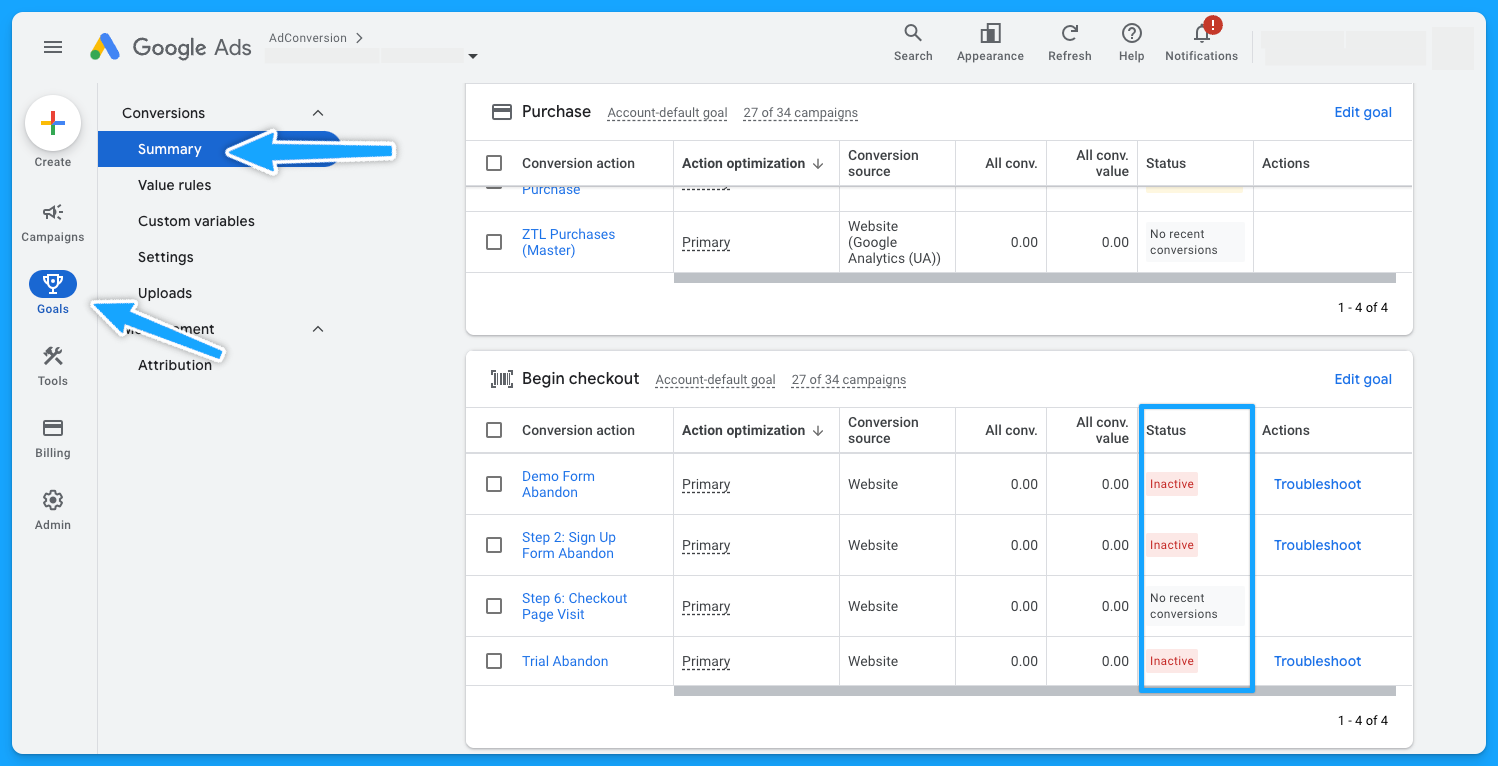
Pro-tip: If you see the status “No recent conversions” - search for your keyword on Google and submit a test.
If you don’t see any activity and have been running Google Ads campaigns for a while, it probably means you’ll need to see what’s going on to ensure the tracking setup is in place.
Part 2 - Campaign Review
Depending on the size and organization of the account, this step will take longer or shorter. So let’s go 👷♂️
1. Do your campaigns follow a logical naming convention?
Having a solid naming convention in place isn’t just about aesthetics, it’s the foundation for good account management.
My campaigns usually have a naming convention that follows this structure:
- Region (NA, EMEA, APAC)
- Campaign Theme (Brand, NonBrand, Generic, Competitor)
- Keyword Topic
- Network (Search, Display)
- Keyword Match Type (Exact, Phrase, Broad)
- Device (Desktop, Mobile, All Devices)
- Offer (Demo, Trial, etc)

So if you have disjointed campaign names, it’s an opportunity to adjust that and make your life easier.
2. Are you targeting the right networks (display unchecked)?
You want to focus on the Search Network and search partners, avoiding the Display Network unless it’s a separate campaign.
- Select the desired campaign
- Go to “Campaign Settings” (on the right-hand side)
- Click on Networks
- Choose the desired Network and save
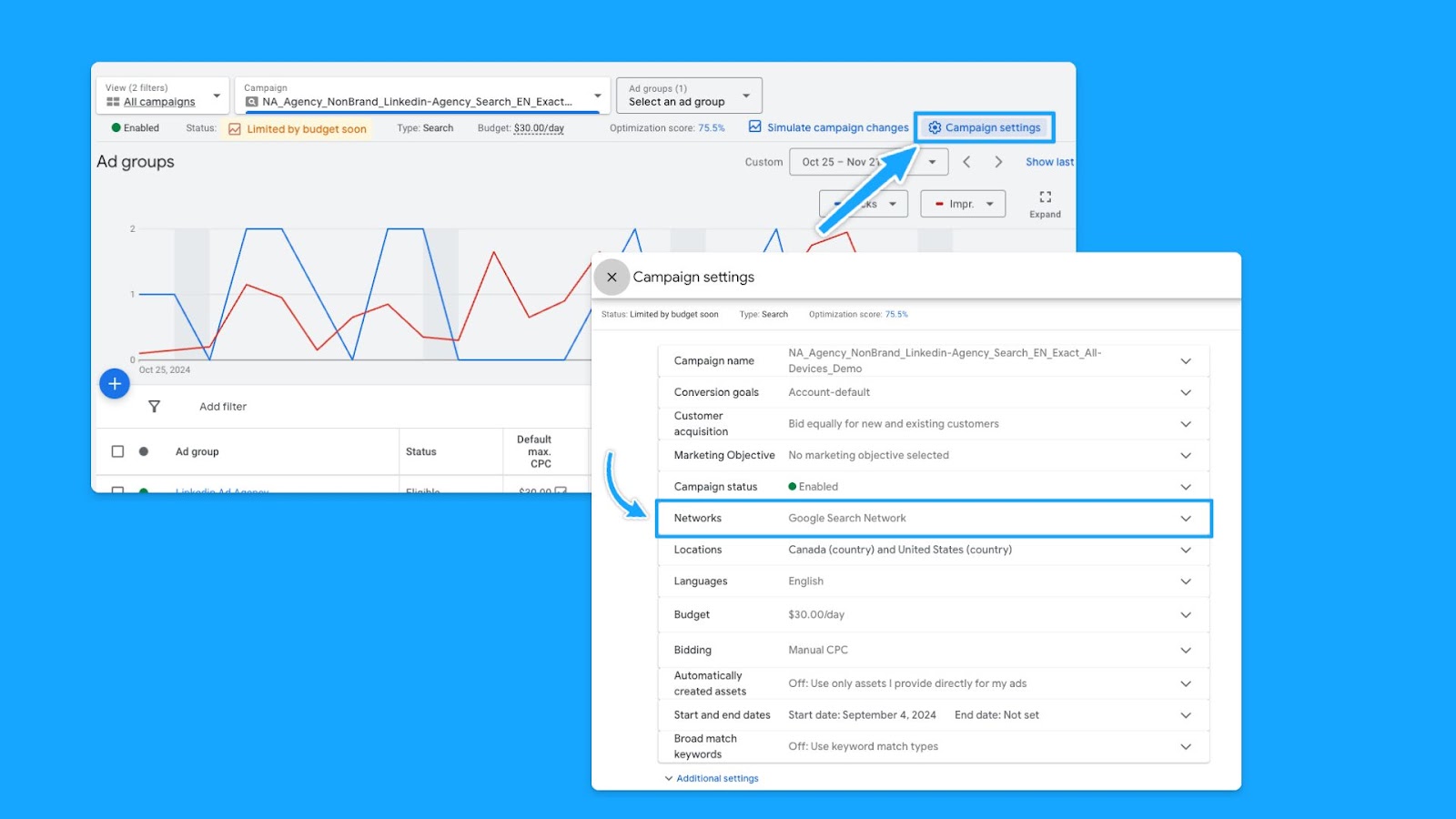
- At the campaign level
- Scroll over your campaign
- Setting logo will appear
- Click on the logo
- Under Networks, choose the desired Network and save.
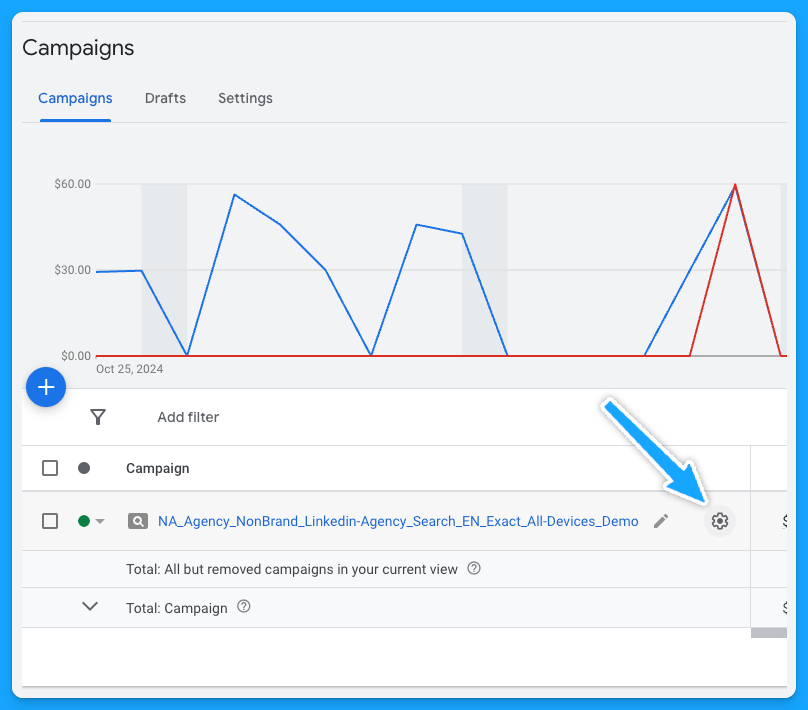
3. Is your location targeting and options still accurate?
If you have a proper naming convention, you should be able to tell where you intend to target your campaigns, but you still need to ensure the correct locations are selected.
Similar to Networks, there are two ways to check your locations:
- Select the desired campaign
- Go to Locations (on the left-hand side - Audiences, keywords and content)
- Click on the pencil icon
- Choose the desired locations and save
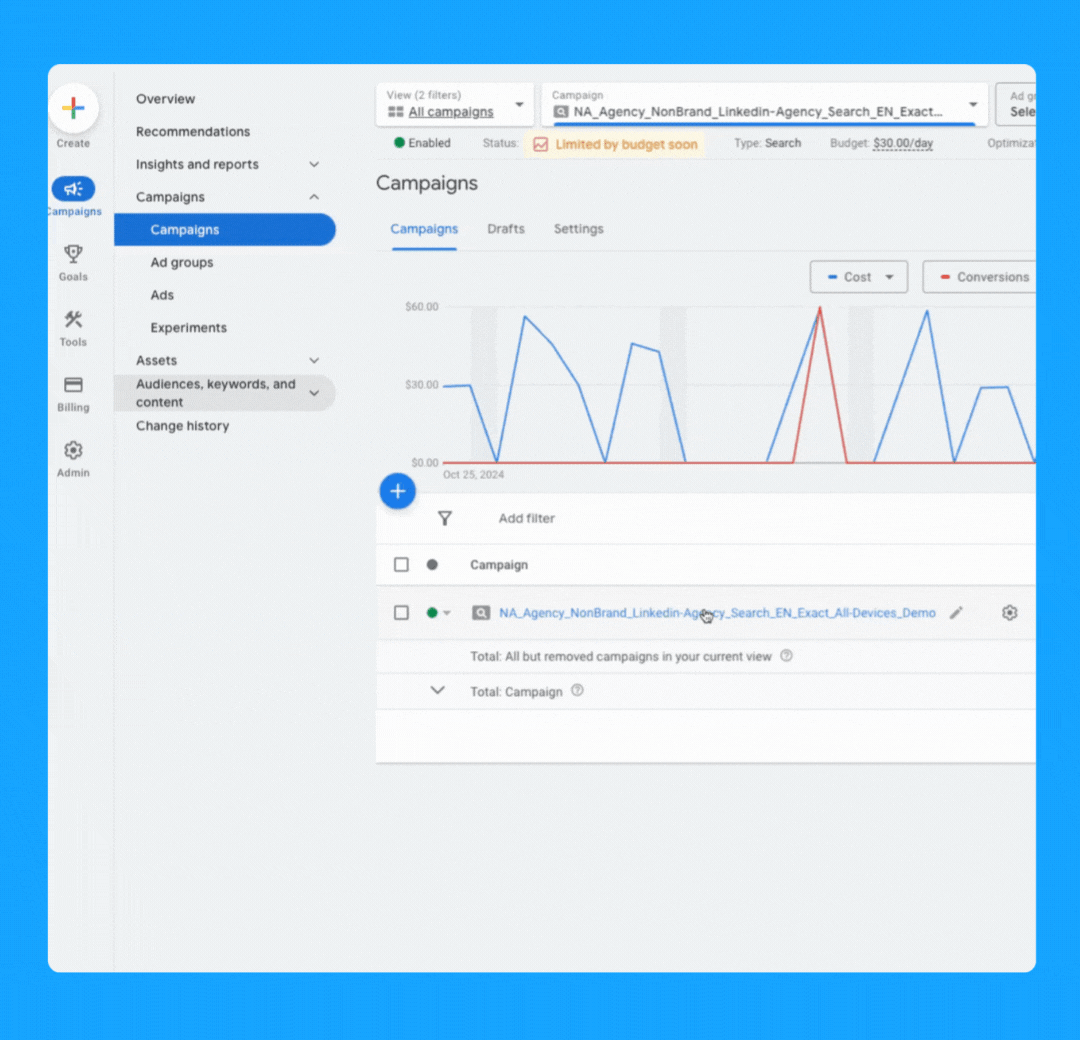
- At the campaign level > Scroll over your campaign
- The settings logo will appear
- Click on the logo
- Under Locations, Enter location(s) and Save.
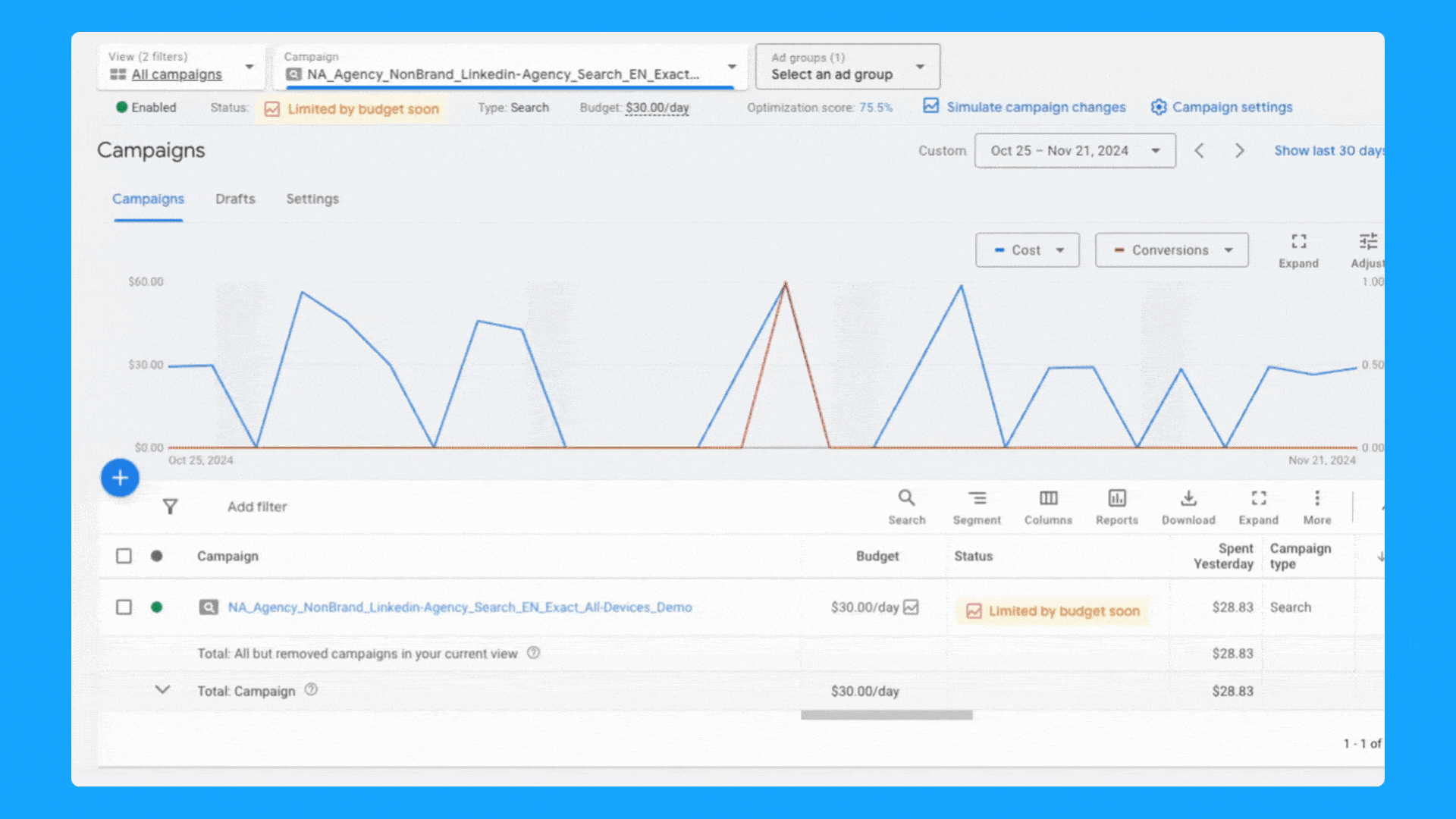
4. Are you targeting one language per campaign (with relevant ads + landing pages)?
In a perfect world, your ads and landing pages should match the primary language of the targeting locations.
Here’s how you can change the language of your campaigns:
- At the campaign level, toggle over your campaign name
- Click on the icon setting once it appears
- Under “Languages” you can select the desired language and click Save.
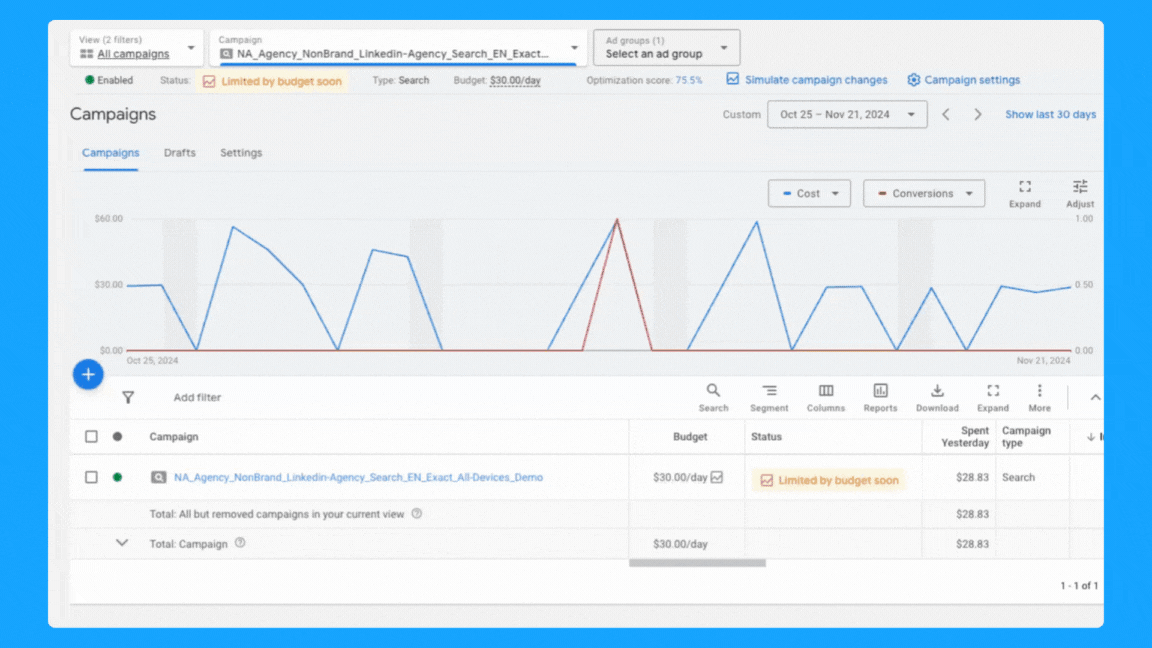
5. Is your daily budget still aligned with your goals?
Being an effective marketer involves strategically allocating your budget over the designated campaign duration while achieving the goals.
Ex. If your average cost per demo is $300 and you need to generate 10 demos, then you must have at least $3,000 - Now, if the plan is to run the campaign for 30 days, then you must allocate a $100 daily budget and check daily to make sure it’s pacing well.
Generally speaking, I don’t recommend running campaigns with less than $50/day for B2B campaigns, but this will obviously depend on your average cost per click.
Check our Google Ads Budget Calculator tool if you need help to define your budget 🙌
6. Are you using the correct bidding strategy?
When you’re first starting out, getting as many clicks as possible is important to get some early conversions, so the “Maximize Clicks” strategy is a good option.
If you have more than 15 conversions, you can switch to the “Maximize Conversions” strategy if your goal is to get as many conversions as possible.
If you have offline conversions set up, you can use the “Maximize Conversion Value” strategy or the “Target ROAS” strategy. These will help you get more relevant conversions.
Here are two ways to check your bidding options:
- Select the desired campaign
- Go to Setting (on the right-hand side)
- Click on Bidding > “Change bid strategy”
- From the dropdown menu, select the desired bidding strategy and save.
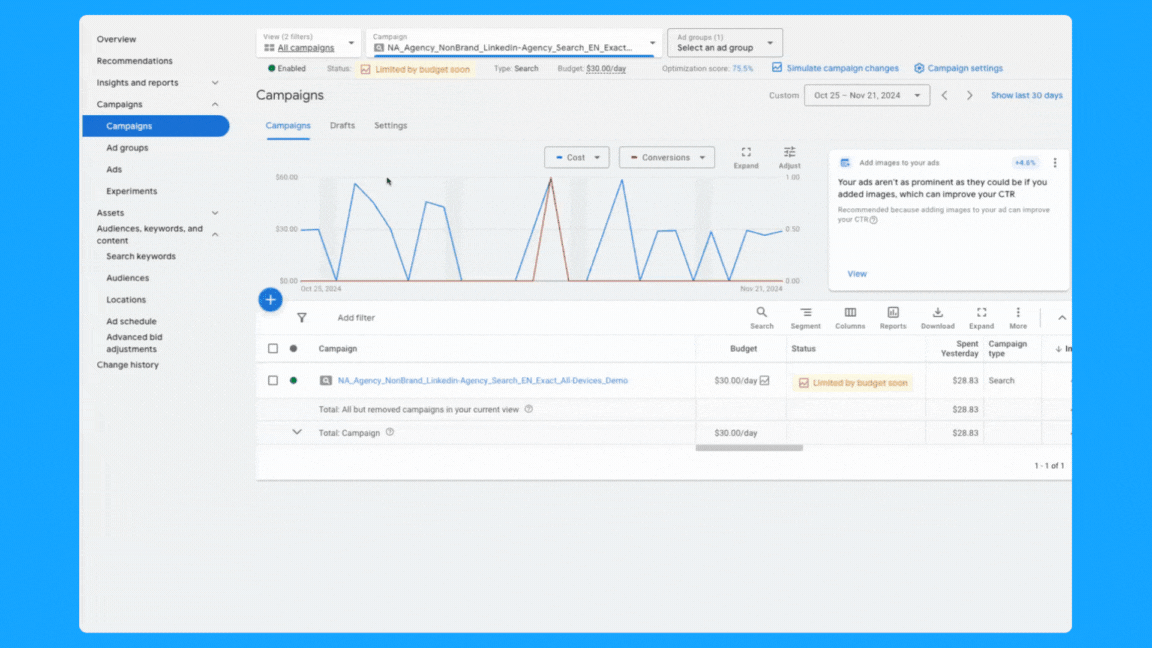
- At the campaign level > scroll over your campaign > Setting logo will appear
- Click on the logo
- Under Bidding, “Change bid strategy”
- From the dropdown menu, select the desired bidding strategy and save.
7. Do you have the correct conversion actions set? (if applicable)
Campaigns can inherit account-level conversions or have specific conversion actions set.
Both approaches are valid, but it’s essential to use the one that aligns with your campaign goals.
For instance, if a campaign-specific conversion action set is used, make sure it includes all relevant actions in the conversion funnel.
Follow the steps below to add/check conversion actions:
- At the campaign level > scroll over your campaign
- Setting logo will appear, click on the logo
- Under Goals, “Use campaign-specific goal setting”
- Click the pencil icon
- Select the appropriate (previously tested) conversions and save.

8. Are your ad rotation settings still accurate?
Generally speaking, I recommend using the “Best Performing Ads” option. This way, the Google algorithm will analyze your ads' performance and prioritize delivering the the ads with the best performance.
But if you see that Google is serving some ads dramatically more than others, then you can select “Rotate Ads Indefinitely” and Google will distribute each ad individually.
For conducting A/B testing on multiple ads, I recommend selecting the "Do not optimize" setting to make sure you’re collecting more precise data.
To review your ad rotation settings, follow these steps:
- At the campaign level > scroll over your campaign
- Setting logo will appear, click on the logo
- Click on additional settings > Ad rotation
- Click the pencil icon
- Select the preferred method and save.
You can also follow the steps above at the Ad Group level
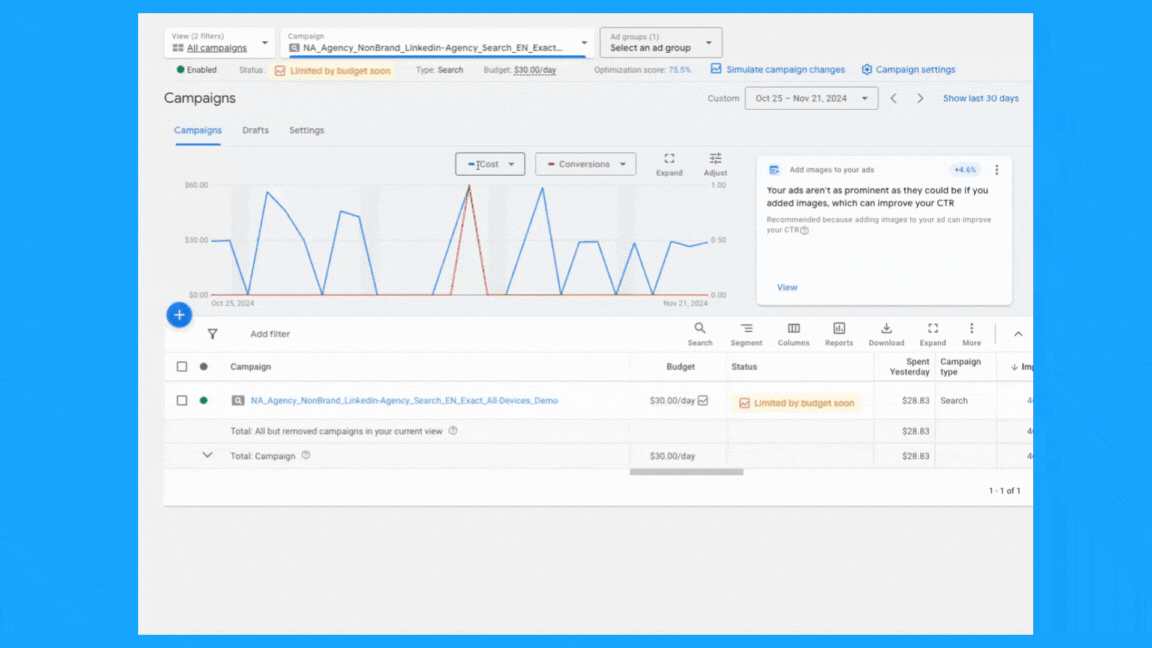
9. Is your ad schedule still up to date?
You can review your campaign's performance by day of the week and time of day, then adjust your ad schedule as needed. To do so, follow these steps:
- Click on “Overview” on the left-hand side
- Under the “Day & Hour” table, you can choose the metrics that matter the most to you to view performance by Day and/or Hour.
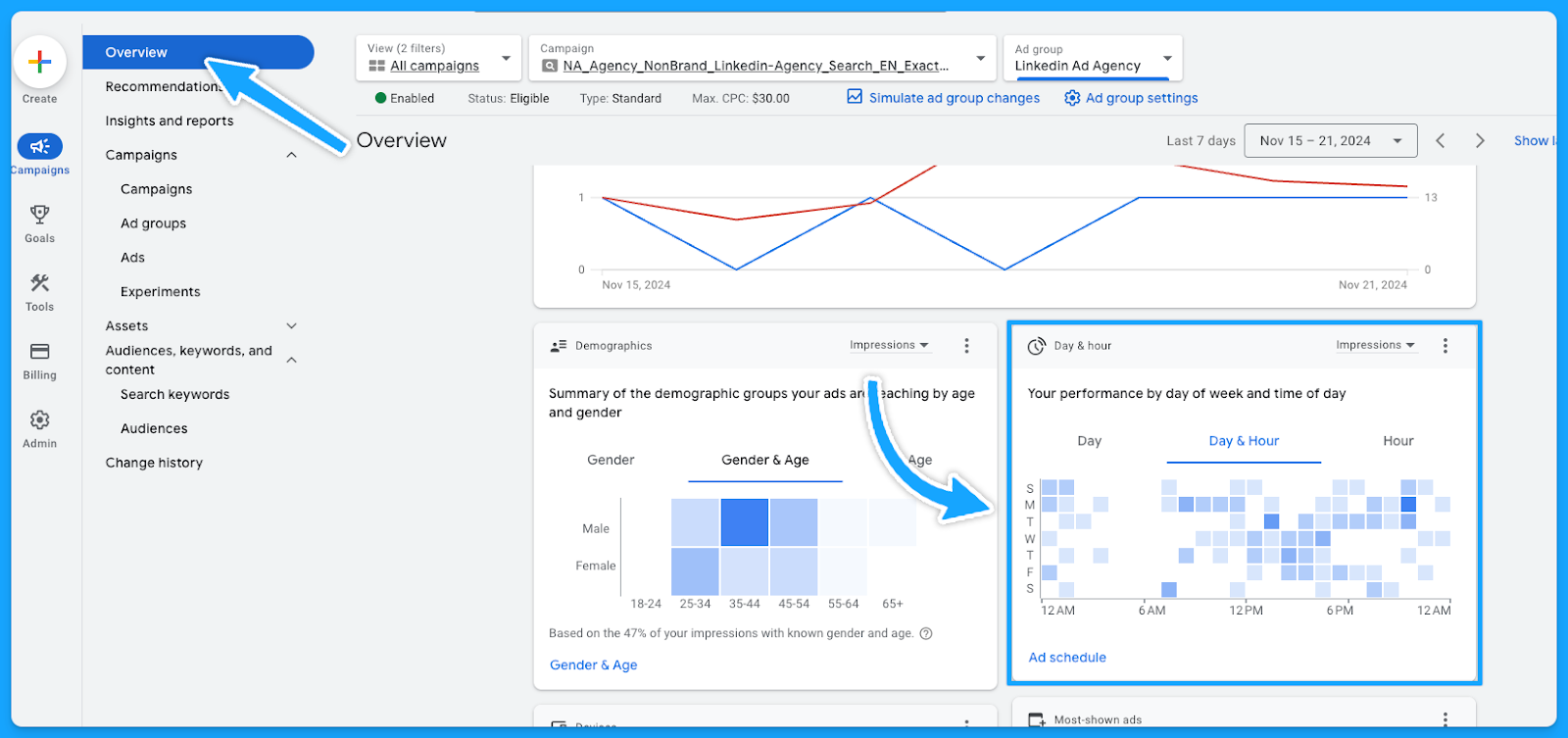
Now that you know which days and times generate the best results, you can tailor your ad scheduling accordingly.
- Select the campaign or ad group
- Click on Ad Schedule on the left-hand side
- Click the pencil icon
- Choose the optimal time and save.

10. Are you targeting the right devices?
Similar to the ad schedule, you can follow the same steps to find the best performance by device and make adjustments. Steps as follows:
- Click on “Overview” on the left-hand side
- Under the “devices” table, you can choose the metrics that matter the most to you.
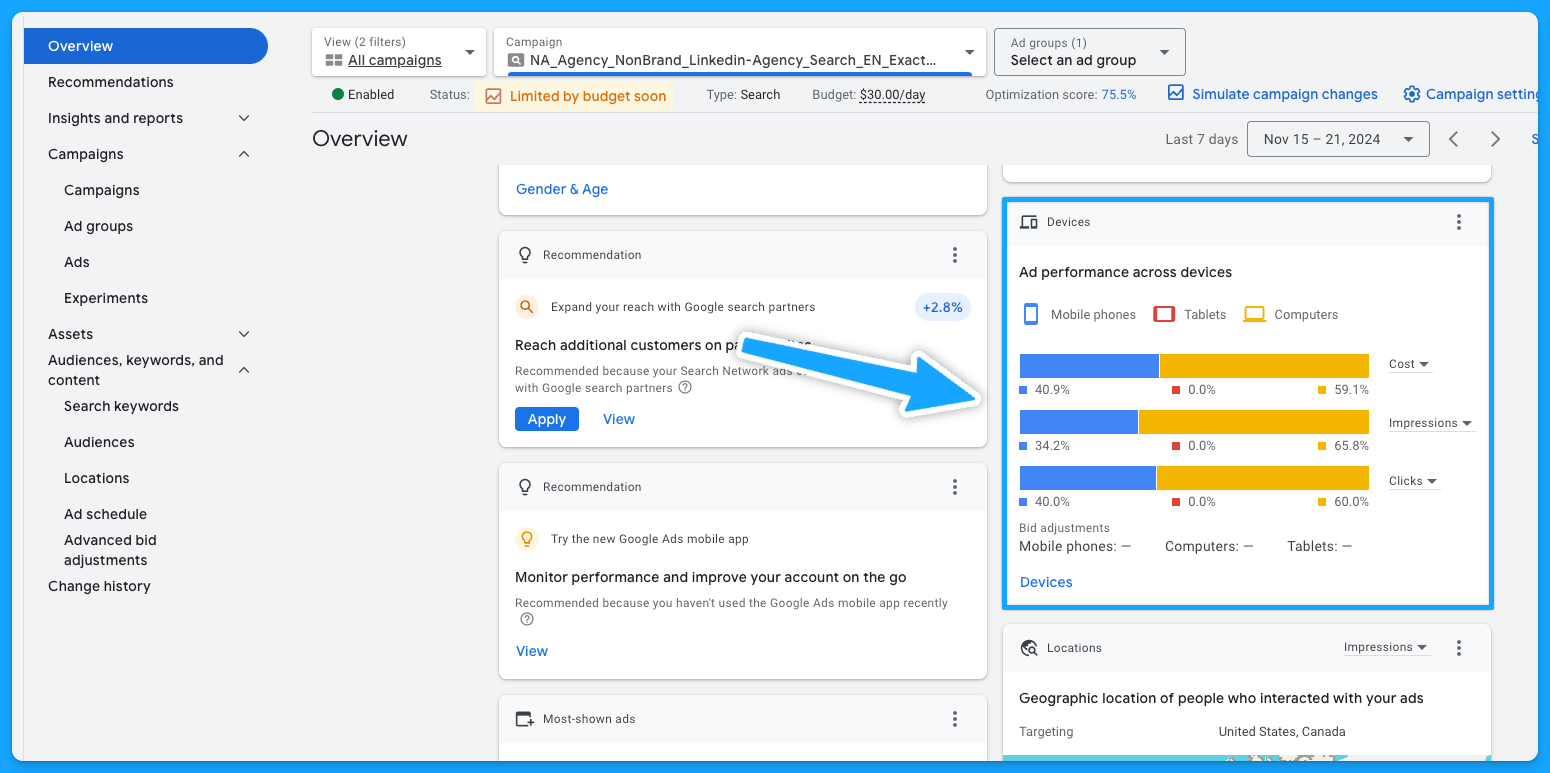
You can now update your targeting by device accordingly.
- Select the campaign or ad group
- Click on “When and where ads showed” on the left-hand side
- Edit bid adjustment
- To stop showing on a specific device, choose “Decrease with 100% ratio > Save

If you’re using the device on the campaign naming convention, you want to make sure the campaign is targeting the device it has on its name.
11. Are you excluding existing leads and sales from your campaigns? (bonus)
A practical approach to lowering costs involves not targeting existing leads and customers.
Google enables the upload of first-party data for use primarily in Remarketing Lists for Search Ads (RLSA) and for creating exclusions. Steps below:
- Select audiences on the left-hand side
- Edit exclusions
- Select the Campaign or Ad group
- Choose the previously uploaded audience > Save
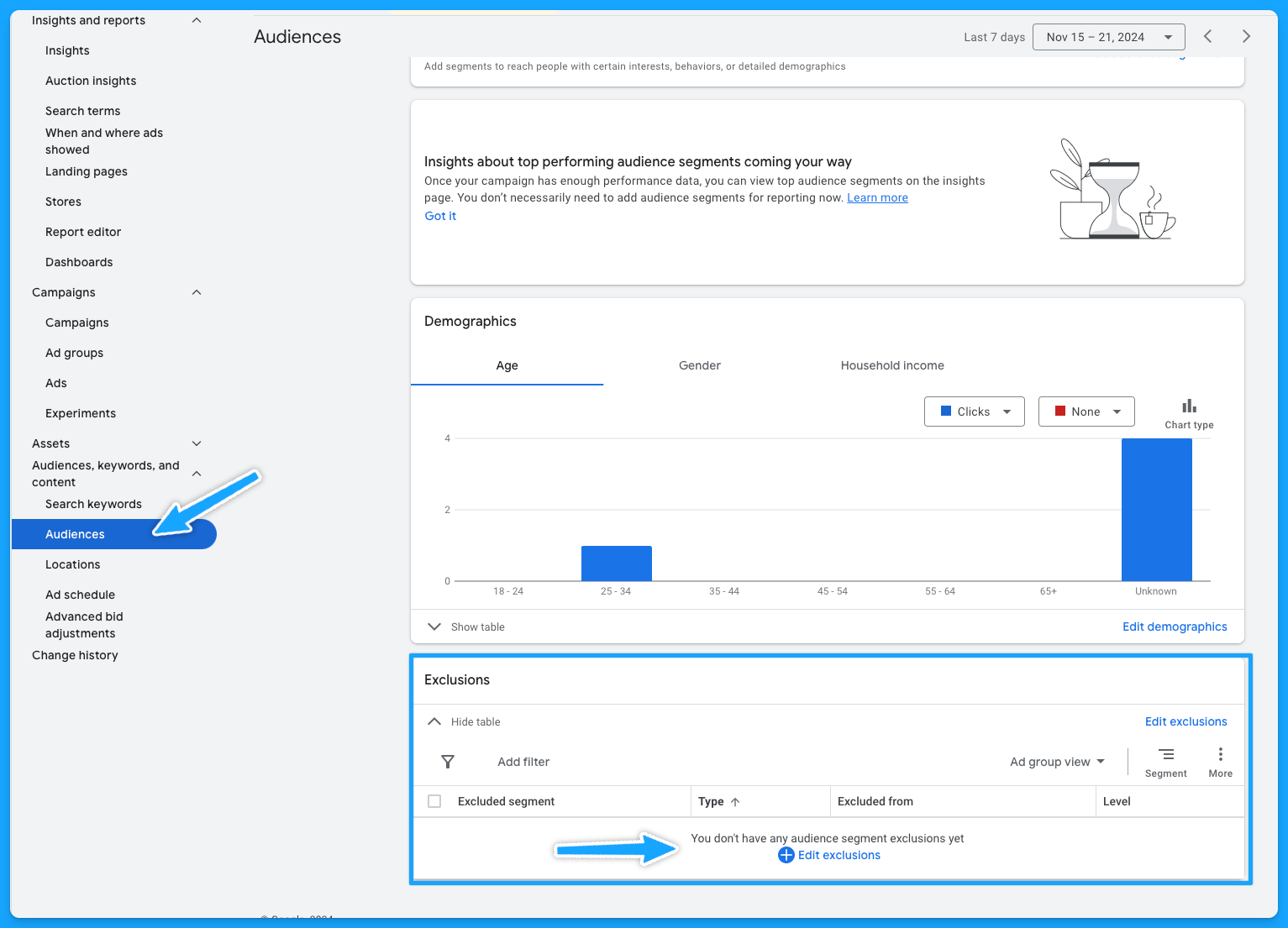
12. Do you have observational audiences added to your campaigns? (bonus)
Gain insights into how different audiences interact with your campaigns without altering who sees your ads:
- Select audiences on the left-hand side
- Audience segments
- Select Campaign or Ad Group
- Under observation, choose what is important to you and save.
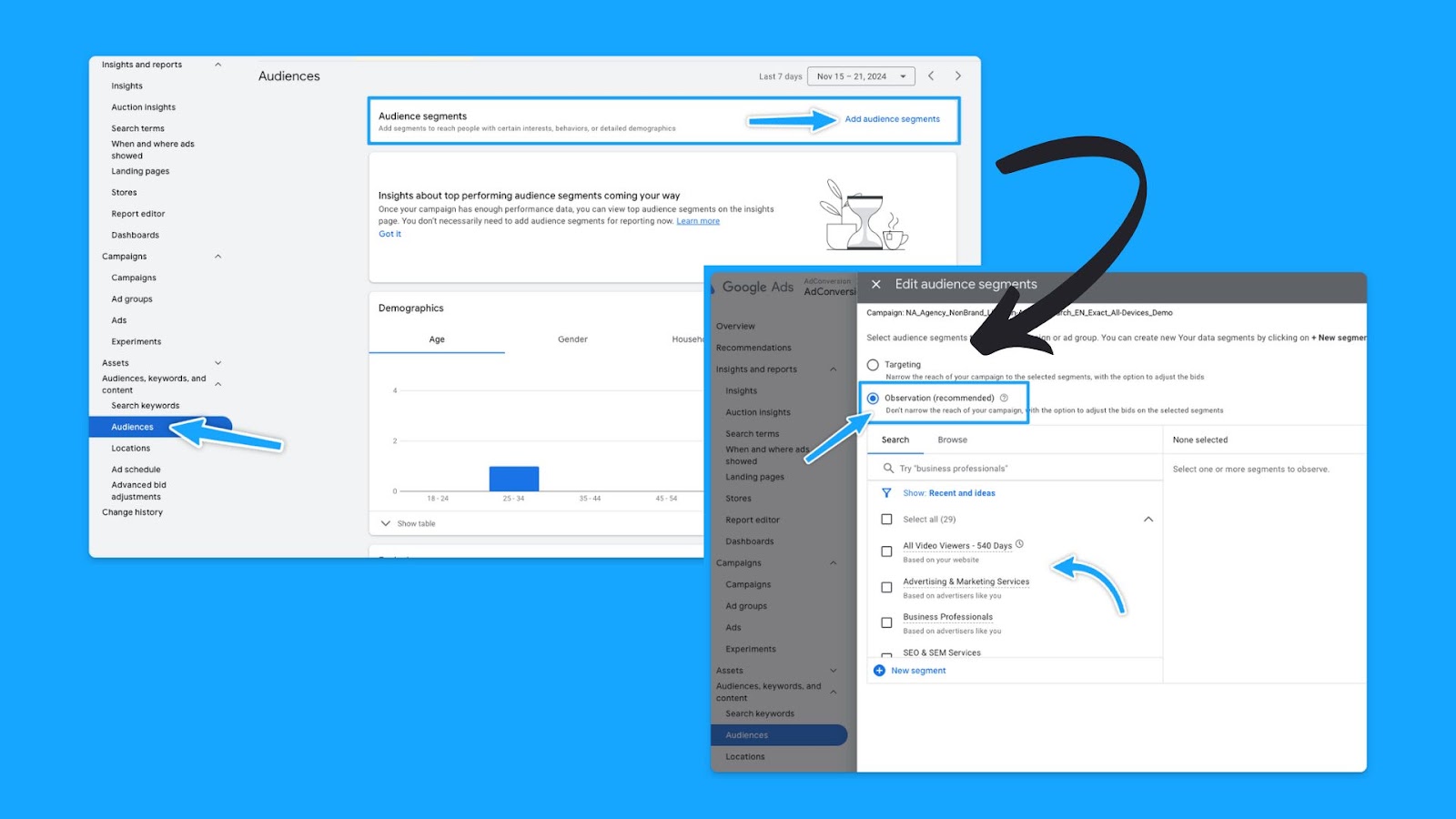
13. Have you been actively running campaign experiments in the past? (bonus)
With the Experiments feature, you can execute A/B tests without needing to set up new campaigns.
If the outcome proves successful, the winning campaign can then be chosen as the primary one.
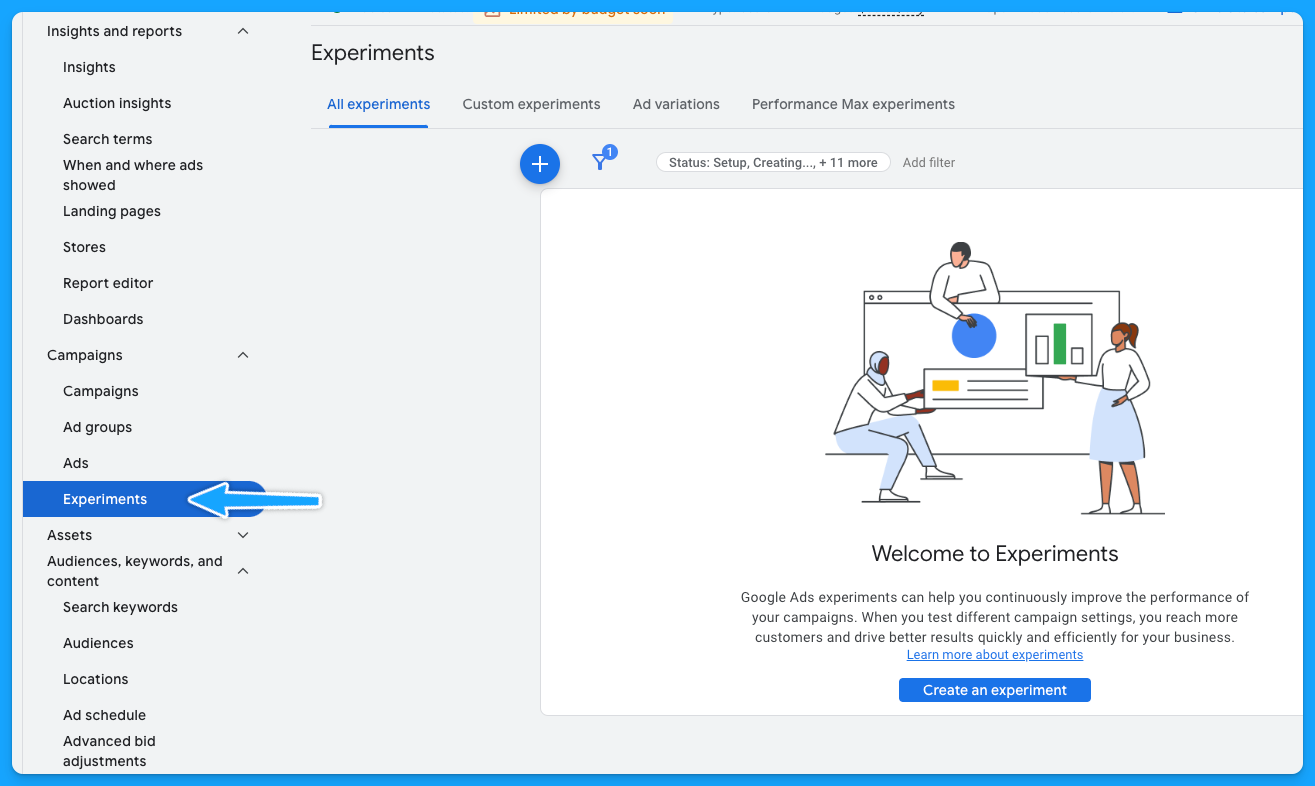
Part 3 - Ad Group Review
1. Are your ad groups broken out logically into related themes?
There are generally 6 buckets of themes for search ads:
- Brand
- Non-brand
- Competitive
- RLSA (Search Remarketing)
- Content
- Dynamic Search Ads
A clear naming convention aids in quickly identifying campaign and group themes. Example:
Campaign: NA_Non-Brand_Search_EN_Exact_All-Devices_Demo
Group: Non-Brand_Software
If there is no proper naming convention, then we have some cleaning to do:
- Download the data at the keyword level
- Delete: Ad spend < $ 1
- Open a new column called “Theme” beside the Keywords
- Tag the Theme of the campaign/group according to the Keyword
- Turn it into a pivot table to get the data by Theme
- Update the naming convention
If you don’t do a good job separating your keywords into themed ad groups, it will hurt your quality score.
Because if you have too many keywords in your ad group, it’s hard to make sure that the ads are relevant to all these keywords.
2. Do you have less than 15 keywords per ad group?
This is not a set-in-stone law, but it will help you mitigate the damage to your ad relevance.
Google allows up to 15 headlines and 4 descriptions in Responsive Search Ads. The goal is for keywords within each group to have a relevant ad to boost the quality score.
At the end of the day, you know you are doing a good job with your ad groups and how you structured your keywords if you see that your ad relevance is above average.
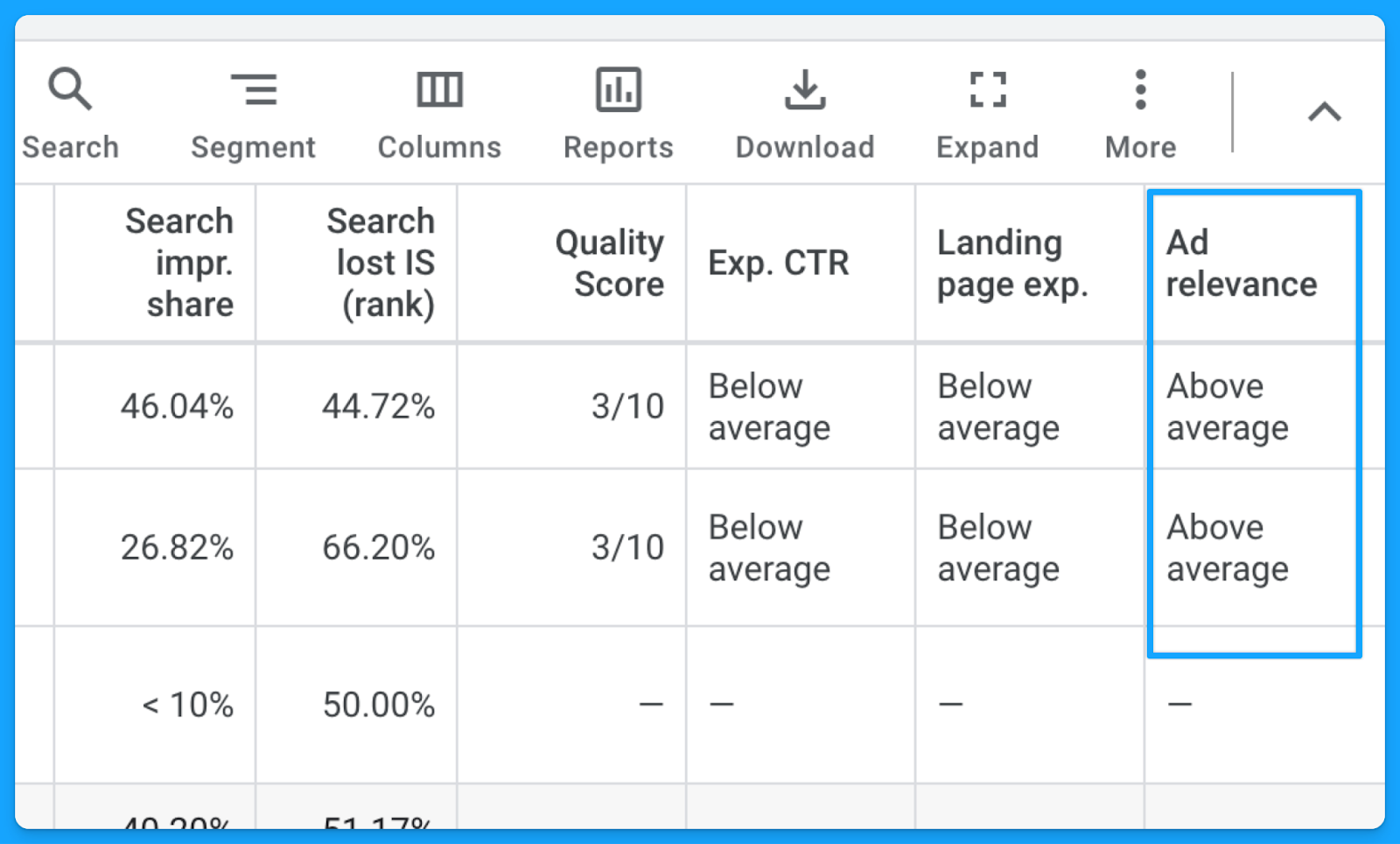
3. Are your ad groups filled with relevant keywords, ads, and landing pages?
Each group’s keywords should align with an ad in the same language, context, and call to action as well as a landing page contextualizing the search terms.
Here’s a good example of a great message match from the CRM software folk.
They’re bidding on the keyword “CRM software for startups”, their ad mentions “CRM for startups”, and if you click on the ad, their landing page talks exactly about CRM for startups. Everything is aligned.
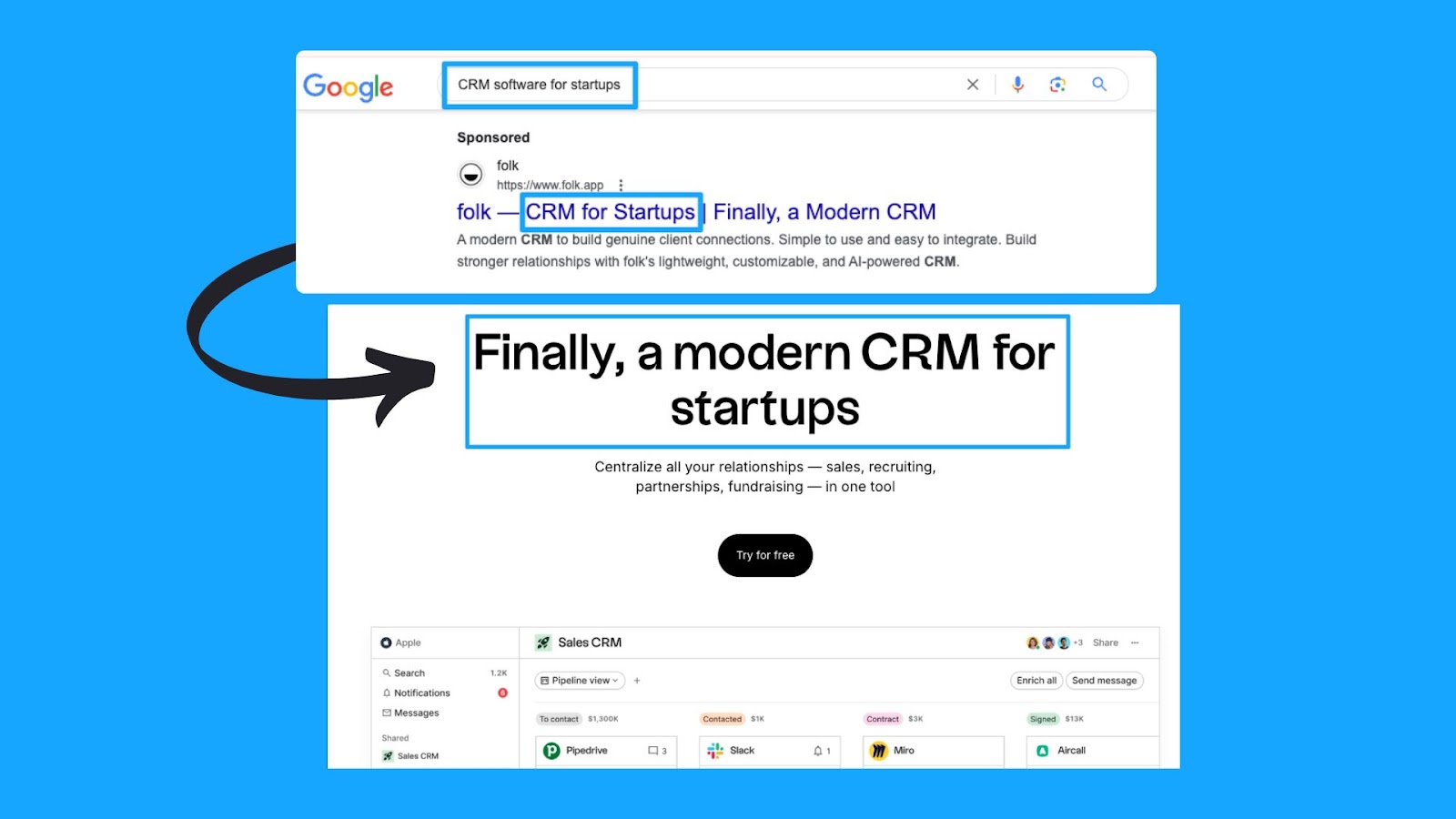
4. Are your best ad groups receiving enough budget?
With accurate conversion tracking in place for your campaigns (we covered this in Part 1), we can see which ad groups bring more conversions at a lower cost per conversion.After reviewing the ad group performance, you can optimize your ad groups in these ways:
- Pause the ad groups with more search volume that are just cannibalizing and eating up all the campaign budget without bringing conversions.
- Take the top performers' ad groups and put them into their own campaign.
- Run target CPA bidding and set different target CPA caps at the different ad group levels, so you can put a more restrictive cap on the one that’s eating up all the budget and then put a larger one on the one that hasn’t spent enough.
Part 4 - Keyword Review
1. Are your search terms as close to perfect as possible?
Regularly checking the search term report has 2 main benefits:
- Reduce CPA: Comparing the number of clicks to the number of conversions - exclude all irrelevant results.
- Increase Expected CTR: Compare the number of impressions to the number of clicks - exclude all irrelevant results.
How to check the search term report in Google ads:
- Under “Campaigns” on the left-hand side > Click “Insights and reports”
- Select “Search terms”
- Filter by campaign
- Evaluate the above recommendations.
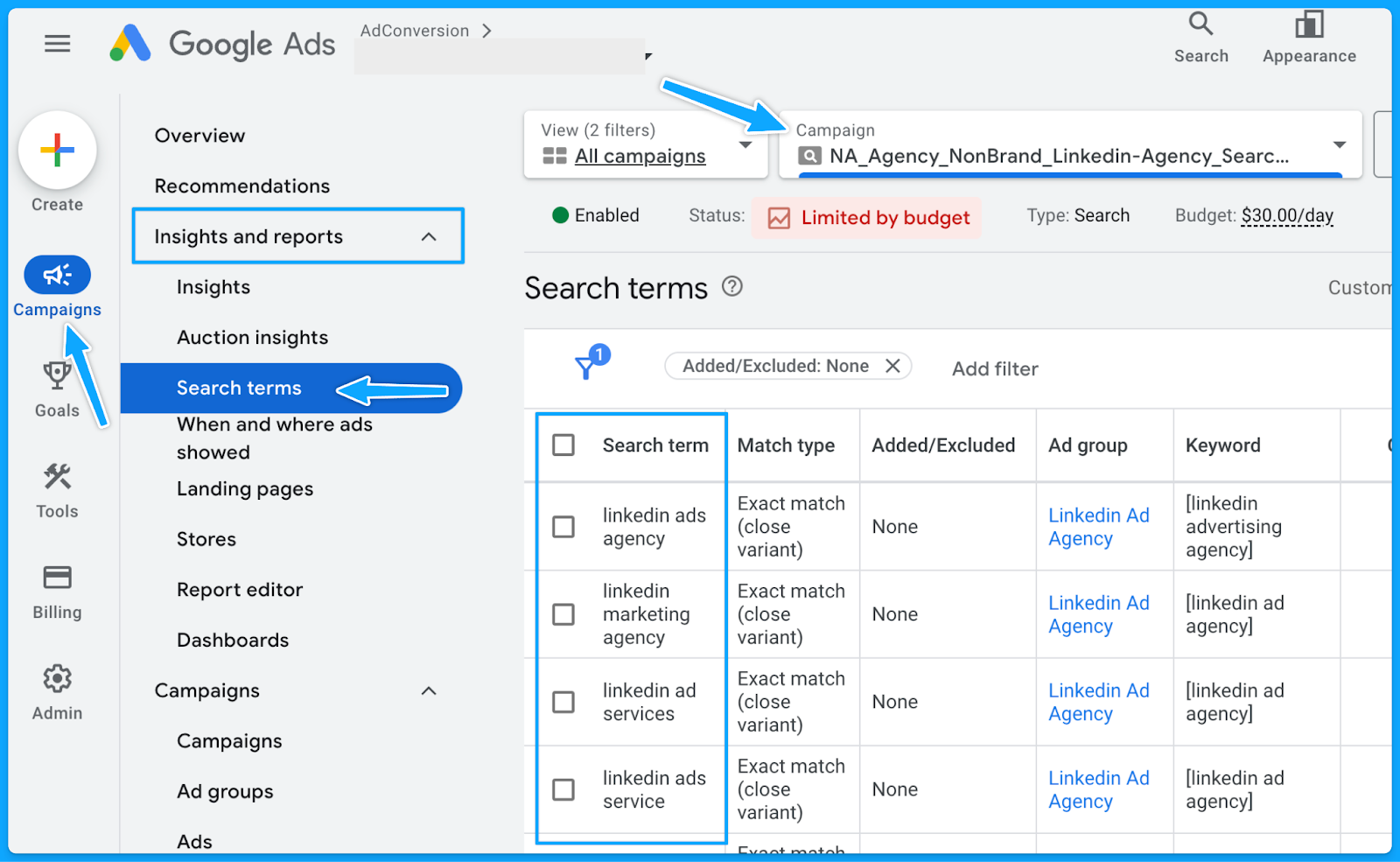
2. Do you have a strong negative keyword list in place?
Negative keywords help us reduce the wasted budget and increase the overall quality of ads.
The broader the match type, the more important it is to have an extensive list of negative keywords.
However, even with Exact match type, search terms must be regularly checked, and negative keywords constantly be updated.
Maintaining a universal negative keyword list for your entire account can be beneficial. This list might include words related to profanity, employment, bargaining, etc.
Below you can access a sample list we use in our agency.
👉 Master Negative Keyword List
To avoid unintended blocking, please ensure these negative keywords apply to your business and do not overlap with any targeting keywords.How to create a new list in Google:
- Select “Tools” on the left-hand side
- Under “Shared library” click on “Exclusion lists”
- Select the “plus sign”
- Add the list of desired negative keywords and name the list accordingly.
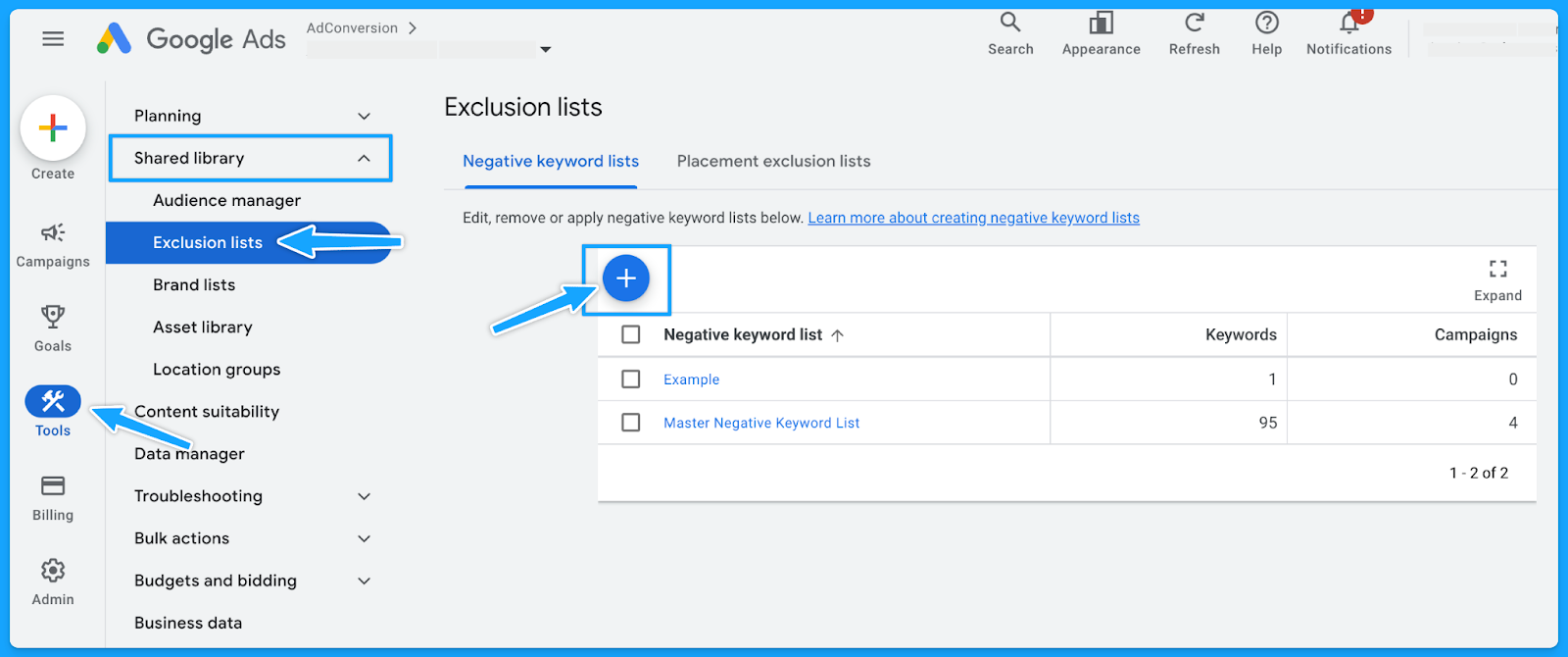
3. Do you have the appropriate match types for your keywords?
If you don’t know which match type you should start with, then always start with the Exact match type and work your way up.
If you don’t get quality conversions with the Exact match type, then changing the match type won’t help.
Generally, Broad match types have the highest wasted budget - unless the campaign is layered with a first-data party audience.
4. Do you have underperforming keywords you can pause or optimize?
Usually, 20% of the keywords are responsible for 80% of the results. Make sure to check the performance of each keyword and pause underperformers continuously.
However, before pausing, analyze the relevance of search terms against keywords.
If they align, evaluate the click-through rate (CTR) to determine if the ad copy requires updates.
If users are still clicking on the ad without converting, consider revising the landing page.
5. Are your keyword bids set at an optimal amount? (if applicable)
If you're using automated bidding, you don't have to worry about this step.
But if you're using manual bidding, sometimes your manual bid is too low, so your ads won’t show on the first pages of the results.
I recommend that your Max. CPC amount is at least high enough to the first page bid estimate.
You can find the keyword bid simulator by hovering over the small chart in the Max. CPC field.
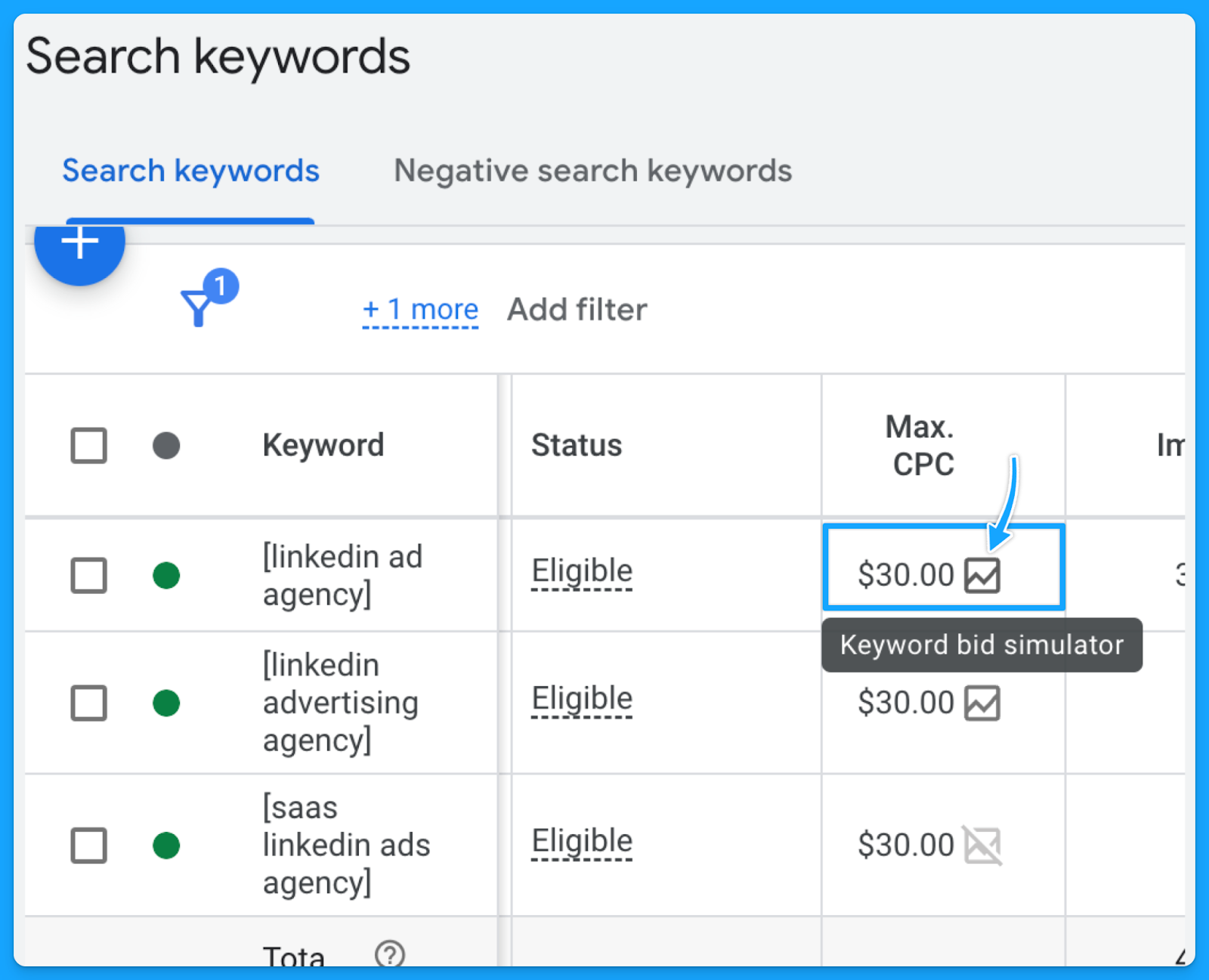
Part 5 - Ads & Extensions Review
1. Are your keywords in your ad copy?
This is an easy way to increase ad relevance and ultimately get more clicks.
I can’t stress enough the importance of having a strong message match.
When users encounter their specific search terms within your ad—especially if these terms are variations of your targeted keywords—the likelihood of them proceeding to your landing page significantly increases.

2. Are you title-casing the beginning of each letter in your ad?
Title casing is when you capitalize the letter of each important work in the sentence.
In my experience, title casing works better on paid search because your ads will look more professional, and it will enhance readability.

3. Do you have a minimum of two ads per ad group?
Running multiple ads allows for A/B testing or split testing, where different versions of ads can be compared to see which one performs better.
By consistently testing ads, you’ll drive a better click-through rate, and this will ultimately result in a better Expected Click-through rate, which will improve your quality score and reduce your costs while putting your ads in a better search results position.
4. Are you speaking one-to-one, communicating benefits, answering objections, and providing a CTA?
You want to make sure you are speaking one-to-one In your copy and not using corporate speak, where it seems you’re talking to an auditorium versus a person.Here are a few important points your ads should cover:
- Are you communicating benefits in the second headline to differentiate yourself from your competitors on the SERP?
- Are you answering objections? (If there are objections that you can answer on your copy)
- Are you providing a Call-to-Action (CTA) that moves people and motivates them?
Here’s a good example from Brevo:

- We can instantly see the benefit: 9000 emails free per month
- One-to-one communication: Don’t let them overcharge you
- CTA that motivates: Stop overpaying for email and get the best value in email delivery & email marketing tools.
5. Are you using all the characters available in your headline, description & path fields?
You don’t have to use every single one, but I recommend you use as many as you can.
Utilizing all available characters in Google Ads' headline, description, and path fields increases message clarity and impact, boosting click-through and conversion rates.
6. Are you using as many ad extensions (assets) as possible? (Especially core ones)
Extensions expand your presence on the search results page, improving the chances of receiving more clicks, which will increase your expected CTR and the overall quality score.
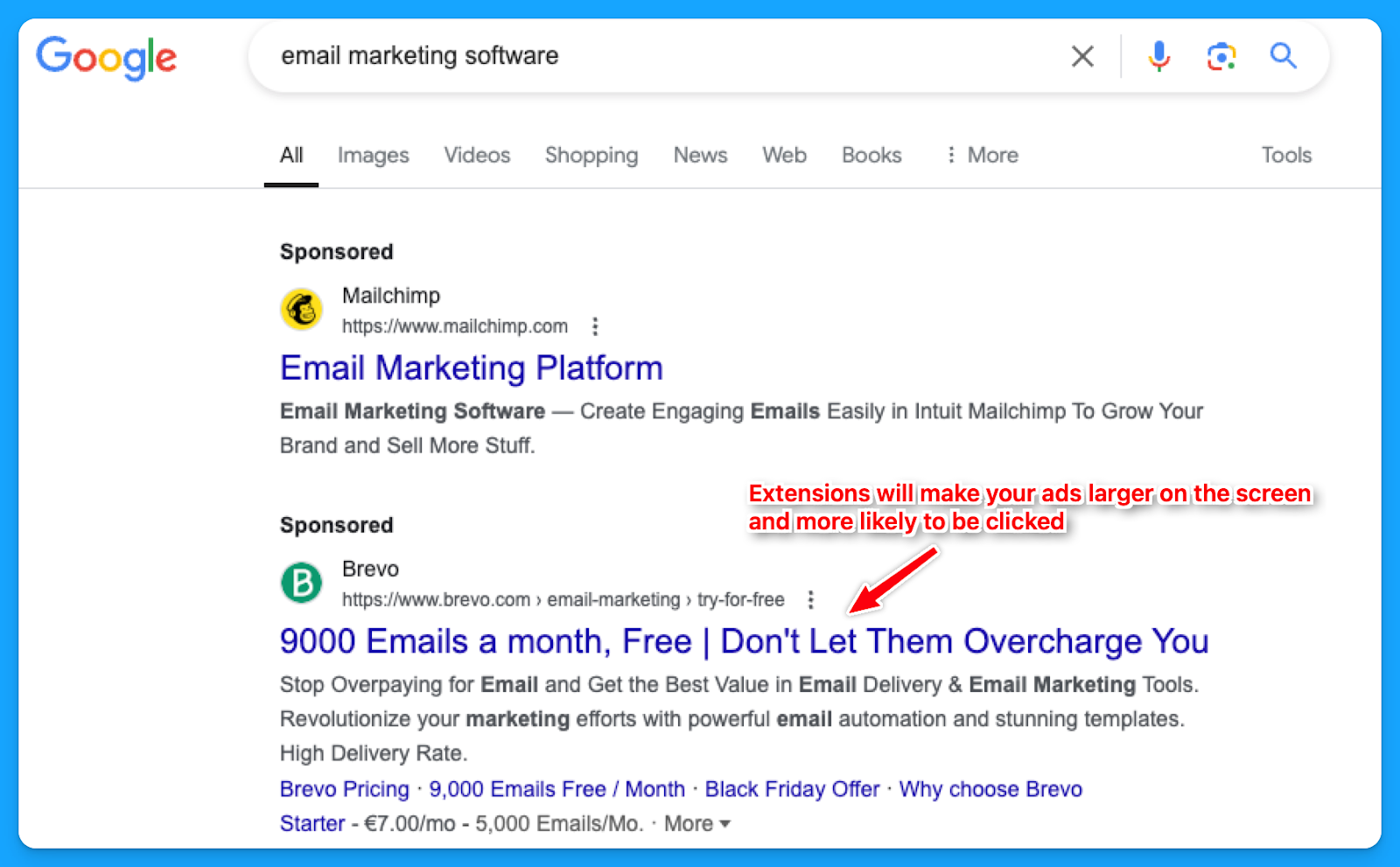
While assets such as the business logo and name are best set at the account level, it's often better to tailor other extensions, like callouts, structured snippets, sitelinks, etc., to reflect the the messaging of each campaign or ad group.
How to create new ad extensions in Google:
- Select “Campaigns” on the left-hand side
- Under “Assets” click on “Assets”
- Select the desired extension to see the ones you already have.
- Click on the “plus sign” to add new ad extensions.

7. Are you consistently testing new ad copy, types and modifiers?
If you are not doing this, you’ll know because you will see the click-through rate consistently going down week over week, month over month.
If you’re auditing someone else’s account, you can check the “Changes history” option to see if they are constantly testing new ads.
For modifiers, you can use dynamic keyword insertion in your ad copies to dynamically test different variations.
8. Are you sending searchers to relevant landing pages?
In my opinion, this is the most important thing.
If your prospects search for “CRM for startups”, your ads should say “CRM for startups”, and your landing page should say “CRM for startups”.

This sounds basic and trivial, but the amount of people who miss this is dramatic.
So make sure that you have a strong message match.
Part 6 - Landing Page Review
Remember that success will come from half traffic and half your landing page, so I highly recommend deep diving into your pages individually as you go through this.
1. Are you mirroring the message from your ad on the landing page?
As I mentioned in the last step of Part 5, the landing page experience is a crucial element of the quality score.
A page that fails to align with your ad's messaging is unlikely to offer value to the user.
2. Can the searcher understand what you do & why in 5 seconds or less?
This is called the five-second rule, and it’s essentially a test where if your prospects just look at the above the fold section of your landing page, can they understand in five seconds what you do and essentially why they should care?
In this example from Microsoft Clarity, we can easily understand that this is a free tool that will help you get insights into the behavior of users on your website so you can improve your products.
It’s also used by 100k+ sites worldwide and is GDPR & CCPA-compliant.
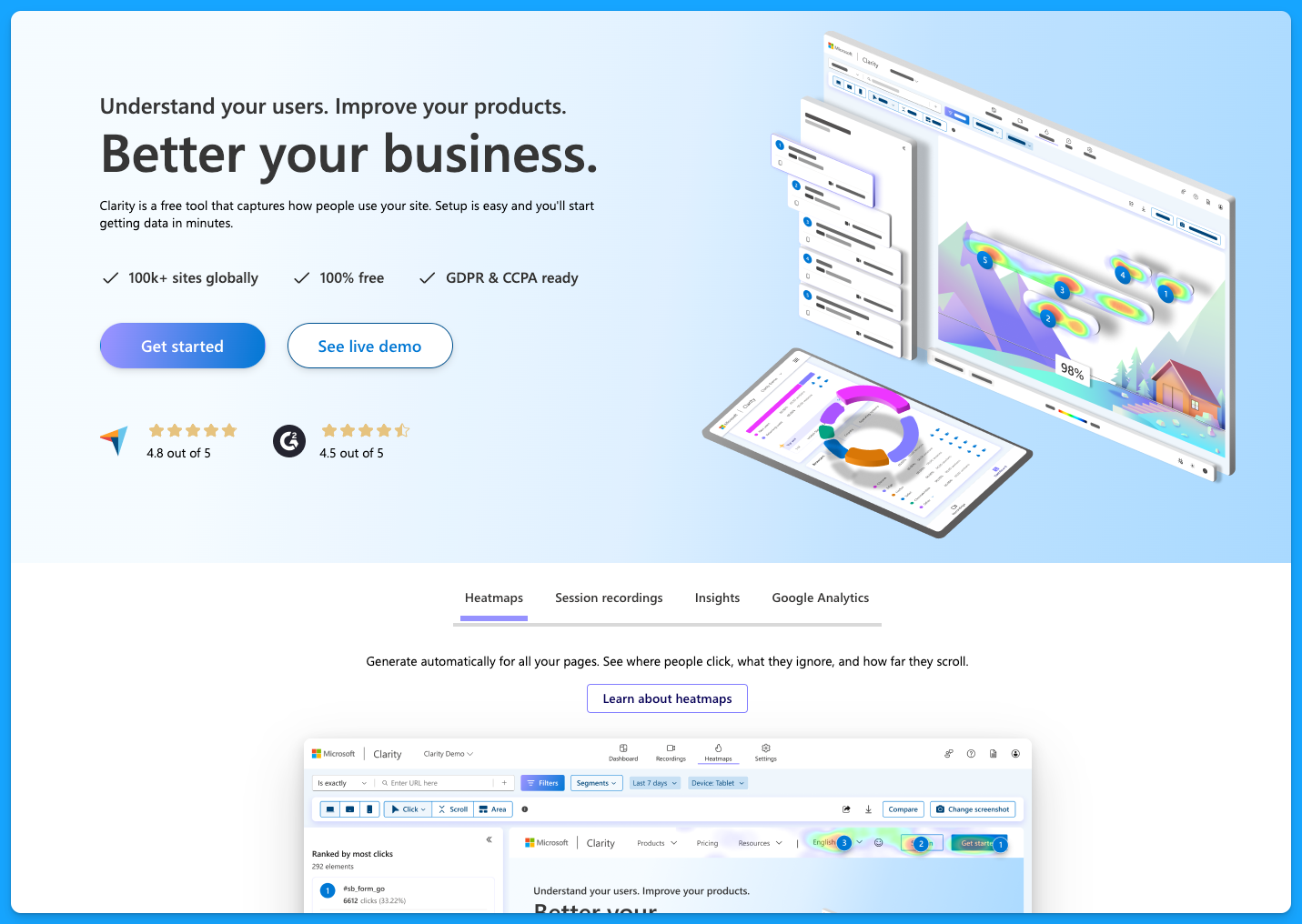
You don’t want to be vague on your landing pages, and you want to make sure that they have the following:
- Clear and concise headline
- Engaging subheadlines
- Visual elements
- Call to action (CTA) throughout the page
- Quick loading time for all devices
To learn more about landing page best practices, dive into the article below by Pedro Cortés:
10 Proven Landing Page Tips To Boost Your Conversion Rates
3. Is your landing page loading fast enough?
As mentioned above, the landing pages must load quickly on all devices. Tools like Lighthouse or PageSpeed Insights can help you better understand areas of opportunity.
I recommend you run your page through PageSpeed Insights and apply anything applicable.
You’re probably going to need the help of a developer, but it’s definitely worthwhile to improve the page speed because this is a big factor in terms of your landing page experience for quality score.
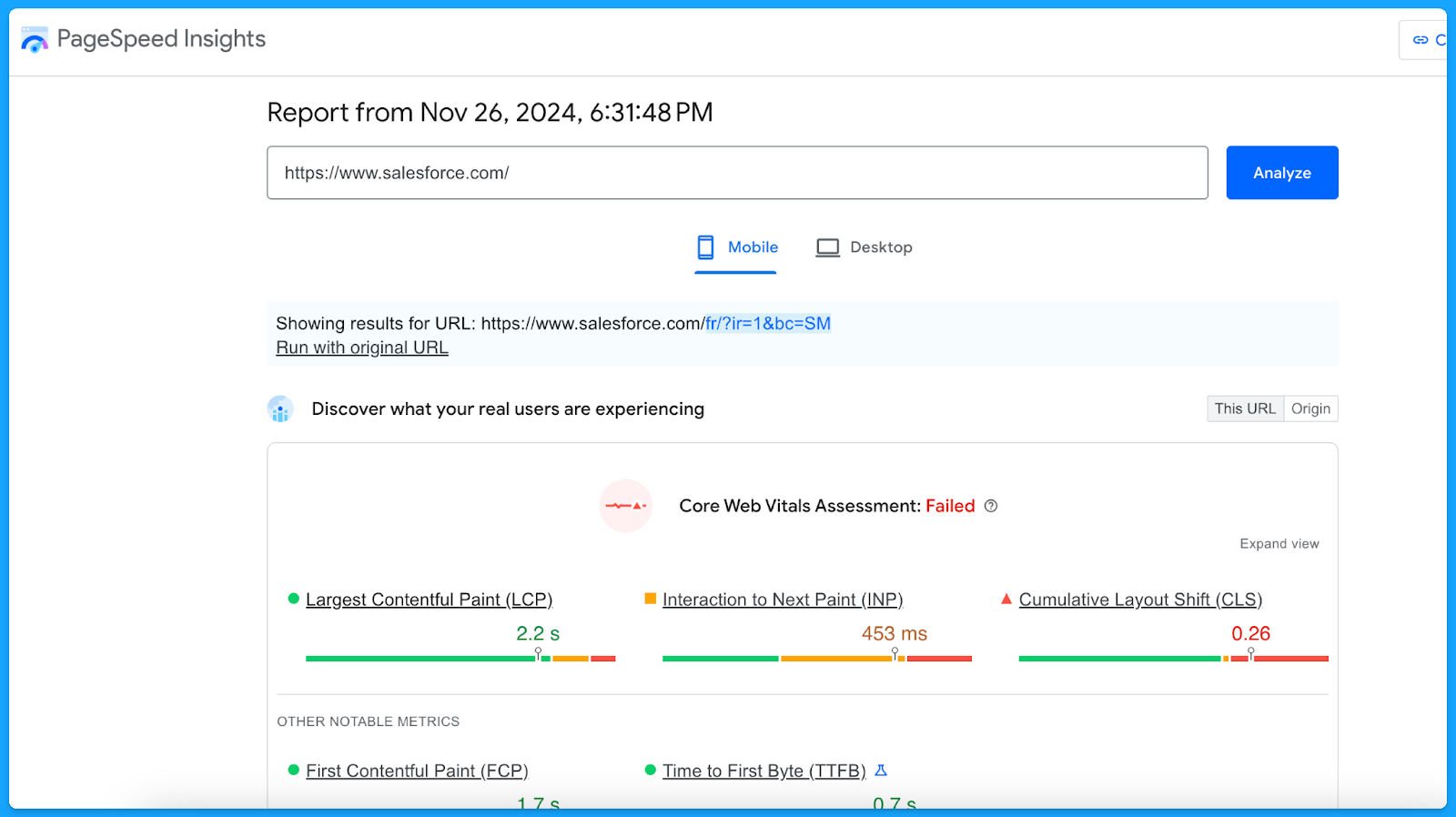
A simple thing to improve your landing page loading time is compressing the website images to reduce the file sizes.
4. Do you have one clear call to action on your landing page that mirrors your ad?
If your ad is talking about Downloading a Whitepaper but the landing page only has CTAs around Booking a Demo, then that will have a negative experience for the user.
Align landing page CTAs with ad promises to ensure a seamless user experience and encourage conversions.
5. Are you communicating benefits, answering objections, and providing a CTA?
The higher the ask, the more context must be provided on the page. This is specifically true for the “Book a Demo” CTA.
Ensure you address objections while emphasizing the key benefits of your product that will solve the users' problems.
I recommend that you talk with your sales team to get insights on different objections that come up in the sales process, this way you can add sections on your landing page to proactively communicate against those objections so that you can actually drive more quality leads.
6. Does your form, chatbot, or online booking widget still work?
Before launching any new offers, test the page to make sure everything is working as intended.
- Submit a fake test lead and see if it actually routes into your CRM.
- Go look for your lead record.
- Check if the page isn’t broken.
- Review what the experience looks like.
Make sure you audit that process because I can't tell you how many times people think their campaigns are failing, and then something just broke on the technical side.
Part 7 - Budget & Performance Review
1. What is the spread of budget and performance by campaign theme? (NonBrand, Brand, Competitive, RLSA, Content)
This is where you will need to export a lot of data from Google Ads and use Excel/Google Sheets.
👉 I recommend watching the Part 7 video above if you need a walkthrough on exporting and labeling the data to perform this analysis.
Here’s a common successful budget distribution you can use as guidance:
- Brand: < 20%
- Non-brand > 60%
- Competitive > 20%
You can use our free Google Ads Budget Calculator to find your ideal Google Ads budget.
2. What is the spread of budget and performance by region?
If you are targeting multiple regions, break out the campaign as such (ex: NA, EMEA, APAC).
👉 Check out the Part 7 video above if you need a walkthrough on the data analysis methodology using Excel.
Look for the highest-performing locations for each region and make sure low-quality conversions are not wasting your budget. If you’re not separating your campaigns into regions, you can still check how the budget has been spread around different locations through the Locations report:
- Select “Campaigns” on the left-hand side
- Go to “Locations”, under “Audiences, keywords, and content”
- Select the desired campaign
- Download the data under Location
- Summarize into a pivot table to get:
- Ad spent
- Conversions
- Cost per conversion
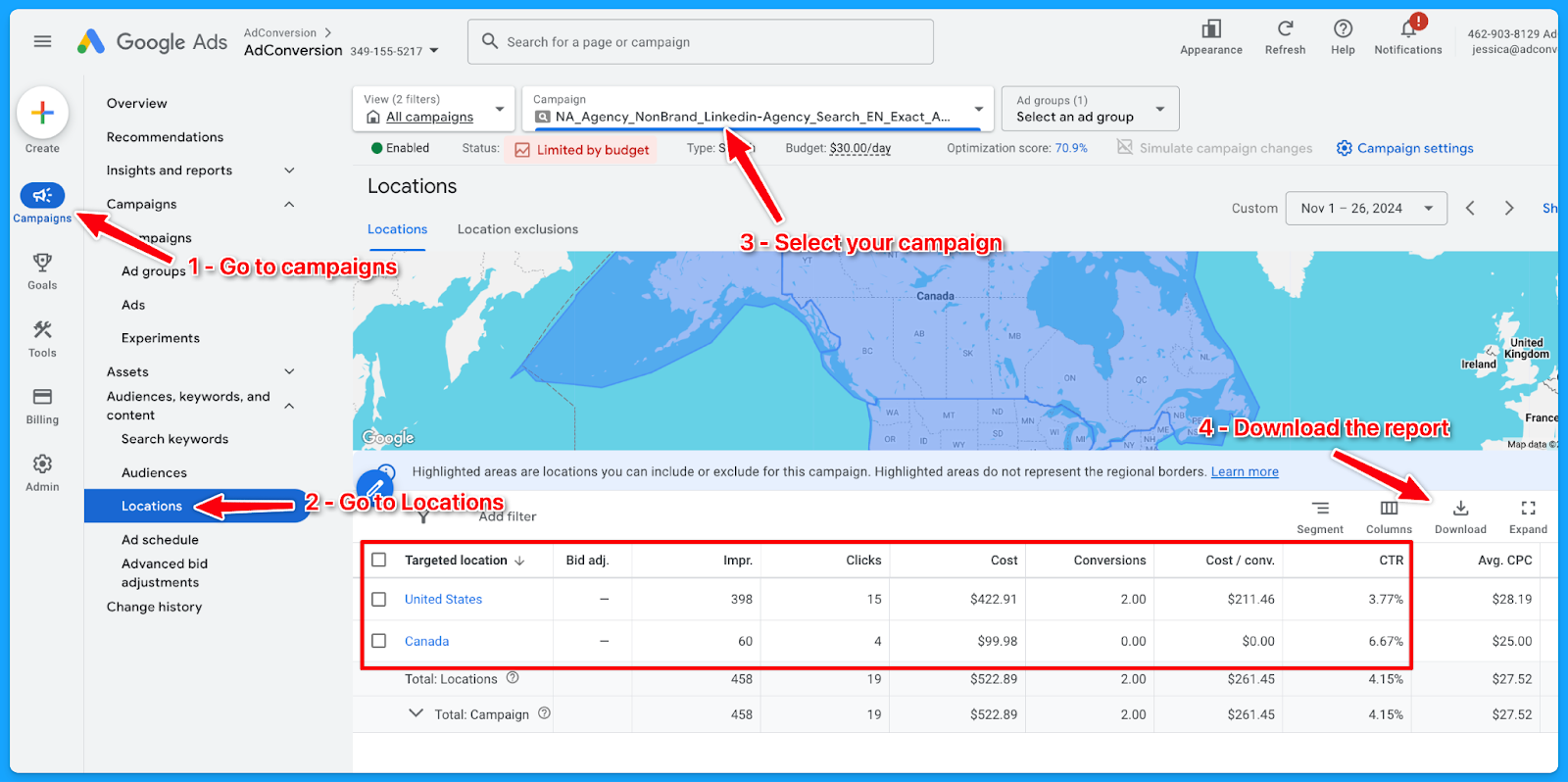
3. What is the spread of budget and performance by offer?
If you are separating the campaigns by offer, break out the campaign as such (Demo, Trials, eBooks, etc)
👉 Check out the Part 7 video above if you need a walkthrough on the data analysis methodology using Excel.
Here’s how to download the landing page report:
- Select “Campaigns” on the left-hand side
- Go to “Landing Pages”, under “Insights and Reports”
- Select the desired campaign
- Download the data
- On Excel:
- Delete: Ad spend <$1
- If there is no proper naming convention:
- Open a new column (Offer) beside the landing page (LP)
- Tag the offer of the campaign according to the LP
- Summarize into a pivot table to get:
- Ad spent
- Conversions
- Cost per conversion
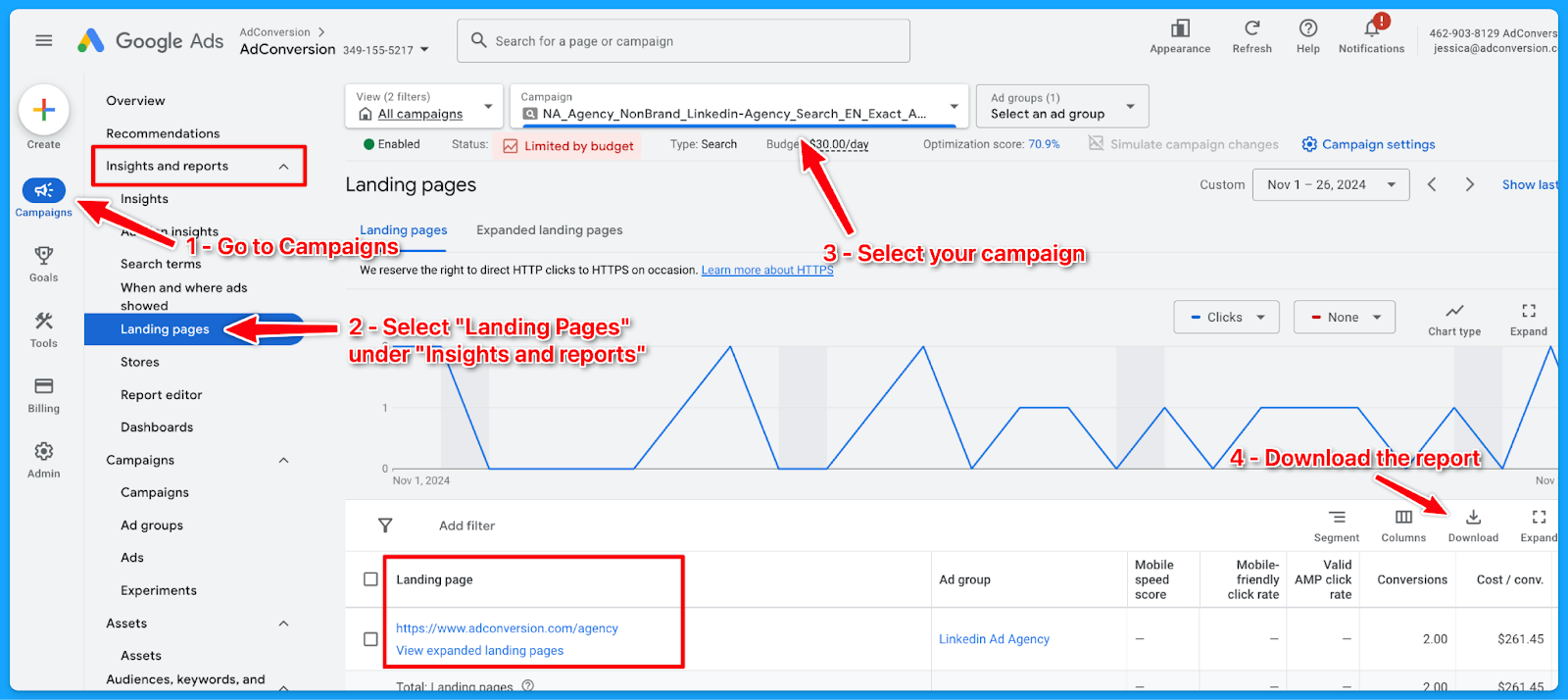
6. What is the spread of budget and performance by match type?
If you are separating the campaigns by match type, break out the campaign as such (Exact, Phrase, Broad)
👉 Check out the Part 7 video above if you need a walkthrough on the data analysis methodology using Excel.
Here’s how to download the match type report:
- Select “Campaigns” on the left-hand side
- Go to “Search Keywords”, under “Audiences, keywords, and content”
- Select the desired campaign
- Add the column “Match type”
- Download the data
- On Excel, summarize into a pivot table to get:some text
- Ad spent
- Conversions
- Cost per conversion
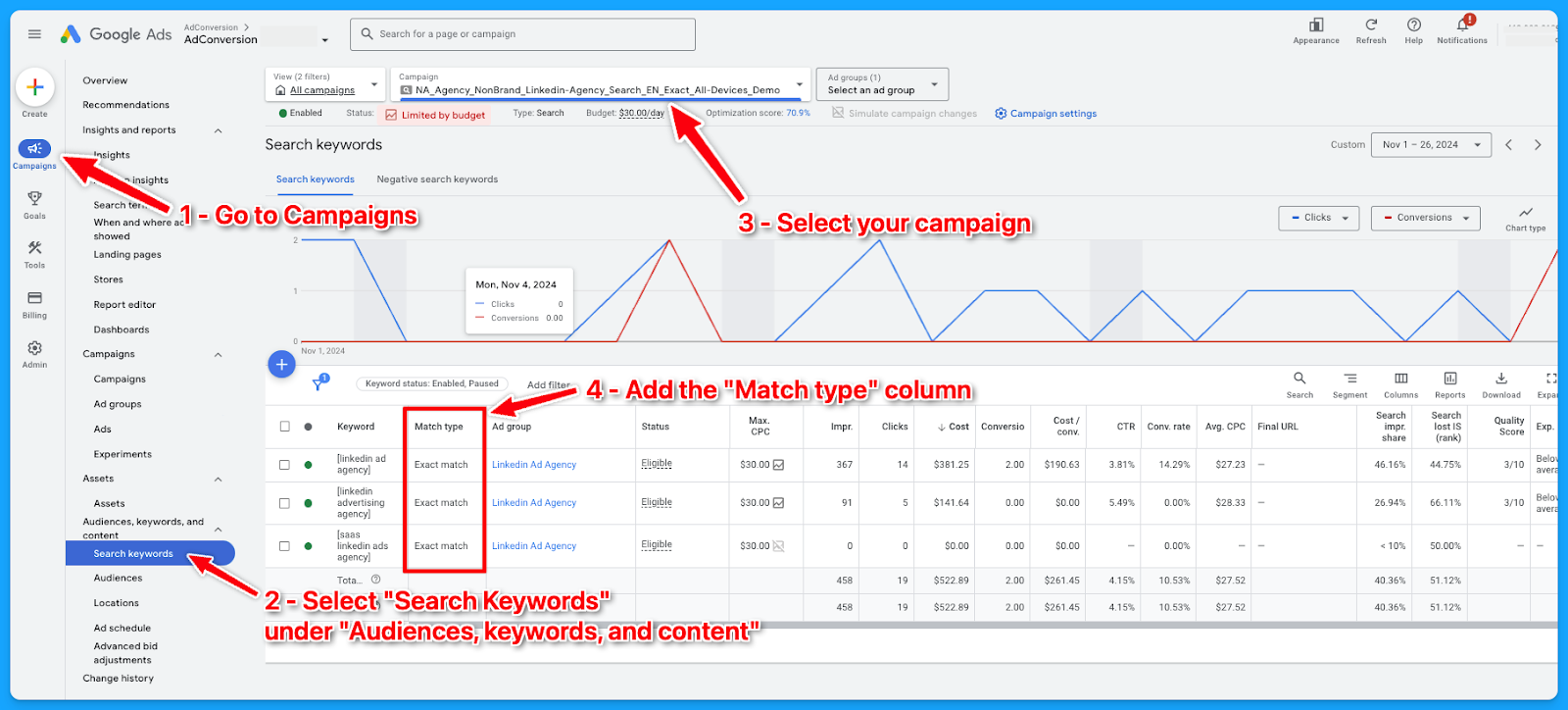
7. What is the spread of budget and performance by device?
If you are separating the campaigns by devices, break out the campaign as such (Desktop, Mobile, Tablet, All Devices)
👉 Check out the Part 7 video above if you need a walkthrough on the data analysis methodology using Excel.
If the campaigns are not separated into devices, here’s how you can check the spread of budget and performance by device downloading the device report:
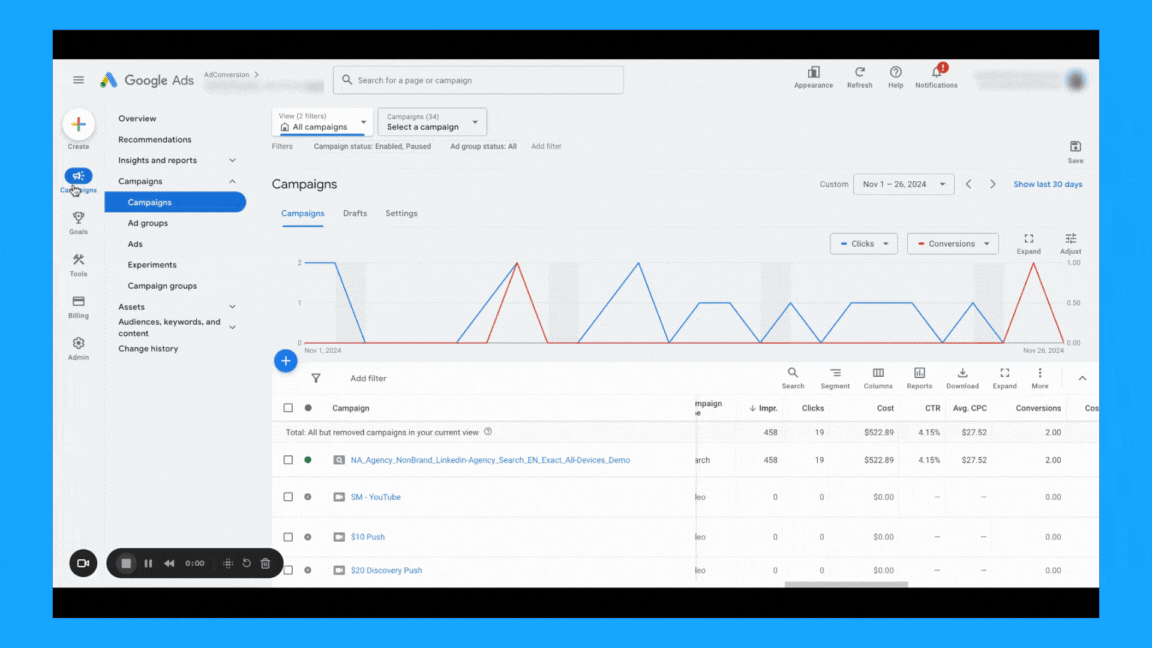
8. What is the spread of budget and performance by week days?
Check if you’re targeting all days of the week and if there’s opportunities to exclude some days when the performance is not good, so you can free up budget for the strongest days.Here’s how to download the day of the week report:
- Select “Campaigns” on the left-hand side
- Go to “When and where ads showed”, under “Insights and reportst”
- Select the desired campaign
- Choose “Day” in the right-side navigation if you only want to see the day of the week
- Download the data
- On Excel, summarize into a pivot table to get:some text
- Ad spent
- Conversions
- Cost per conversion
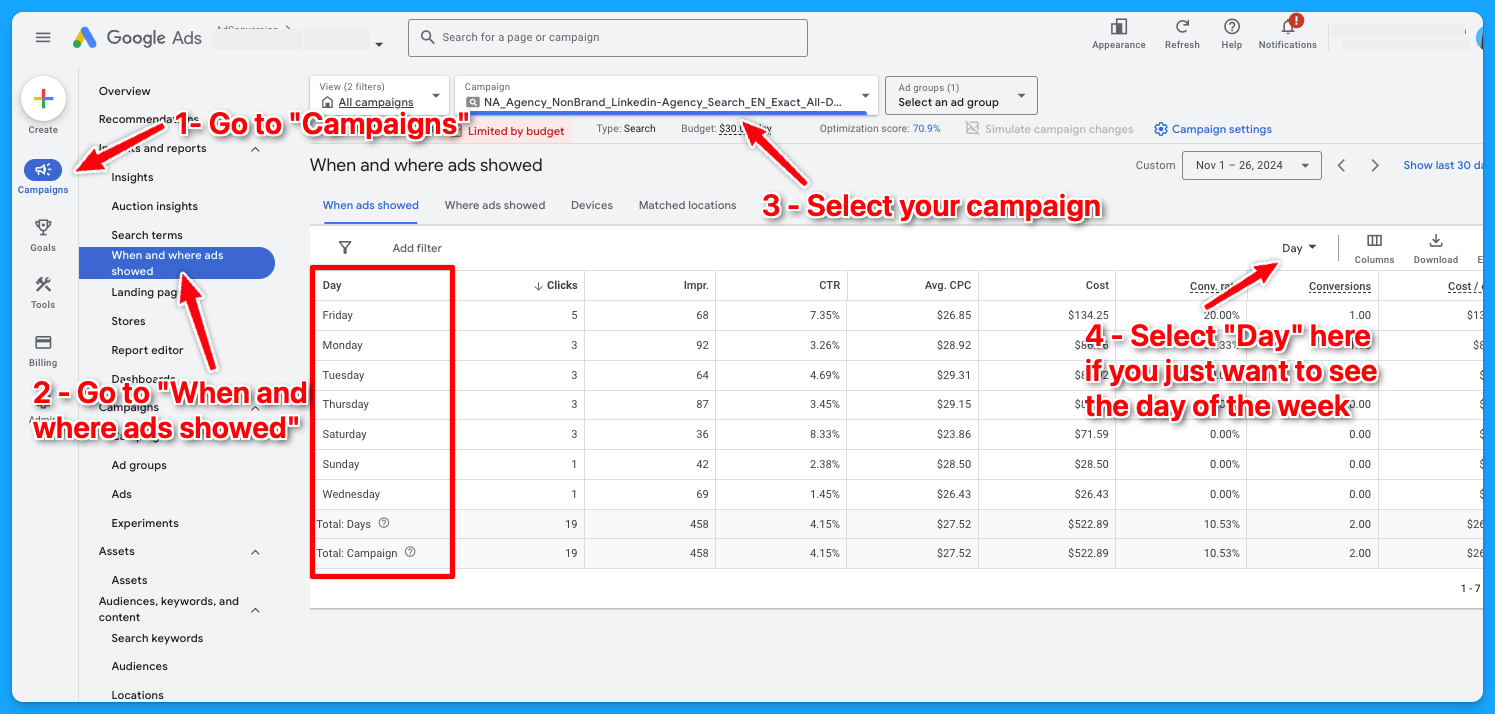
To learn more about how to create a winning Google Ads budget strategy, dive into the article below:
How to Create a Winning Google Ads Budget Strategy for B2B SaaS
Part 8 - Visibility Review
Here’s where we will talk more about Impression Share and Quality Score.
1. What is the search impression share by campaign theme? (NonBrand, Brand, Competitive, RLSA, Content)
There are different ways you can see the impression share by the campaign theme.
You can use Excel as I showed previously in Part 7, or you can go into your account and filter by campaign name, assuming you have good campaign naming conventions.
👉 Check out the Part 8 video above if you need a walkthrough on how to find this data.

2. What is the search lost rank by campaign theme? (NonBrand, Brand, Competitive, RLSA, Content)
The process here is the same from the previous task. The only difference is that you need to add the “Search lost IS (rank)” column.
👉 Check out the Part 8 video above if you need a walkthrough on how to find this data.
3. What is the search lost to budget by campaign theme? (NonBrand, Brand, Competitive, RLSA, Content)
The process here is the same from the previous tasks. The only difference is that you need to add the “Search lost IS (budget)” column.
👉 Check out the Part 8 video above if you need a walkthrough on how to find this data.
4. What is the search top IS by campaign theme? (NonBrand, Brand, Competitive, RLSA, Content)
The process here is the same from the previous tasks. The only difference is that you need to add the “Search top IS” column.
👉 Check out the Part 8 video above if you need a walkthrough on how to find this data.
5. Do 70% of your keywords have above 7 quality scores?
This is something I learned from Brad Geddes years ago, the OG of Google Ads.
Check the video below to see a complete guide on Quality Score and how to perform a Quality Score analysis:
6. What aspects of quality score do you need to improve?
After going going through the data in the previous task, summarize your findings to know where you have opportunities to improve.
Example:
- 100% of keywords have a Quality Score below 7.
- 94% of keywords are rated as “Below Average” for landing page experience.
- 45% have “Above Average” ad relevance.
- 100% have “Below Average” expected CTR.
Optimization strategies you can adopt to improve your Quality Score:
- Improve Landing Page Experience:
- Ensure pages are fast, relevant, and mobile-friendly
- Align ad copy with landing page content for a seamless message match.
- Ensure pages are fast, relevant, and mobile-friendly
- Refine Ad Relevance
- Group keywords into tightly themed ad groups.
- Write ads tailored to the specific intent of each group.
- Group keywords into tightly themed ad groups.
- Boost Expected CTR
- Test compelling ad headlines and descriptions.
- Use ad extensions to enhance visibility and clickability.
- Test compelling ad headlines and descriptions.
I hope you received a ton of value from this Google Ads Audit guide.
If you have any questions, feel free to connect with me on LinkedIn.
From Clicks to Conversions: Master Google Ads for B2B 🔥
If you want to become a Google Ads pro, check out our free B2B Google Ads courses, where you'll learn how to launch, optimize, and scale your campaigns to drive pipeline and revenue.

Here's what you'll learn in each course:
⚙️ B2B Google Ads 101 - How to Launch Dangerously Effective Campaigns for Beginners
- The Googleverse: The Game You're Playing & How To Win
- Measurement: How to Make Sure You're Profitable
- Targeting: How to Show Up For the Right Searcher
- Planning: Putting It All Together
🎯 Google Ads 102 - How to Clicks Into Profit
- Visibility: How To Find the Hole Sucking Profits
- Workflows: How to Optimize On a Daily, Weekly, Monthly & Quarterly Basis
- Experimentation: How to Test & Automate Profitability
- Troubleshooting: How To Solve Inevitable Problems
🚀 Google Ads 103 - How to Scale Google Ads For Advanced Advertisers
- Methodology: How to Vertically Scale Google Ads From A-Z
- Campaigns: Scaling Horizontally Through Campaign Themes
- Channels: Scaling Outside of Paid Search
Click Here to Join 1,000+ B2B Marketers Today and start leveling up your advertising skill set.
Takes < 90 seconds to sign up (seriously we timed it 😂)
People Also Ask
How can a Google Ads audit improve my campaign performance?
- A Google Ads audit can significantly enhance your campaign performance by identifying inefficiencies and areas for optimization within your account.
How often should I conduct a Google Ads audit?
- It is recommended to conduct a Google Ads audit at least once every quarter. For accounts with significant spending or those in highly competitive industries, more frequent audits may be beneficial to stay ahead of competitors and efficiently manage advertising spend.
What are the key components of a Google Ads audit?
- Budget Allocation: Analyzing how the budget is distributed across various channels and campaigns to identify opportunities for reallocation.
- Campaign Themes: Reviewing the balance between branded, non-branded, and competitive campaigns to ensure optimal allocation for reaching new customers.
- Device Usage: Evaluating performance across devices (mobile, computer, tablet, TV) to tailor strategies for each device type.
- Match Types: Assessing the use of exact, phrase, and broad match types in campaigns to ensure efficient targeting.
- Quality Score: Examining the quality score of keywords, focusing on ad relevance, landing page experience, and expected CTR to identify areas for improvement.
- Visibility Metrics: Analyzing impression share and losses due to rank and budget to optimize bid strategies and campaign visibility.
How often should I perform a Google Ads audit?
It’s recommended to conduct a comprehensive audit at least quarterly. However, for high-spending accounts or during periods of significant change (e.g., new product launches or market shifts), more frequent audits may be beneficial.
Can I perform a Google Ads audit myself, or should I hire a professional?
While self-auditing is possible, hiring a professional can provide deeper insights and a fresh perspective. Professionals are often equipped with advanced tools and expertise to identify issues that might be overlooked otherwise.

Heading 1
Heading 2
Heading 3
Heading 4
Heading 5
Heading 6
Lorem ipsum dolor sit amet, consectetur adipiscing elit, sed do eiusmod tempor incididunt ut labore et dolore magna aliqua. Ut enim ad minim veniam, quis nostrud exercitation ullamco laboris nisi ut aliquip ex ea commodo consequat. Duis aute irure dolor in reprehenderit in voluptate velit esse cillum dolore eu fugiat nulla pariatur.
Block quote
Ordered list
- Item 1
- Item 2
- Item 3
Unordered list
- Item A
- Item B
- Item C
Bold text
Emphasis
Superscript
Subscript


Heading
Heading 1
Heading 2
Heading 3
Heading 4
Heading 5
Heading 6
Lorem ipsum dolor sit amet, consectetur adipiscing elit, sed do eiusmod tempor incididunt ut labore et dolore magna aliqua. Ut enim ad minim veniam, quis nostrud exercitation ullamco laboris nisi ut aliquip ex ea commodo consequat. Duis aute irure dolor in reprehenderit in voluptate velit esse cillum dolore eu fugiat nulla pariatur.
Block quote
Ordered list
- Item 1
- Item 2
- Item 3
Unordered list
- Item A
- Item B
- Item C
Bold text
Emphasis
Superscript
Subscript


Heading
Heading 1
Heading 2
Heading 3
Heading 4
Heading 5
Heading 6
Lorem ipsum dolor sit amet, consectetur adipiscing elit, sed do eiusmod tempor incididunt ut labore et dolore magna aliqua. Ut enim ad minim veniam, quis nostrud exercitation ullamco laboris nisi ut aliquip ex ea commodo consequat. Duis aute irure dolor in reprehenderit in voluptate velit esse cillum dolore eu fugiat nulla pariatur.
Block quote
Ordered list
- Item 1
- Item 2
- Item 3
Unordered list
- Item A
- Item B
- Item C
Bold text
Emphasis
Superscript
Subscript


Heading
Heading 1
Heading 2
Heading 3
Heading 4
Heading 5
Heading 6
Lorem ipsum dolor sit amet, consectetur adipiscing elit, sed do eiusmod tempor incididunt ut labore et dolore magna aliqua. Ut enim ad minim veniam, quis nostrud exercitation ullamco laboris nisi ut aliquip ex ea commodo consequat. Duis aute irure dolor in reprehenderit in voluptate velit esse cillum dolore eu fugiat nulla pariatur.
Block quote
Ordered list
- Item 1
- Item 2
- Item 3
Unordered list
- Item A
- Item B
- Item C
Bold text
Emphasis
Superscript
Subscript


Heading
Heading 1
Heading 2
Heading 3
Heading 4
Heading 5
Heading 6
Lorem ipsum dolor sit amet, consectetur adipiscing elit, sed do eiusmod tempor incididunt ut labore et dolore magna aliqua. Ut enim ad minim veniam, quis nostrud exercitation ullamco laboris nisi ut aliquip ex ea commodo consequat. Duis aute irure dolor in reprehenderit in voluptate velit esse cillum dolore eu fugiat nulla pariatur.
Block quote
Ordered list
- Item 1
- Item 2
- Item 3
Unordered list
- Item A
- Item B
- Item C
Bold text
Emphasis
Superscript
Subscript


Heading
Heading 1
Heading 2
Heading 3
Heading 4
Heading 5
Heading 6
Lorem ipsum dolor sit amet, consectetur adipiscing elit, sed do eiusmod tempor incididunt ut labore et dolore magna aliqua. Ut enim ad minim veniam, quis nostrud exercitation ullamco laboris nisi ut aliquip ex ea commodo consequat. Duis aute irure dolor in reprehenderit in voluptate velit esse cillum dolore eu fugiat nulla pariatur.
Block quote
Ordered list
- Item 1
- Item 2
- Item 3
Unordered list
- Item A
- Item B
- Item C
Bold text
Emphasis
Superscript
Subscript


Heading
Heading 1
Heading 2
Heading 3
Heading 4
Heading 5
Heading 6
Lorem ipsum dolor sit amet, consectetur adipiscing elit, sed do eiusmod tempor incididunt ut labore et dolore magna aliqua. Ut enim ad minim veniam, quis nostrud exercitation ullamco laboris nisi ut aliquip ex ea commodo consequat. Duis aute irure dolor in reprehenderit in voluptate velit esse cillum dolore eu fugiat nulla pariatur.
Block quote
Ordered list
- Item 1
- Item 2
- Item 3
Unordered list
- Item A
- Item B
- Item C
Bold text
Emphasis
Superscript
Subscript


Heading
Heading 1
Heading 2
Heading 3
Heading 4
Heading 5
Heading 6
Lorem ipsum dolor sit amet, consectetur adipiscing elit, sed do eiusmod tempor incididunt ut labore et dolore magna aliqua. Ut enim ad minim veniam, quis nostrud exercitation ullamco laboris nisi ut aliquip ex ea commodo consequat. Duis aute irure dolor in reprehenderit in voluptate velit esse cillum dolore eu fugiat nulla pariatur.
Block quote
Ordered list
- Item 1
- Item 2
- Item 3
Unordered list
- Item A
- Item B
- Item C
Bold text
Emphasis
Superscript
Subscript


Heading
Heading 1
Heading 2
Heading 3
Heading 4
Heading 5
Heading 6
Lorem ipsum dolor sit amet, consectetur adipiscing elit, sed do eiusmod tempor incididunt ut labore et dolore magna aliqua. Ut enim ad minim veniam, quis nostrud exercitation ullamco laboris nisi ut aliquip ex ea commodo consequat. Duis aute irure dolor in reprehenderit in voluptate velit esse cillum dolore eu fugiat nulla pariatur.
Block quote
Ordered list
- Item 1
- Item 2
- Item 3
Unordered list
- Item A
- Item B
- Item C
Bold text
Emphasis
Superscript
Subscript


Heading
Heading 1
Heading 2
Heading 3
Heading 4
Heading 5
Heading 6
Lorem ipsum dolor sit amet, consectetur adipiscing elit, sed do eiusmod tempor incididunt ut labore et dolore magna aliqua. Ut enim ad minim veniam, quis nostrud exercitation ullamco laboris nisi ut aliquip ex ea commodo consequat. Duis aute irure dolor in reprehenderit in voluptate velit esse cillum dolore eu fugiat nulla pariatur.
Block quote
Ordered list
- Item 1
- Item 2
- Item 3
Unordered list
- Item A
- Item B
- Item C
Bold text
Emphasis
Superscript
Subscript


Heading
Heading 1
Heading 2
Heading 3
Heading 4
Heading 5
Heading 6
Lorem ipsum dolor sit amet, consectetur adipiscing elit, sed do eiusmod tempor incididunt ut labore et dolore magna aliqua. Ut enim ad minim veniam, quis nostrud exercitation ullamco laboris nisi ut aliquip ex ea commodo consequat. Duis aute irure dolor in reprehenderit in voluptate velit esse cillum dolore eu fugiat nulla pariatur.
Block quote
Ordered list
- Item 1
- Item 2
- Item 3
Unordered list
- Item A
- Item B
- Item C
Bold text
Emphasis
Superscript
Subscript


Heading
Heading 1
Heading 2
Heading 3
Heading 4
Heading 5
Heading 6
Lorem ipsum dolor sit amet, consectetur adipiscing elit, sed do eiusmod tempor incididunt ut labore et dolore magna aliqua. Ut enim ad minim veniam, quis nostrud exercitation ullamco laboris nisi ut aliquip ex ea commodo consequat. Duis aute irure dolor in reprehenderit in voluptate velit esse cillum dolore eu fugiat nulla pariatur.
Block quote
Ordered list
- Item 1
- Item 2
- Item 3
Unordered list
- Item A
- Item B
- Item C
Bold text
Emphasis
Superscript
Subscript


Heading
Heading 1
Heading 2
Heading 3
Heading 4
Heading 5
Heading 6
Lorem ipsum dolor sit amet, consectetur adipiscing elit, sed do eiusmod tempor incididunt ut labore et dolore magna aliqua. Ut enim ad minim veniam, quis nostrud exercitation ullamco laboris nisi ut aliquip ex ea commodo consequat. Duis aute irure dolor in reprehenderit in voluptate velit esse cillum dolore eu fugiat nulla pariatur.
Block quote
Ordered list
- Item 1
- Item 2
- Item 3
Unordered list
- Item A
- Item B
- Item C
Bold text
Emphasis
Superscript
Subscript


Heading
Heading 1
Heading 2
Heading 3
Heading 4
Heading 5
Heading 6
Lorem ipsum dolor sit amet, consectetur adipiscing elit, sed do eiusmod tempor incididunt ut labore et dolore magna aliqua. Ut enim ad minim veniam, quis nostrud exercitation ullamco laboris nisi ut aliquip ex ea commodo consequat. Duis aute irure dolor in reprehenderit in voluptate velit esse cillum dolore eu fugiat nulla pariatur.
Block quote
Ordered list
- Item 1
- Item 2
- Item 3
Unordered list
- Item A
- Item B
- Item C
Bold text
Emphasis
Superscript
Subscript


Heading
Heading 1
Heading 2
Heading 3
Heading 4
Heading 5
Heading 6
Lorem ipsum dolor sit amet, consectetur adipiscing elit, sed do eiusmod tempor incididunt ut labore et dolore magna aliqua. Ut enim ad minim veniam, quis nostrud exercitation ullamco laboris nisi ut aliquip ex ea commodo consequat. Duis aute irure dolor in reprehenderit in voluptate velit esse cillum dolore eu fugiat nulla pariatur.
Block quote
Ordered list
- Item 1
- Item 2
- Item 3
Unordered list
- Item A
- Item B
- Item C
Bold text
Emphasis
Superscript
Subscript


Heading
Heading 1
Heading 2
Heading 3
Heading 4
Heading 5
Heading 6
Lorem ipsum dolor sit amet, consectetur adipiscing elit, sed do eiusmod tempor incididunt ut labore et dolore magna aliqua. Ut enim ad minim veniam, quis nostrud exercitation ullamco laboris nisi ut aliquip ex ea commodo consequat. Duis aute irure dolor in reprehenderit in voluptate velit esse cillum dolore eu fugiat nulla pariatur.
Block quote
Ordered list
- Item 1
- Item 2
- Item 3
Unordered list
- Item A
- Item B
- Item C
Bold text
Emphasis
Superscript
Subscript


Heading
Heading 1
Heading 2
Heading 3
Heading 4
Heading 5
Heading 6
Lorem ipsum dolor sit amet, consectetur adipiscing elit, sed do eiusmod tempor incididunt ut labore et dolore magna aliqua. Ut enim ad minim veniam, quis nostrud exercitation ullamco laboris nisi ut aliquip ex ea commodo consequat. Duis aute irure dolor in reprehenderit in voluptate velit esse cillum dolore eu fugiat nulla pariatur.
Block quote
Ordered list
- Item 1
- Item 2
- Item 3
Unordered list
- Item A
- Item B
- Item C
Bold text
Emphasis
Superscript
Subscript


Heading
Heading 1
Heading 2
Heading 3
Heading 4
Heading 5
Heading 6
Lorem ipsum dolor sit amet, consectetur adipiscing elit, sed do eiusmod tempor incididunt ut labore et dolore magna aliqua. Ut enim ad minim veniam, quis nostrud exercitation ullamco laboris nisi ut aliquip ex ea commodo consequat. Duis aute irure dolor in reprehenderit in voluptate velit esse cillum dolore eu fugiat nulla pariatur.
Block quote
Ordered list
- Item 1
- Item 2
- Item 3
Unordered list
- Item A
- Item B
- Item C
Bold text
Emphasis
Superscript
Subscript


Heading
Heading 1
Heading 2
Heading 3
Heading 4
Heading 5
Heading 6
Lorem ipsum dolor sit amet, consectetur adipiscing elit, sed do eiusmod tempor incididunt ut labore et dolore magna aliqua. Ut enim ad minim veniam, quis nostrud exercitation ullamco laboris nisi ut aliquip ex ea commodo consequat. Duis aute irure dolor in reprehenderit in voluptate velit esse cillum dolore eu fugiat nulla pariatur.
Block quote
Ordered list
- Item 1
- Item 2
- Item 3
Unordered list
- Item A
- Item B
- Item C
Bold text
Emphasis
Superscript
Subscript


Heading
Heading 1
Heading 2
Heading 3
Heading 4
Heading 5
Heading 6
Lorem ipsum dolor sit amet, consectetur adipiscing elit, sed do eiusmod tempor incididunt ut labore et dolore magna aliqua. Ut enim ad minim veniam, quis nostrud exercitation ullamco laboris nisi ut aliquip ex ea commodo consequat. Duis aute irure dolor in reprehenderit in voluptate velit esse cillum dolore eu fugiat nulla pariatur.
Block quote
Ordered list
- Item 1
- Item 2
- Item 3
Unordered list
- Item A
- Item B
- Item C
Bold text
Emphasis
Superscript
Subscript


Heading
Other Articles You May Enjoy.

How to Choose The Best Ad Platforms For B2B SaaS
Don’t want to make a mistake investing in an ad platform that won’t work?
Regardless of what you hear online, no one can promise you that ( including me).
But thankfully success leaves clues and we surveyed 60 B2B marketers to find the answer.
So regardless if you’re a new advertiser, startup founder, or agency owner reading this.
We’ve got you covered, let’s dive in 👇
TABLE OF CONTENTS:
- Where can you advertise online?
- How to decide on the best ad platform?
- Which ad platforms are best for B2B lead generation?
- Which ad platforms are best for B2B awareness?
- Which ad platforms are most popular for B2B?
- Which ad platforms are most B2B marketers planning to invest in?
- Making your final decision on where to advertise
Where can you advertise online?
There is no shortage of opportunities where you can advertise online.
Most channels can be grouped into these five primary categories:
This isn’t an exhaustive list of every available ad platform but it gives you a sense of what’s possible.
Now that you’re aware of the various ad platforms available, how do you decide which to choose?
How to decide on the best ad platform?
When considering investing in a new ad platform here’s four key criteria to consider:
With these four criteria in mind let’s go through the qualitative results from our study and what B2B marketers have reported as their best ad platforms.
Which ad platforms are best for B2B lead generation?
After reviewing the responses from 60 B2B marketers here’s what we found:
- 52.7% reported Google Ads
- 38.2% reported LinkedIn Ads
- 3.6% reported Facebook Ads
- 1.8% reported Capterra Ads
- 1.8% reported Instagram Ads
- 1.8% reported Native Ads

Which ad platforms are best for B2B awareness?
After reviewing the responses from 60 B2B marketers here’s what we found:
- 56.1% reported LinkedIn Ads
- 12.3% reported Facebook Ads
- 12.3% reported YouTube Ads
- 10.5% reported Google Ads
- 3.5% reported Connected TV
- 3.5% reported Display Ads
- 1.8% reported Instagram Ads

Which ad platforms are most popular for B2B?
After reviewing the responses from 60 B2B marketers here’s what we found:
- 20.2% reported Google Ads
- 18.8% reported LinkedIn Ads
- 13.0% reported Facebook Ads
- 11.2% reported Instagram Ads
- 9.0% reported YouTube Ads
- 8.3% reported Microsoft Ads
- 5.8% reported Capterra Ads
- 5.& reported Display Ads
- 2.5% reported Reddit Ads
- 2.2% reported Native Ads
- 1.8% reported X (Twitter Ads)
- 1.1% reported Connected TV
- 0.4% reported Quora Ads

Which ad platforms are most B2B marketers planning to invest in?
After reviewing the responses from 60 B2B marketers here’s what we found:
- 13.5% reported YouTube Ads
- 12.1% reported X (Twitter) Ads
- 10.6% reported Reddit Ads
- 9.9% reported Connected TV
- 9.2% reported Audio Ads
- 7.8% reported Display Ads
- 7.1% reported Microsoft Ads
- 7.1% reportedFacebook Ads
- 7.1% reported Capterra Ads
- 5.7% reported Instagram Ads
- 4.3% reported Native Ads
- 3.5% reported Apple Search Ads
- 1.4% reported LinkedIn Ads
- 0.7% reported Tiktok Ads

Making your final decision on where to advertise
All in all take these survey results as suggestions to see what other B2B marketers are reporting is working for them and what platforms they’re interested in exploring.
Ultimately don’t forget the four key criteria when making your decision of where to advertise.
When you finally decide, run a small pilot of $100-$1,000 just to get your baselines.
From here you’ll have a better idea of if this channel will make sense.
Hope you found this article helpful!
Resources for mastering B2B advertising
If you’re serious about mastering B2B advertising then you definitely need to join 1,000+ B2B marketers leveling up their paid advertising skill sets in AdConversion.
Here’s 4 reasons why you should consider joining. Every one of our on-demand courses are:
✅ 100% free access.
✅ Taught by vetted industry experts.
✅ Have workbooks, resources, and templates.
✅ Less than 10 minutes per lesson.
We believe every marketer should know how to scale paid ads so they can:
- Scale their ideas
- Level up their careers
- Make a positive impact
Click Here to Join 1,000+ B2B Marketers Today and start leveling up your advertising skill set.
Takes < 90 seconds to sign up (seriously we timed it 😂)
People Also Ask
Which ad platforms are most effective for B2B lead generation?
According to an AdConversion survey of 60 B2B marketers, the top platforms for lead generation are Google Ads and LinkedIn Ads.
What are the best ad platforms for building B2B brand awareness?
LinkedIn Ads is particularly effective for B2B brand awareness due to their professional audience.
What are the key metrics to monitor when evaluating the performance of ad campaigns across different platforms?
Focus on metrics such as click-through rates (CTR), conversion rates, cost per acquisition (CPA), and return on ad spend (ROAS). These indicators provide insights into the effectiveness and efficiency of your campaigns.
How can I effectively allocate my advertising budget across multiple platforms to maximize ROI?
Start with a diversified approach, allocating a portion of your budget to each platform. Monitor performance closely and reallocate funds towards platforms yielding higher returns, ensuring continuous optimization.
How can I stay updated on the latest trends and best practices in B2B SaaS advertising?
Regularly engage with industry blogs, attend webinars, and participate in professional networks. Staying informed about platform updates and emerging trends ensures your strategies remain current and effective.
What factors should be considered when choosing an ad platform for B2B SaaS marketing?
Key considerations include:
- Target Audience Alignment: Ensure the platform’s user base matches your ideal customer profile.
- Ad Format Suitability: Choose platforms offering ad formats that effectively convey your message.
- Budget and ROI: Assess the cost-effectiveness and potential return on investment.
- Platform Capabilities: Evaluate targeting options, analytics, and integration with your marketing stack.
Aligning these factors with your marketing objectives will help in selecting the most appropriate ad platform.
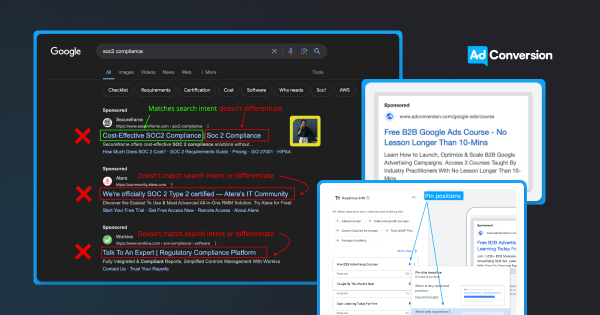
How to Write Effective Responsive Search Ads in 3 Simple Steps
Google Ads responsive search ads (RSA) don’t leave a ton of room available.
With 30 character headlines, and 90 character descriptions.
It’s tough to write persuasive and effective copy.
In this article you’ll learn a simple 3-step framework to write responsive search ads.
Let’s dive into it 👇
TABLE OF CONTENTS:
- The 3-Part RSA Writing Framework
- The Anatomy of a Responsive Search Ad
- Should you pin headlines and descriptions in Google Ads?
- Advanced copy tips for writing Responsive Search Ads
The 3-Part Google Ads RSA Writing Framework
Here's a simple 3-part framework for writing Google Ads copy:
- The goal of headline 1 = match intent
- The goal of headline 2 = differentiate between other results
- The goal of headline 3 = provide a clear CTA
Keyword: b2b google ads course
- H1: Free B2B Google Ads Course (matches intent)
- H2: No Lesson Longer Than 10-Mins (differentiates)
- H3: Join 1,000+ B2B Marketers (clear CTA)
Here's what it looks like in practice (image below):
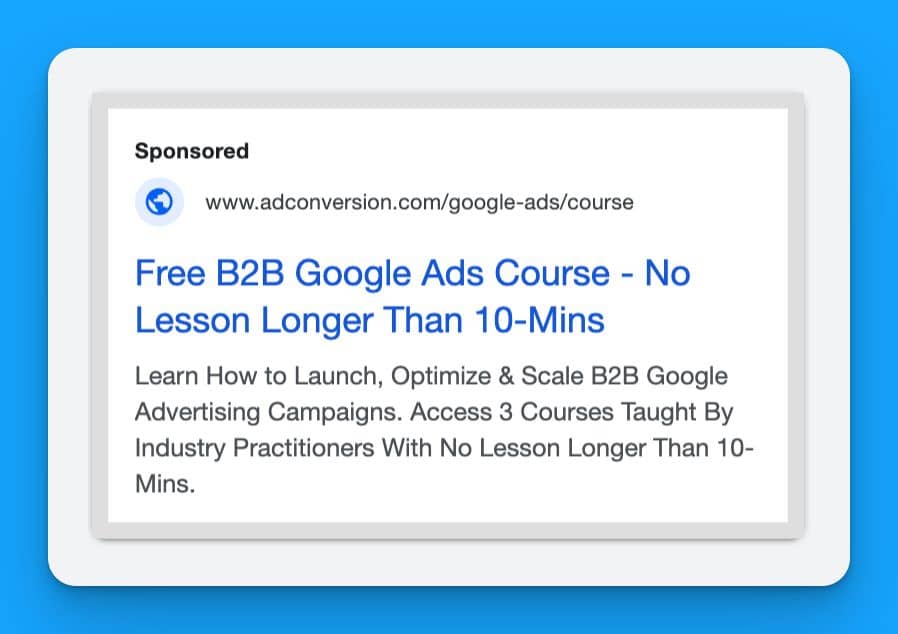
When writing, always assume the H3 isn't visible, and if only the H1 was displayed would they get it?
(Google is always testing different display variations)
From here you would write different variations per position.
With ensuring legibility between headline combinations.
Simple but effective ✌️let’s dive into each headline further.
The goal of headline 1 = match intent
You’ve got a fraction of a second for a prospect searching on Google to understand if your ad is relevant to their search term.
Don’t mess this up by being vague, asking rhetorical questions, or wasting valuable characters.

When it comes to Google Ads the headline 1 position would be eighty cents out of your dollar.
Maximize your headline 1 by adding the primary keyword in your copy to match intent.
This is such a simple thing to do, and equally not to.
The goal of headline 2 = differentiate between other results
Now that you’ve caught the searchers attention by matching intent it’s time to stand out.
Here’s a real example of what NOT to do from ads that appeared searching SOC2 compliance:
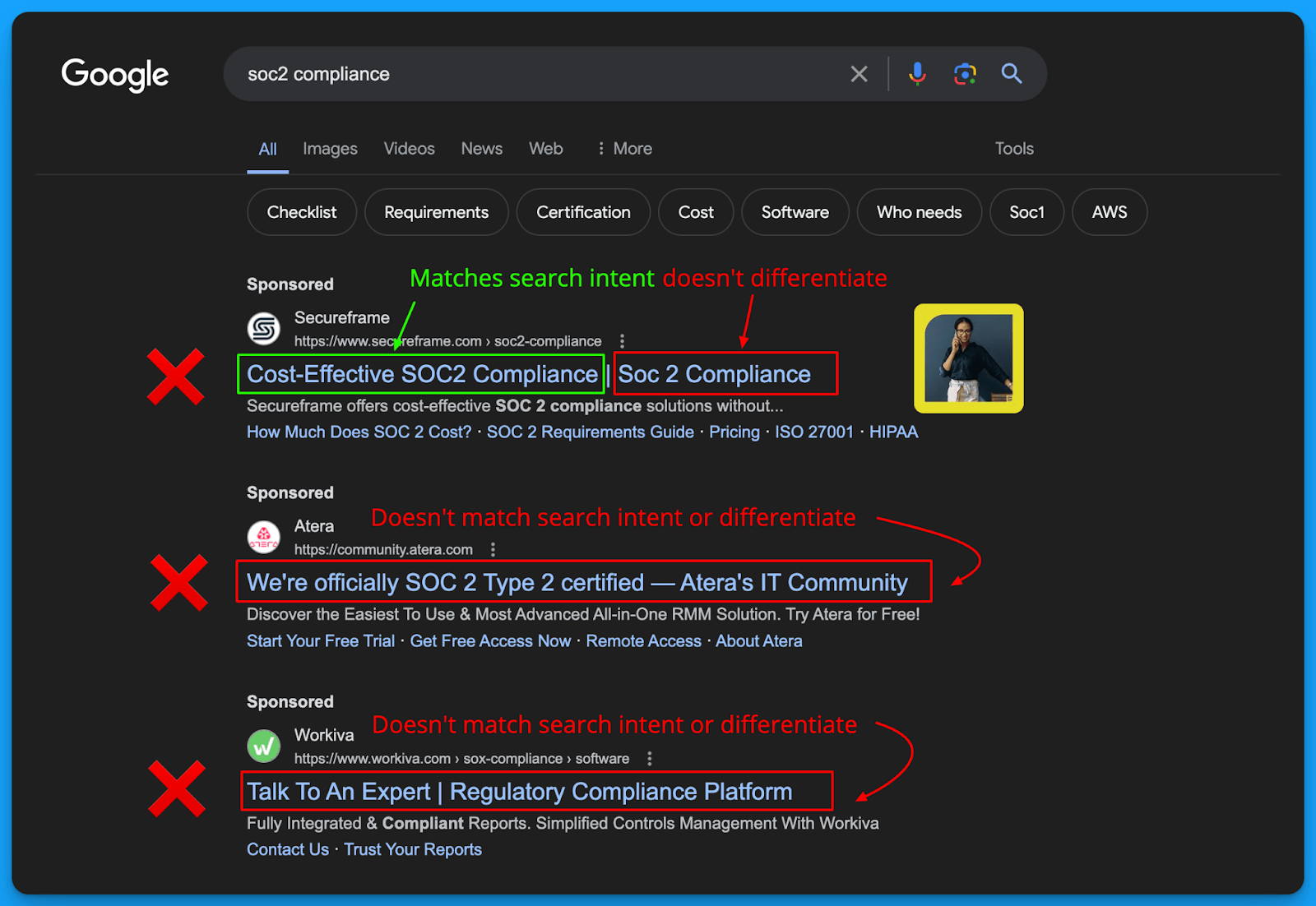
The sequence of which you write your headlines matter.
This is why I recommend following the 3-part framework as shown.
Use the headline 2 position to write a core benefit or outcome for differentiation.
The goal of headline 3 = provide a clear CTA
Finally in the third headline it’s time to provide a clear call to action.
This can be as simple as:
- Request a Demo
- See For Yourself
- Learn More Today!
When writing your H3 just assume it won’t be visible most of the time as Google is always experimenting with how they display headlines.
The Anatomy of a Responsive Search Ad
Now that you understand how to approach writing RSA copy.
Let’s discuss how responsive search ads actually function.
Character counts for Responsive Search Ads
- You can write up to 15 headlines, and 4 descriptions.
- 30 characters available per headline
- 90 characters available per description
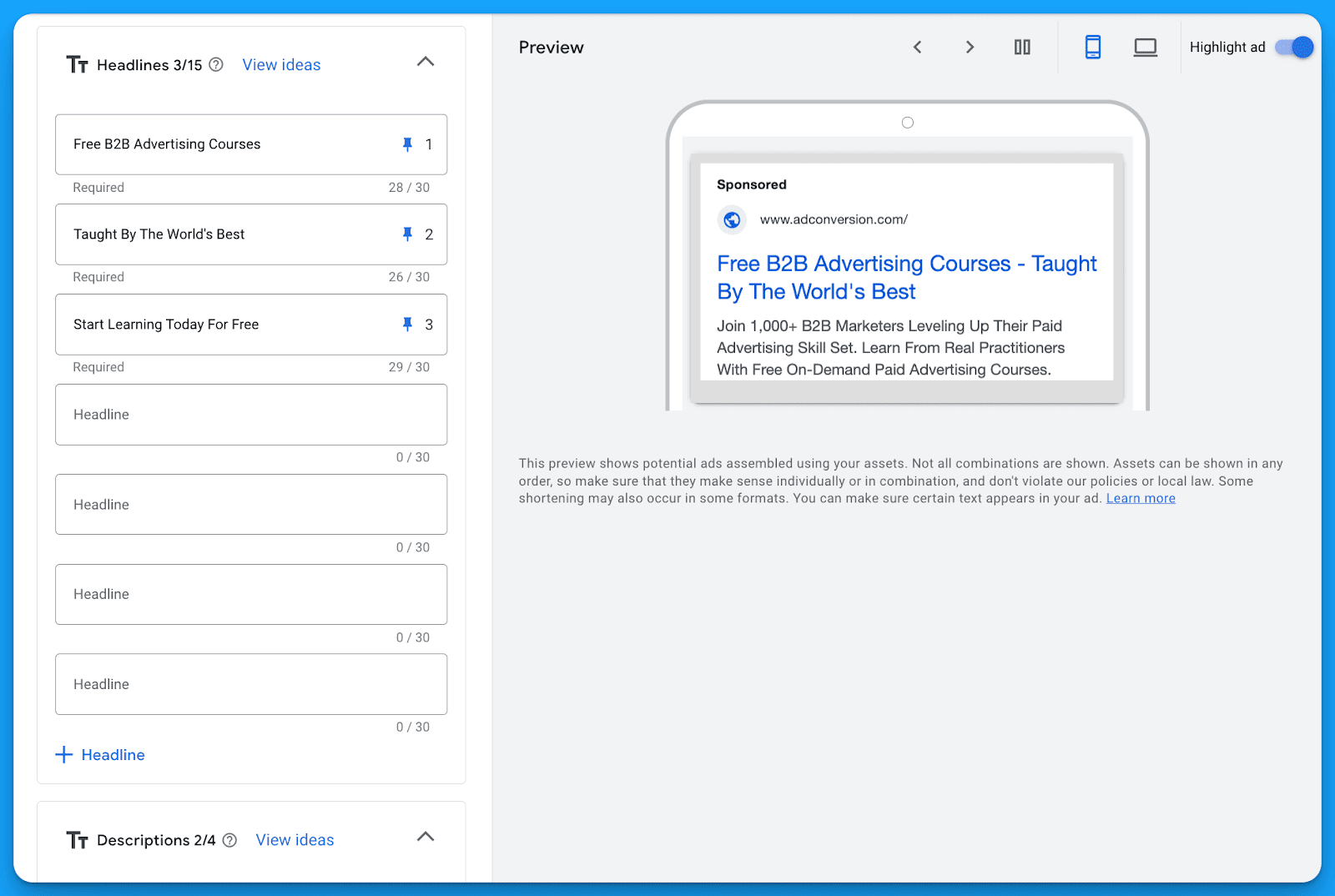
How Responsive Search Ads work
The idea behind responsive ads is Google will take your 15 headlines and 4 descriptions and automatically combine them to find the optimal variations based on machine learning.
The promise is you can leverage Google’s AI to do the heavy lifting as it will take into account a multitude of factors including keywords, search terms, devices, audience demographics and more.
Google also tries to guide advertisers on how well their doing when writing responsive search ads with their Ad Strength metric 💩(which we’ll cover in detail shortly).
With each headline and description you have the opportunity to pin positions.
This is where you’re forcing Google to only serve those variations within that specific placement.
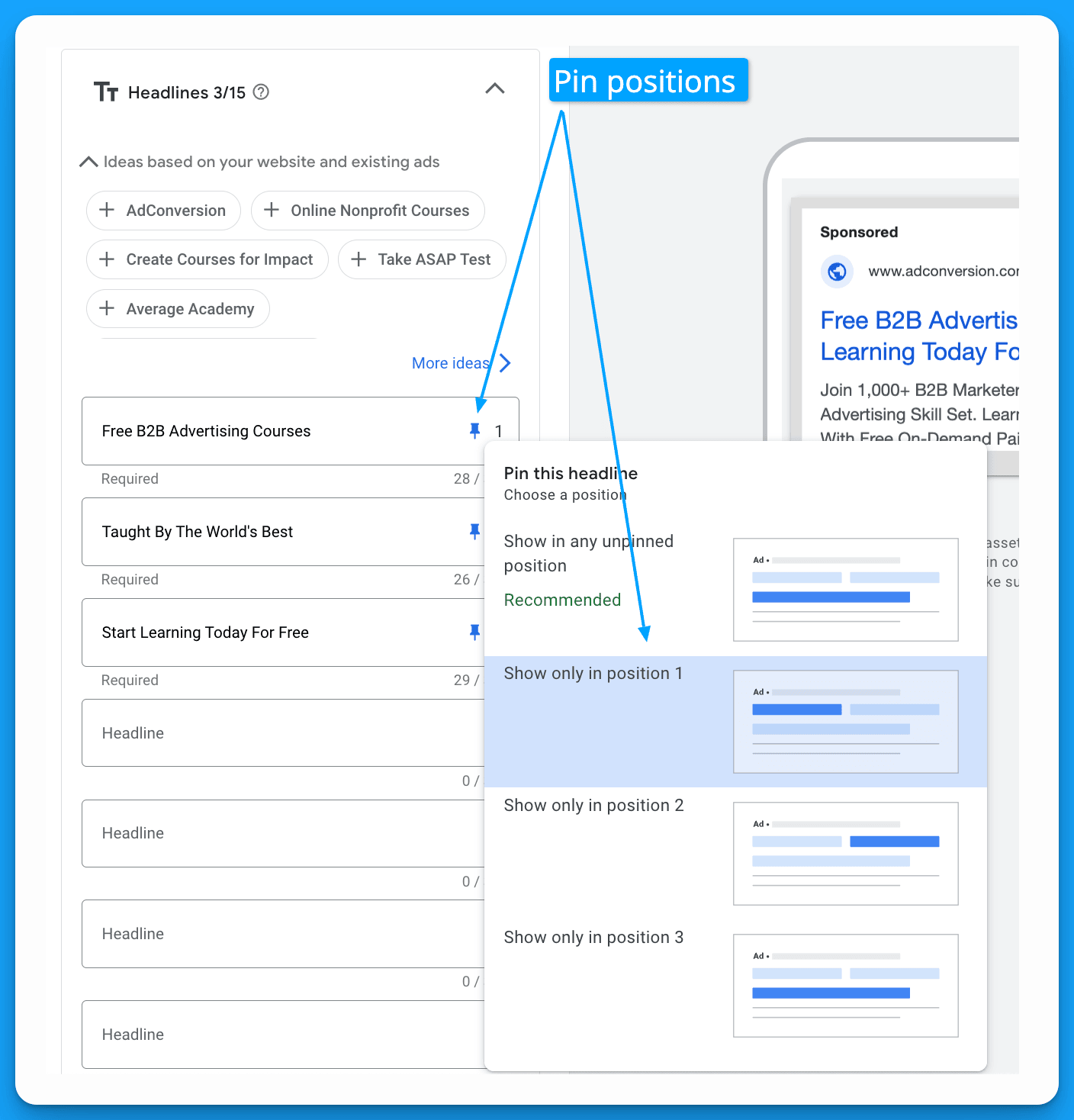
Should you pin headlines and descriptions in Google Ads?
The answer here is an unequivocal YES, because if your ads aren’t legible they won’t be clicked.
In a perfect world Google will automatically combine your headline and descriptions perfectly based on performance AND legibility but in reality it doesn’t happen.
Instead you end up with a bunch of variations like this:



I personally would LOVE ♥ ️ if Google’s AI can mix and match ads perfectly for performance and legibility but unfortunately the tech still isn’t there.
So in order to prevent this from happening I recommend strategic pinning.
How to pin Google Ads headlines strategically
In order to get the benefits of both Google’s AI to mix and match top performing headline/description combinations AND legibility you’ll need to pin strategically.
Here’s what it looks like in practice:
- Write 2-3 variations of Headline 1 and pin to position 1
- Write 2-3 variations of Headline 2 and pin to position 2
- Write 2-3 variations of Headline 3 and pin to position 3
- Write 2 variations of Description 1 and pin to position 1
- Write 2 variations of Description 2 and pin to position 2
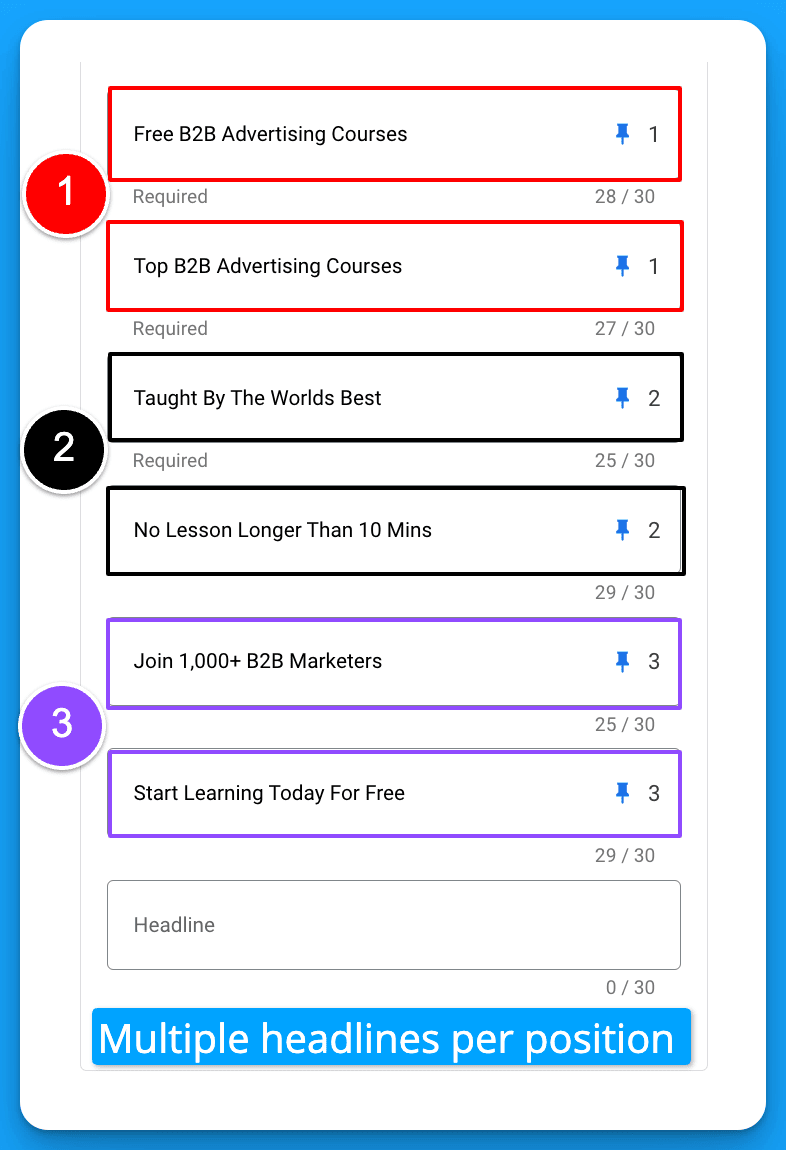
This will give you the benefit of testing multiple variations per position but safely as you can control which possible combinations are matched for legibility.
What is Ad strength and does it matter?
Ad strength is a score created by Google to help advertisers optimize their ad performance ranging from Incomplete → Poor → Average → Good → Excellent.
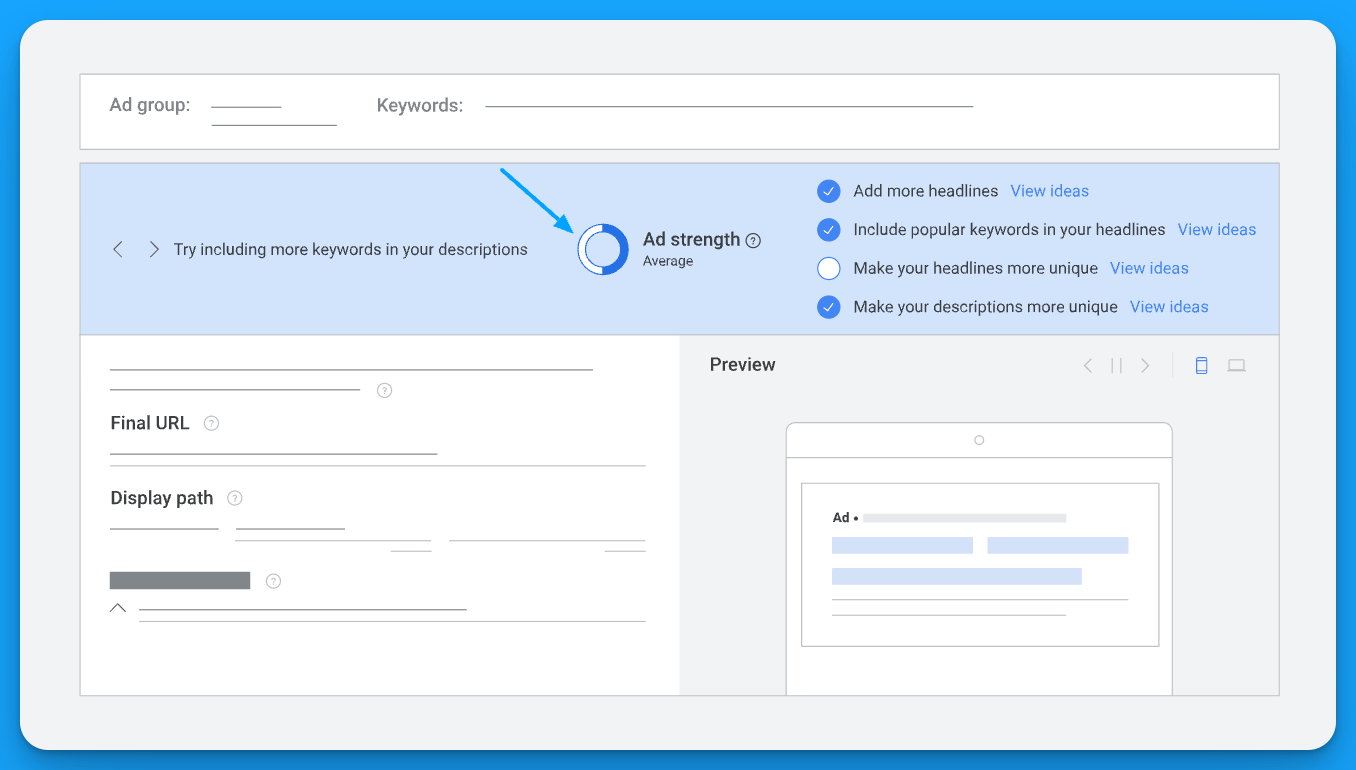
Ad strength misconceptions to be aware of
- Ad strength has ZERO bearing on actual performance, it's just a predictor of it.
- Having a poor ad strength doesn’t mean your ad won’t actually perform well.
- Having a poor ad strength doesn’t mean your ads won’t receive impressions.
What determines if your ad appears is your Ad Rank.

Pin strategically with 2-3 variations of headlines and you’ll be ok, it’s also what Google suggests if you decide to pin.
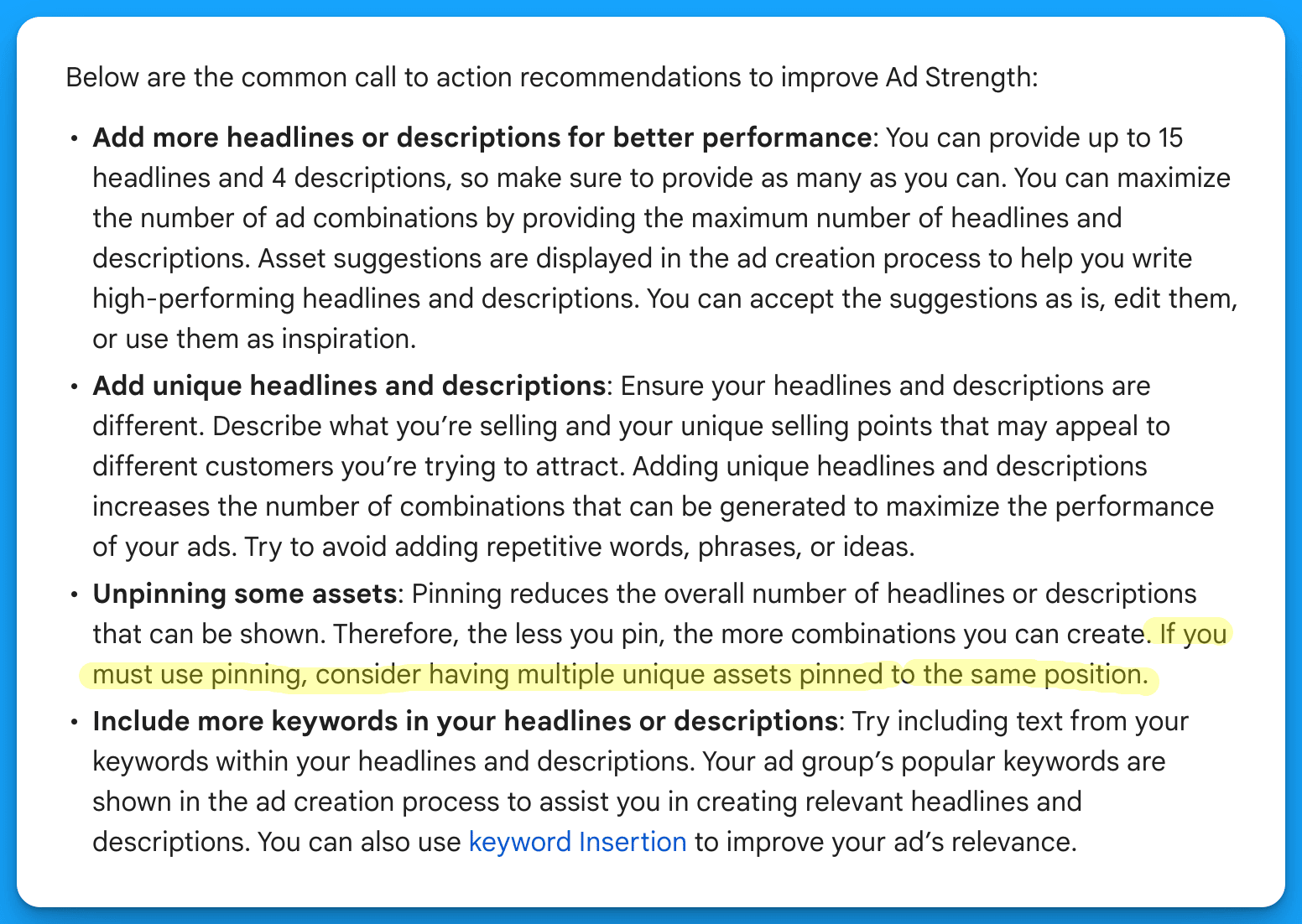
Advanced copy tips for writing Responsive Search Ads
Now that you know how to write effective responsive search ads let’s wrap with some advanced tips you can implement to make your ads perform even better.
Implement Dynamic Keyword Insertion (DKI)
Dynamic Keyword Insertion allows you to change your ad copy in real time based on the keywords that are triggering your ads in order to create more relevant experiences.
Currently there are 3 types of DKI available:
- Keyword Insertion = insert the keyword that triggers your ad
- Countdown = insert a timer that counts down to an event
- Location insertion = insert the location that triggers your ad
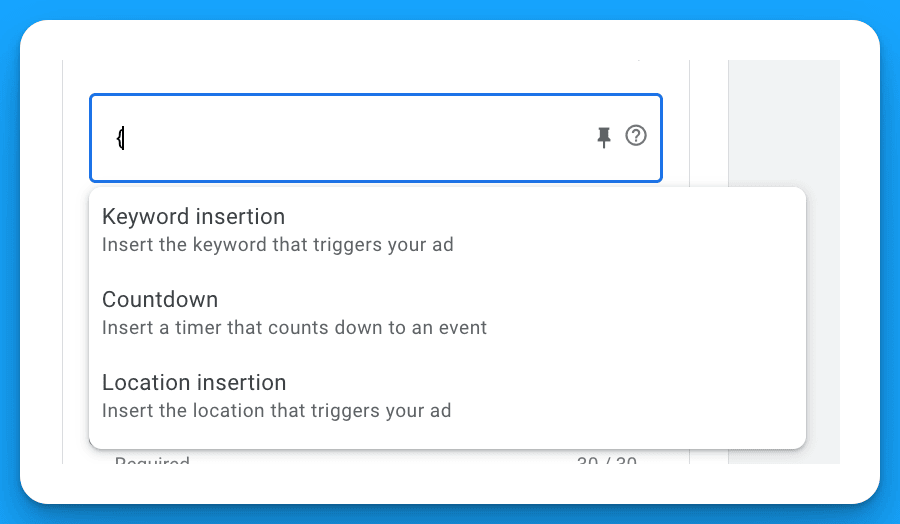
Test variations of your RSAs using relevant DKI parameters vs not to see if it impacts performance.
Leverage Business Name, Logo, and Image Ad Extensions
Now that Google allows you to highlight your business name and logo in your RSA, don't waste the characters anymore referencing your brand in your ad copy.
Save those valuable characters as you’re already getting brand awareness and instead maximize each character according to the 3-Part Google Ads RSA writing framework.
Ad extensions should always be used as a best practice but when it comes to writing effective Google Ads copy don’t forget to utilize your extensions to provide more information.
Hope you found this article helpful, best of luck on your next set of ads!
From Clicks to Conversions: Master Google Ads for B2B 🔥
If you want to become a Google Ads pro, check out our free B2B Google Ads courses, where you'll learn how to launch, optimize, and scale your campaigns to drive pipeline and revenue.

Here's what you'll learn in each course:
⚙️ B2B Google Ads 101 - How to Launch Dangerously Effective Campaigns for Beginners
- The Googleverse: The Game You're Playing & How To Win
- Measurement: How to Make Sure You're Profitable
- Targeting: How to Show Up For the Right Searcher
- Planning: Putting It All Together
🎯 Google Ads 102 - How to Clicks Into Profit
- Visibility: How To Find the Hole Sucking Profits
- Workflows: How to Optimize On a Daily, Weekly, Monthly & Quarterly Basis
- Experimentation: How to Test & Automate Profitability
- Troubleshooting: How To Solve Inevitable Problems
🚀 Google Ads 103 - How to Scale Google Ads For Advanced Advertisers
- Methodology: How to Vertically Scale Google Ads From A-Z
- Campaigns: Scaling Horizontally Through Campaign Themes
- Channels: Scaling Outside of Paid Search
Click Here to Join 1,000+ B2B Marketers Today and start leveling up your advertising skill set.
Takes < 90 seconds to sign up (seriously we timed it 😂)
People Also Ask
How can I effectively measure the performance of my RSAs?
Utilize Google’s Ad Strength indicator to assess the quality and relevance of your ads. Additionally, monitor key performance indicators (KPIs) such as click-through rates (CTR), conversion rates, and cost per conversion to evaluate ad effectiveness. 
What are the best practices for creating compelling headlines and descriptions in RSAs?
Develop diverse and unique headlines that highlight different aspects of your product or service. Incorporate relevant keywords in at least two headlines to improve ad relevance. Ensure that each headline and description provides distinct value to avoid redundancy.

Should I pin headlines and descriptions in my RSAs?
Strategically pinning headlines and descriptions can ensure legibility and relevance. Pinning specific headlines to designated positions helps maintain coherent messaging, especially when certain combinations may not make sense together. However, over-pinning can limit Google’s ability to optimize combinations. 
What role does Google’s machine learning play in the effectiveness of RSAs?
Google’s machine learning algorithms automatically test various combinations of headlines and descriptions to determine the most effective ad for each search query. By providing a diverse set of assets, you enable the system to optimize ad delivery and improve performance over time. 
How can I ensure my RSAs align with my overall marketing strategy?
Ensure that the messaging in your RSAs is consistent with your brand voice and marketing objectives. Regularly review ad performance data to make informed adjustments, and coordinate with other marketing channels to maintain a unified approach.

How to Create a Winning Google Ads Budget Strategy for B2B SaaS
Thinking about investing in Google Ads for your SaaS but not sure how much it will cost?
In this article I’ll break down how to create a winning budget strategy step by step.
You’ll walk away knowing how much you’ll need to invest on a daily, monthly, and quarterly basis.
And most importantly if Google Ads makes sense for your business.
Let’s dive into it 👇
TABLE OF CONTENTS:
- How much budget is required for a starting Google Ads budget?
- How to forecast a daily, monthly, and quarterly Google Ads budget
- How to allocate Google Ads budget by campaign strategy
- Frequently asked Google Ads budget questions
How much is required for a starting Google Ads budget?
This is the first question that usually comes to mind when considering Google Ads.
Which will then be met with a variation of questions such as:
- Is $10/day enough for Google Ads?
- Is $100/day enough for Google Ads?
- Is $1,000/day enough for Google Ads?
And so on, and so on…
When the reality is it’s all circumstantial based on the keywords you’re looking to target.
Equally important to how much is required is how many people are searching?
You could have a keyword that costs $0.01 per click but if only 5 people search is it really worth it?
So in order to answer this question you have to perform keyword research with the Keyword Planner.
Navigate to Tools > Planning > Keyword Planner within your Google Ads account to access it.
It doesn’t cost anything to open a free Google Ads account so anyone can access this tool.
Within the Google Ads Keyword Planner enter your dream keyword you want to research.
For example, I’ll use “google ads courses” as an example:

After researching I can see the following keyword costs and monthly volume estimates:
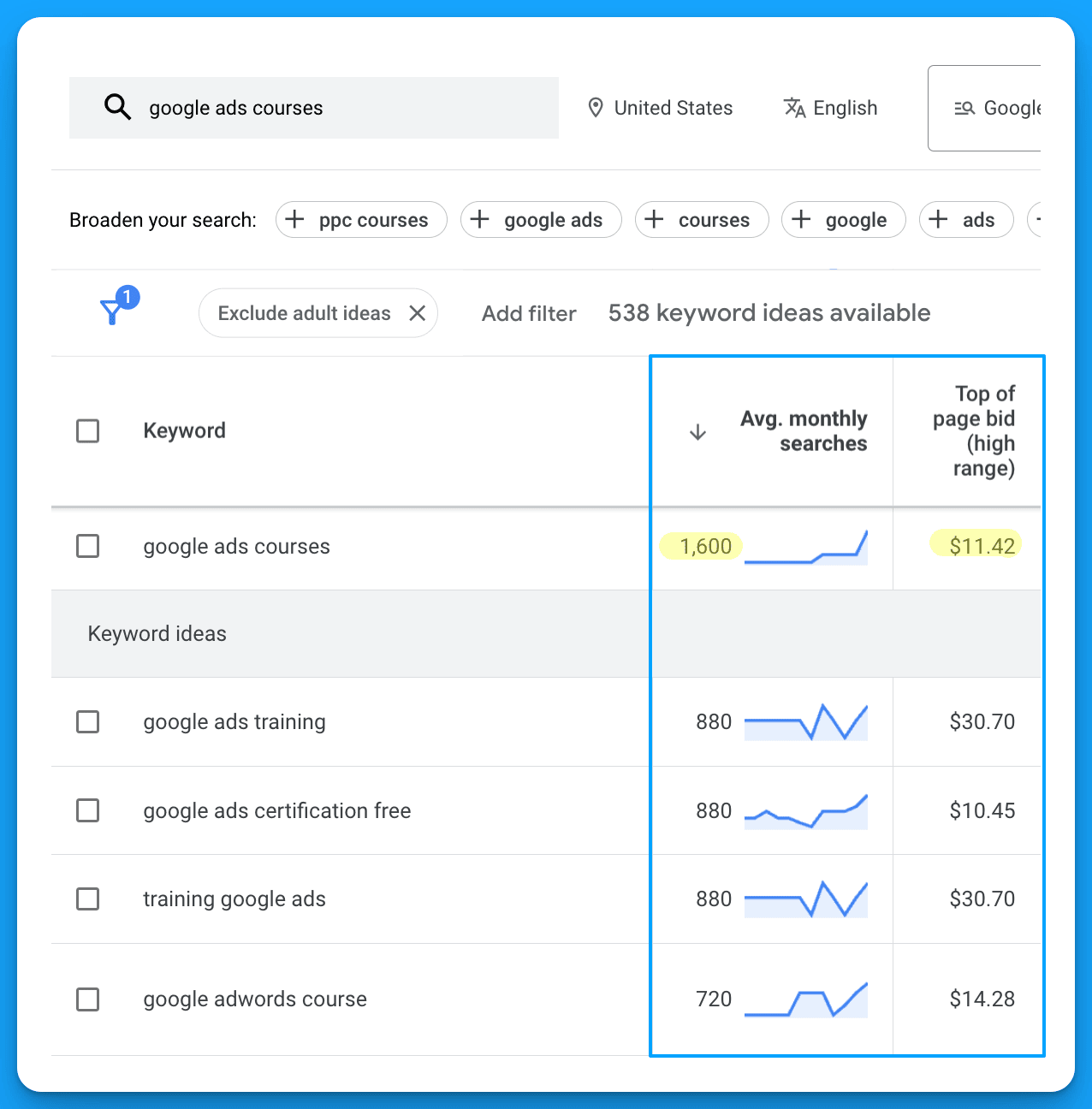
I recommend always using the top of page bid (high range) as your estimate.
I’ve never seen these estimates be 100% accurate and you’ll never know your real CPC until launch.
To account for this margin of error I recommend adding +20% on top of your top of page estimate.
This means in our google ads courses example:
- It would potentially cost me $13.7 per click ($11.42 +20%)
- I can receive up to 1,600 clicks per month in the USA.
Based on these two data points we can assume it’s possible to spend up to $21,920 per month on this keyword ($13.7 * 1,600).
Outside of the return on investment, don’t forget about return on effort.
If your dream keywords have very limited search volume (ex: < 100/month) it might not be worthwhile.
How to forecast a daily, monthly, and quarterly Google Ads budget
Once you know your estimated cost per click you’re ready to put together a forecast.
We’ve created a free Google Ads Budget Calculator tool that you can use to easily plan your daily, monthly, and quarterly budget.
You’re going to need the following information for the forecast:
- Your average cost per click (from the Keyword Planner or real data)
- Your quarterly sales goal
- Your average win rate
- Your average revenue per sale
With all this information at hand you’ll plug these different values into the calculator.
Based on your landing page conversion rates you can model a worst, moderate, and best case.
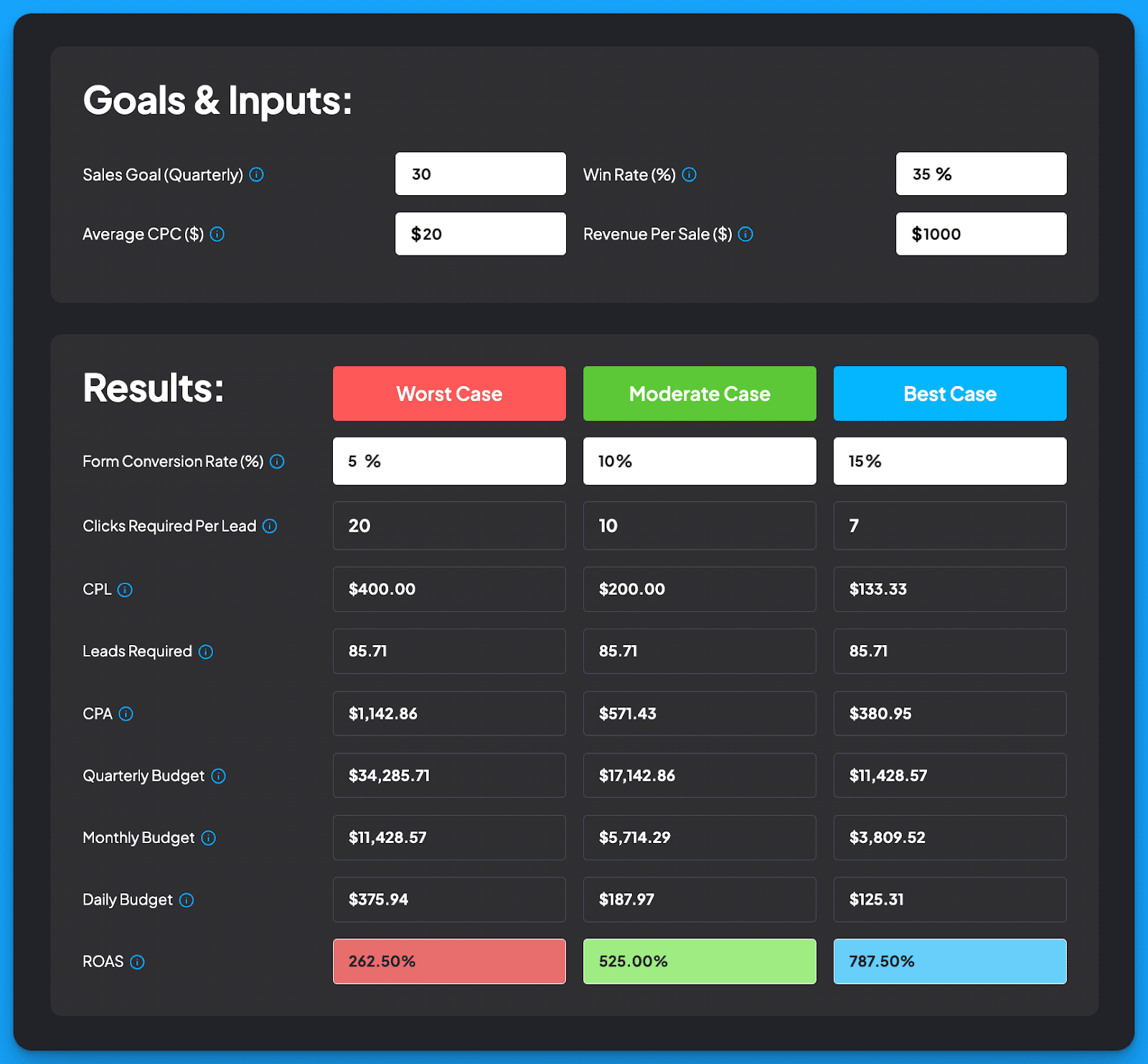
From here you can see how much it will cost to acquire a customer and the budget required to hit your sales volume target.
I highly recommend paying attention to the number of clicks required per lead, this will help frame expectations on how much traffic you’ll need and if your search volume is sufficient.
As you’ll see, your landing page effectiveness is essential at reducing costs 💥
With this forecast at hand you’ll know exactly how much to invest.
How to allocate Google Ads budget by campaign strategy
You should be clear on how much you’ll need to invest in your Google Ads campaigns.
Now the next step is to figure out how you’re going to allocate your budget.
In my experience managing Google Ads campaigns for B2B SaaS companies, there are five proven campaign themes to invest in; NonBrand, Brand, Competitive, RLSA, and Content.
Here’s my recommendation on budget allocation by each if you want to maximize volume.
Use all of these as starting points and modify the amounts based on your data/nuances.
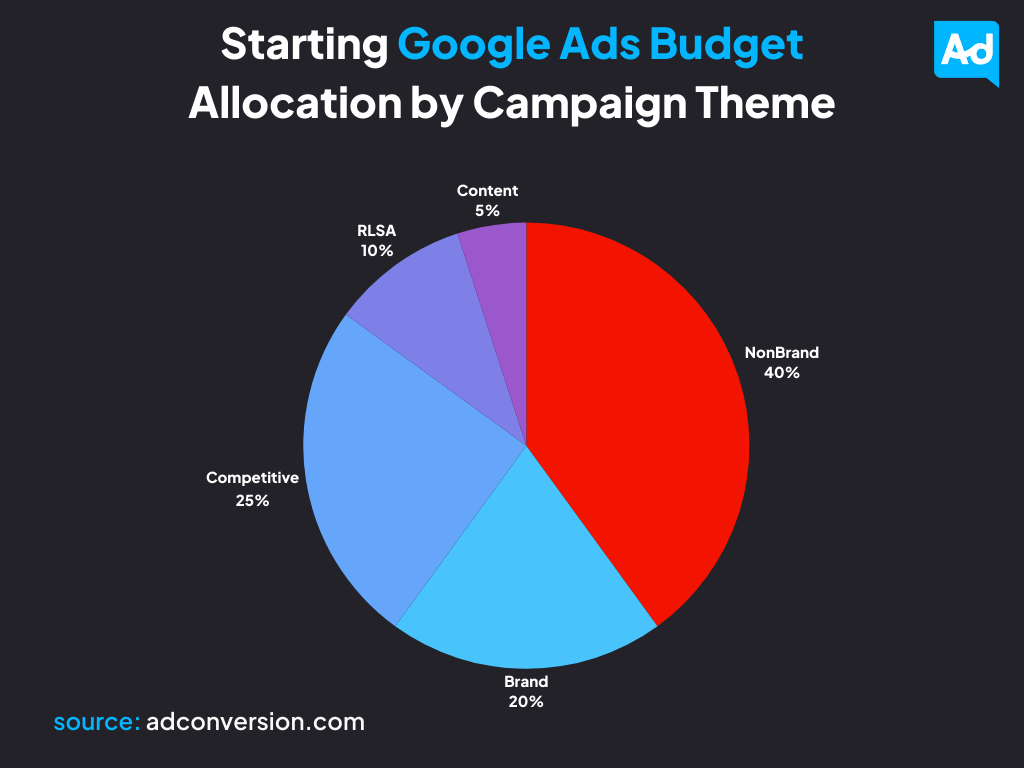
NonBrand = 40% of total budget
NonBrand campaigns are where you’re bidding on high-intent keywords that don’t include your brand, for example google ads courses would be non brand for us at AdConversion.
Think about your keywords you’d like to cover that problem aware prospects would search for.
NonBrand keywords typically contain high-intent modifiers such as:
- Software
- Platform
- Tool
- Technology
- Solution
If you have enough search volume on non brand keywords there’s no easier way to drive conversions than showing up for people looking for solutions to their problems.
Brand = 20% of total budget
Brand campaigns are commonly referred to as “defense” campaigns where you’re bidding on your own brand name to outrank competitors bidding on yours.
You can make the case that people searching your branded terms would convert anyways and it’s not worth the investment.
This is why I recommend no more than 20% of the total budget on this campaign initially.
I’ve seen exceptions here with some of our clients where they saw net new revenue decline significantly from pausing their branded campaigns.
Let your data guide your allocation.
Competitive = 25% of total budget
Competitive campaigns are the opposite of brand where you’re bidding on competitors' names to appear for their existing customers and prospects.
These campaigns can be really hit or miss depending on your execution.
Make sure you’re doing it in a classy way and have dedicated comparison pages.
This theme can be really powerful at driving qualified traffic as these searchers are solution aware.
RLSA = 10% of total budget
RLSA stands for remarketing list for search ads.
This just means search remarketing, anyone that searches your keywords AND is part of an audience.
For example, anyone that has been to your site in the past 90 days and is searching your keywords.
RLSA campaigns can be really powerful when you have enough site traffic and are dealing in competitive niches.
Depending on your available remarketing audience sizes you can decide if this makes sense initially.
Given the limitation of size we typically only allocate 10% here to begin.
Content = 5% of total budget
Content campaigns are great for supporting SEO efforts.
If you have certain keywords you’re struggling to rank for, content campaigns are worth investigating.
This is where you’re going to bid on longtail content related keywords that typically have much lower cost per click prices and drive that traffic to a blog or relevant content piece.
Depending on your content strategy I’d give this some consideration.
Hope you found this article helpful! and now know how to create a winning Google Ads budget strategy.
Frequently asked Google Ads budget questions
Does Google Ads work on a small budget?
Yes, and no. Small is relative to your average cost per click prices.
I’d recommend being able to afford at least 100 clicks per month.
Does Google Ads work for B2B SaaS?
Absolutely, intent is what makes Google Ads so powerful.
The biggest challenge for B2B SaaS is scale.
What is a good Google Ads budget?
A Google Ads budget is one where you can support your business objectives.
Using the following information you can create a forecast to understand what is good:
- Your average cost per click
- Your quarterly sales goal
- Your average win rate
- Your average revenue per sale
From Clicks to Conversions: Master Google Ads for B2B 🔥
If you want to become a Google Ads pro, check out our free B2B Google Ads courses, where you'll learn how to launch, optimize, and scale your campaigns to drive pipeline and revenue.

Here's what you'll learn in each course:
⚙️ B2B Google Ads 101 - How to Launch Dangerously Effective Campaigns for Beginners
- The Googleverse: The Game You're Playing & How To Win
- Measurement: How to Make Sure You're Profitable
- Targeting: How to Show Up For the Right Searcher
- Planning: Putting It All Together
🎯 Google Ads 102 - How to Clicks Into Profit
- Visibility: How To Find the Hole Sucking Profits
- Workflows: How to Optimize On a Daily, Weekly, Monthly & Quarterly Basis
- Experimentation: How to Test & Automate Profitability
- Troubleshooting: How To Solve Inevitable Problems
🚀 Google Ads 103 - How to Scale Google Ads For Advanced Advertisers
- Methodology: How to Vertically Scale Google Ads From A-Z
- Campaigns: Scaling Horizontally Through Campaign Themes
- Channels: Scaling Outside of Paid Search
Click Here to Join 1,000+ B2B Marketers Today and start leveling up your advertising skill set.
Takes < 90 seconds to sign up (seriously we timed it 😂)

14 Powerful LinkedIn Thought Leader Ad Strategies Worth Testing
Everyone knows that B2B buying has changed.
People trust people more than they trust companies, making thought leadership ads more important than ever before.
If you’re looking to use thought leader ads in your LinkedIn ad strategy but aren’t sure how to get started, this article is for you.
Here are 14 thought leader ad plays and examples you can test.
Let’s jump into it! 👇
TABLE OF CONTENTS:
- Play #1: Announce new product features, integrations, and partnerships
- Play #2: Highlight the main problem your product solves + the solution it provides
- Play #3: Highlight a case study featuring your own company
- Play #4: Highlight a case study featuring one of your customers
- Play #5: Generate buzz before attending an in-person event
- Play #6: Stay top of mind after an event
- Play #7: Promote your own event
- Play #8: Promote an upcoming webinar
- Play #9: Promote your newsletter
- Play #10: Celebrate Customer Wins
- Play #11: Demo different use cases of your product
- Play #12: Share long-form content with insights that your ICP would be interested in
- Play #13: Provide practical advice based on insights from your platform
- Play #14: Leverage social proof from existing customers
Play #1: Announce new product features, integrations, and partnerships
🔑 to success: Trust your audience. Target the experts and speak to them like they’re experts. Show them all the cool things they’ll be able to achieve with your product.
Example 1: Dreamdata

Example 2: Gong

Example 3: UserGems

Example 4: Dreamdata

Play #2: Highlight the main problem your product solves + the solution it provides
🔑 to success: After prospects read your content, they should be able to clearly articulate the problem your product solves + the solution it provides. If they can’t, you need to simplify your messaging.
Example 1: Apollo

Play #3: Highlight a case study featuring your own company
🔑 to success: Show how your team is using YOUR tool to reach YOUR goals – your company can serve as its own case study.
Example 1: UserGems

Example 2: Apollo

Example 3: Sendoso

Example 4: Salesloft

Play #4: Highlight a case study featuring one of your customers
🔑 to success: Clearly articulate how you’ve been helping an existing customer achieve their goals.
Example 1: Lavender

Example 2: Loxo

Play #5: Generate buzz before attending an in-person event
🔑 to success: Use an ABM list of attendees or ABM list of companies + key job functions to make sure you’re getting in front of the right people.
Example 1: HockeyStack

Play #6: Stay top of mind after an event
🔑 to success: Have an attendee post a recap after an event so that your brand is staying top of mind in the following weeks. The idea isn’t to push your product, but to keep raising awareness within key accounts.
Example 1: Sendoso

Play #7: Promote your own event
🔑 to success: Have your event speakers announce their participation on their personal pages and boost the posts to increase overall reach. This is a win for the speakers and for your company – speakers will feel supported and your event will get more registrations.
Example 1: Gleanin

Example 2: Gleanin

Play #8: Promote an upcoming webinar
🔑 to success: Clearly highlight the value of the webinar for your audience – what will they learn by attending? Make sure to tag the speakers to generate more interest.
Example 1: Sendoso

Example 2: Copy ai

Example 3: DoWhatWorks

Play #9: Promote your newsletter
🔑 to success: Keep it simple & highlight what people will get out of subscribing.
Example 1: Motion
.png)
Play #10: Celebrate customer wins
🔑 to success: Highlight customers when they win an award or achieve something big. This strategy provides social proof to help with prospecting efforts, but it’s also a great retention play, as it makes existing clients feel supported.
Example 1: Sendoso

Example 2: Lavender

Play #11: Demo different use cases of your product
🔑 to success: Have a senior leader – from your own company or one of your customers – educate prospects on how they can use your product to achieve their business goals.
Example 1: Dreamdata

Example 2: Clay

Example 3: Clay

Play #12: Share long-form content with insights that your ICP would be interested in
🔑 to success: Don’t tell everyone how great your product is – instead, show them the insights they could have access to if they used it. Also, make the content industry-specific. For example, content about conversion impact or email subject lines in B2B SaaS will be much more powerful than content about conversions or email in general.
Example 1: HockeyStack

Play #13: Provide practical advice based on insights from your platform
🔑 to success: Don’t provide generic advice that people have heard many times. Instead, give advice that your ICP may find surprising, and always back it up with data from your platform. This strategy is powerful because potential buyers will be grateful for the thought leader’s recommendations AND they’ll also relate the thought leader’s content to your organization (and hopefully be interested in learning more).
Example 1: Lavender

Play #14: Leverage social proof from existing customers
🔑 to success: Promote content from respected customers within your target industry highlighting the use cases and overall impact of your product.
Example 1: UserGems

Example 2: Clay

Putting LinkedIn Thought Leader ads into action
If you’re excited about thought leadership ads and want to start running them right away, here’s what I would recommend:
1. Find a few people at your organization that would be great thought leaders. They don’t need to be influencers with 50K followers – they simply need to have a deep understanding of your product and your ICP (bonus if they also enjoy writing).
2. Once you’ve selected your thought leaders, choose the top 3 strategies from this playbook that you’d like to begin with. I don’t recommend starting with all 14 strategies at once, since that could get pretty overwhelming.
3. Have your thought leaders post a few times per month and boost their content to your ICP.
That’s all you need to get started.
P.S.
If you’re starting out with thought leadership ads, I recommend using the engagement objective to build your retargeting audiences in a cost-effective way.
And if you want a complete masterclass on LinkedIn ads objectives, ad types, and bidding strategies, I highly recommend checking out this article by Ali Yildirim.
Master B2B LinkedIn Ads with these 3 Free Courses:
If you want to become a LinkedIn Ads pro, check out our free B2B LinkedIn Ads courses, where you'll learn how to launch, optimize, and scale your campaigns to drive pipeline and revenue.
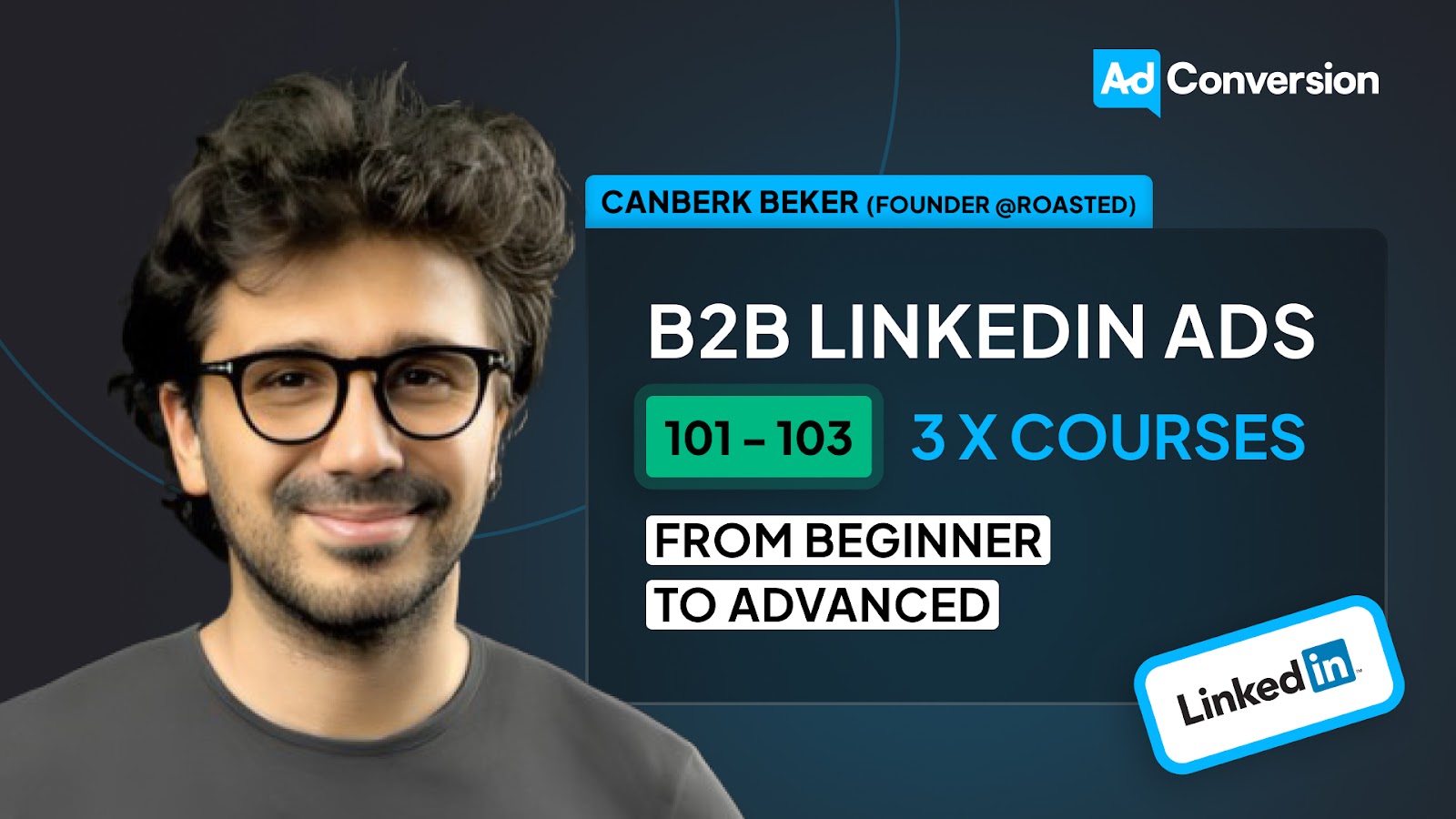
Here's what you'll learn in each course:
⚙️ B2B LinkedIn Ads 101 - The Ultimate Crash Course for New LinkedIn Advertisers
- Foundations For LinkedIn Ads Success
- Measurement: Tracking & Key Principles
- Targeting: Reaching Your Dream Buyers
- Ads: Mastering The 9 Ad Formats
🎯 B2B LinkedIn Ads 102 - The Blueprint for LinkedIn Ads Optimization
- Monitoring: How To Spot Performance Trends
- Auditing: How To Find The Darlings You Need To Kill
- Reporting: How To Transform Data Into Insights
- Optimization: How To Make Your LinkedIn Ads Profitable
🚀 B2B LinkedIn Ads 103 - Advanced Scaling Strategies From $25M In Ad Spend
- Concepts of Scaling
- Divide and Conquer
- Learnings From $25M+ In LinkedIn Ad Spend
Click Here to Join 1,000+ B2B Marketers Today and start leveling up your advertising skill set.
Takes < 90 seconds to sign up (seriously we timed it 😂)
People Also Ask
What are LinkedIn Thought Leader Ads, and how do they differ from standard LinkedIn ads?
LinkedIn Thought Leader Ads allow companies to sponsor posts from individual profiles, such as company leaders or industry experts, rather than from the company page. This approach leverages personal connections and trust, often leading to higher engagement compared to standard company-sponsored ads. 
How can I select the right individuals for Thought Leader Ads within my organization?
Choose individuals who have a deep understanding of your product and ideal customer profile (ICP), and who are comfortable creating engaging content. They don’t need to be influencers with large followings; authenticity and expertise are key. 
What types of content work best for LinkedIn Thought Leader Ads?
Effective content includes announcing new product features, sharing case studies, promoting events or webinars, and providing practical advice based on insights from your platform. The goal is to offer valuable information that resonates with your target audience. 
How can I measure the success of my LinkedIn Thought Leader Ads?
Monitor metrics such as impressions, engagement rates, click-through rates (CTR), and conversions. Additionally, assess qualitative feedback like comments and shares to gauge how the content resonates with your audience. 
What are some best practices for creating effective LinkedIn Thought Leader Ads?
Ensure the content is authentic and aligns with the thought leader’s voice. Optimize the individual’s LinkedIn profile as it serves as a landing page for interested viewers. Use high-quality visuals, clear messaging, and include a call-to-action to guide the audience’s next steps.

10 Effective Account-Based Marketing Tactics For Modern B2B Marketers
Do you need to find out if ABM is the right approach for you & how you can get the most out of your efforts?
I had the pleasure of interviewing Brandon Alisoglu who’s achieved a 300% increase in demo bookings for B2B companies while maintaining a 50% SQL rate from ABM campaigns.
Here’s Brandon’s top 10 tips & tactics to maximize return on effort (ROE) for your ABM ads.
(In no particular order, they all matter)
TABLE OF CONTENTS
- Tip #1 - Assessing the Suitability of ABM for Your Business
- Tip #2 - Embracing the Long Game in Account-Based Marketing (ABM)
- Tip #3 - Create a Dossier of Information
- Tip #4 - Breaking Content to Audience Segmentation
- Tip #5 - Focusing on Outcomes: The "So What?" Factor in ABM
- Tip #6 - Drilling Into Personas & Messaging
- Tip #7 - A/B Testing Value Propositions
- Tip #8 - Set Aside Time to Ideate
- Tip #9 - Streamlining the Process with Templates
- Tip #10 - Don’t Skip Google
- Conclusion
- Resources for mastering B2B advertising
Tip #1 - Assessing the Suitability of ABM for Your Business
When evaluating ABM for your business, consider the nature of your target accounts and the practicality of a personalized marketing approach.
ABM is particularly effective for targeting large organizations or "whales" where the potential return justifies the extensive effort and resources required for highly tailored campaigns.
Challenges with ABM in Smaller Companies
In smaller companies, the lack of numerous distinct roles and seniority levels may limit the effectiveness of ABM strategies that rely on granular targeting and personalized messaging.
If a company is too small to segment effectively based on these criteria, the impact of a tailored ABM approach may be diminished.
ABM often involves high-ticket offerings and significant investment in marketing resources.
If the target account does not have the financial capacity or the organizational complexity, the return on investment might not be worth it.
Strategic Considerations for ABM
Evaluate potential accounts not just by their immediate size but by their strategic importance and the potential lifetime value they offer.
Consider more generalized targeted advertising strategies for smaller accounts that do not justify a full ABM approach.
These can still be effective by focusing on industry-specific pain points and solutions but do not require the level of customization and operational complexity associated with traditional ABM.
Identifying the Annual Contract Value (ACV) Benchmark
An ACV of around $20,000 is generally seen as a threshold where ABM becomes viable.
This benchmark suggests that the deal size is significant enough to warrant the detailed and personalized marketing efforts required in ABM.
Another practical measure is whether the contract value requires CFO approval.
The involvement of a CFO generally indicates that the deal is substantial enough to require careful consideration and alignment with strategic financial goals.
Tip #2 - Embracing the Long Game in Account-Based Marketing (ABM)
Unlike traditional demand generation tactics that may prioritize immediate results, ABM focuses on building engagement through a more deliberate and personalized approach.
The idea here is to build a meaningful relationship with key accounts.
In the same way, you wouldn't ask for a hand in marriage on the first date, successful B2B marketers shouldn’t ask prospects to talk to sales unless they've had some interaction before.

The Importance of Educating and Engaging
The early stages of ABM should center around education and awareness.
Allow targeted accounts to familiarize themselves with your brand and value propositions.
This foundational phase is important for setting the stage for deeper engagement.
Jumping directly to aggressive sales tactics like pushing for demos with accounts that have minimal interaction with your brand, is less likely to yield positive results.
Instead, nurturing relationships over time fosters trust and increases the likelihood of conversion when the account is ready.
Balancing Immediate Needs with Long-Term Strategy
While the emphasis on the long game is important, we realize the need to meet short-term sales targets is a pressing reality for most B2B marketers.
In such cases, employing a robust account scoring system can help identify which accounts are most ready to engage based on their behaviors such as:
- Website visits (specially high-intent pages)
- Ad engagement
- Email interactions
- Webinar attendees
For accounts that show clear signs of being in-market or closer to the decision stage, tailor your approach to convert these opportunities.
This can involve more direct calls to action, such as personalized demo invitations and running incentivized offers.
If your company is product-led, this would be a good time to offer free trials.
Sample of free trial ad by Plauti:

Tip #3 - Create a Dossier of Information
Understanding your prospects' interests, pain points, and engagement history comprehensively is the key to crafting personalized and effective ABM strategies.
This information equips sales teams with the required data to personalize their outreach effectively and accelerate the sales process.
Building & Targeting Prospect
Compile data on prospect activities, including the specific ads they clicked, pages they visited, or any communications they have sent.
This dossier should act as a dynamic document that sales teams can use to personalize their approaches.
By understanding what content the prospect has engaged with, the sales team can address specific interests or pain points, making their pitches more relevant and compelling.
Marketers can also use this data to launch 1:1 campaigns featuring social proof and objection handling.
If the list of accounts is not large enough for a 1:1 approach, then gather the top 3-5 most common objections that resonate with the majority of the accounts.
You can reduce the overall cost by dynamically excluding any account that has contacted sales.
Implementation Tips for Effective ABM
- Identify in-market accounts by using advanced analytics and account scoring to determine which of your target accounts are actively engaging with your content.
Tools like HubSpot or Marketo can help streamline the process.
- Once these engaged accounts are listed, segment them for targeted campaigns that address their specific stages in the buyer’s journey.
This segmentation allows you to apply more aggressive sales tactics appropriately while continuing to nurture less-ready accounts with educational content.
- Distribute content that educates and engages at various stages of the customer journey.
This tactical approach ensures that when you invite accounts to a demo or free trial they are informed and more likely to be receptive.
Successful ABM is a blend of patience and strategic agility, tailored to meet both the immediate and long-term goals of your business.
Tip #4 - Breaking Content to Audience Segmentation
The purpose of this step is to develop and deliver content that addresses specific pain points and interests identified in your prospect dossiers.
Strategies for Deepening Prospect Engagement
As you gather more data on your prospects' behaviors, such as the ads they click or the pages they visit, use this information to guide them through a personalized buyer's journey.
This involves crafting content that speaks directly to their needs and leading them to web pages that provide further value and deepen their engagement with your brand.
Regularly update and refine your ads to keep them in line with your audience's changing interests and needs.
Creating a Content "Buffet"
Offer a Variety of Content Options.
Imagine setting up a buffet of content options tailored to different tastes and preferences within your target accounts.
By providing a range of topics and formats—from whitepapers and case studies to webinars and interactive tools—you allow prospects to self-select the content that most resonates with them.
Use the insights from observed interactions to refine your understanding of what each prospect cares about.
This personalized approach not only enhances the relevance of your outreach but also increases the likelihood of a prospect's deeper engagement with your content.

Integrating Technology for Efficiency
While managing this level of personalized engagement can become complex, employing an ABM platform can streamline the process.
These platforms can help organize and automate content delivery based on user behavior, keeping track of interactions across different channels to maintain a cohesive and personalized marketing approach.
Pro tip:
Before fully investing in an expensive ABM tech stack, validate your strategy with simpler tools or minimal setups to prove its effectiveness.
A simple way is to use LinkedIn's demographic reporting to see which companies have been exposed to impressions, and which ones are actually engaging.
You can take it a step further and leverage a third-party data connector like data slayer to pull the demographic data from LinkedIn through API.
Tip #5 - Focusing on Outcomes: The "So What?" Factor in ABM
A critical aspect of effective ABM is ensuring that every piece of data, every content interaction, and every campaign has a clear and compelling answer to the question: "So what?"
Every action should educate, nurture, or capture leads, to bring you closer to revenue.

The Importance of Outcome-Based Messaging
In ABM, it's not enough to highlight the features of your product or the hours it can save a potential client’s team.
The key is to articulate what these benefits mean in the context of the customer’s specific business challenges and goals.
When discussing a product feature, such as "saves your engineering team 20 hours a week," it's essential to connect this benefit to tangible business outcomes.
For example, what does saving 20 hours a week mean for the company?
Could it lead to faster project completions, cost savings, or better resource allocation?
These outcomes are what will truly capture the interest of decision-makers.
By consistently focusing on the "so what?" of your actions and messaging, you can lift your ABM efforts from functional to transformational.
Pro-tip:
Establish Leading Indicators to Measure ABM Progress:
By establishing clear leading indicators across your marketing funnel, you can quantify progress and tie every action back to tangible business outcomes.
From initial awareness through engagement to conversion, each stage can be monitored and analyzed to ensure marketing efforts move potential clients closer to a sale.
These indicators provide a roadmap that justifies the investment by showing how specific activities contribute to moving accounts through the sales pipeline.
If you want to learn more about creating leading and lagging indicators along with actionable free templates check out the AdConversion Paid Media Program course; Module 2, lesson 1.

Tip #6 - Drilling Into Personas & Messaging
Within any given company, different levels of management and seniority have distinct priorities and challenges.
For example, C-suite executives might focus on strategic growth and scalability, directors on operational efficiency, and managers on tactical execution.
Tailoring your messaging to address these specific concerns can dramatically increase the relevance and impact of your communications.
Beyond role-based customization, consider the particular needs and pain points of the industry or vertical your target accounts might operate within.
Strategies for Effective A/B Testing
Implement continuous A/B testing across your campaigns to determine which messages resonate best with each persona.
Segment your target audience by role and seniority, and tailor your messages accordingly.
For example, test different value propositions with managers versus C-suite executives to determine which messages drive more engagement or conversions from each group.
Understand that the preferences and behaviors of your audience can evolve, and your ABM strategy should be agile enough to adapt to these changes.
Tip #7 - A/B Testing Value Propositions
By testing two to three variations of each message, you can discover appeals and incentives that resonate with distinct groups within the same role and seniority level.
In cases where the target company might not be large enough to segment by job titles or seniority due to LinkedIn’s filtering limitations, marketers need to think creatively about how to approach personalization and segmentation.
Alternative Segmentation Strategies:
- Use Broad Segments:
Instead of job titles, consider using job function and seniority or even adding member skills into the mix.
- Focus on Common Pain Points:
Leverage the common challenges or objectives identified in smaller organizations.
For example, if most employees are likely involved in decision-making due to the company's size, tailor messages that address broad business benefits that resonate across multiple roles.
As discussed earlier, knowing the top objections by vertical can guide the creation of content and ads that preemptively address concerns.
This is particularly useful when precise job title segmentation is not feasible.
Tip #8 - Set Aside Time to Ideate
In the fast-paced environment of account-based marketing, it's imperative to carve out dedicated time for creative thinking and experimentation.
By blocking out time on your calendar, preferably during quieter hours like Friday afternoons, you ensure that you have the space to think deeply and creatively about your ABM strategies.
Regular ideation sessions allow you to review current insights and performance data, enabling you to develop new approaches and refine existing ones.

Pro tip:
Leverage Experimentation and Documentation:
Incorporate a structured approach to experimentation.
Try out new ideas on a small scale to assess their effectiveness before rolling them out broadly.
Keep detailed records of your experiments, including:
- Hypotheses
- Execution details
- Outcomes.
This documentation enables you to capitalize on effective strategies and avoid past mistakes.
Tip #9 - Streamlining the Process with Templates
Keeping detailed and organized documentation of ABM activities, such as experiments, outcomes, and insights will save you lots of time & effort in the long run.
It can be as simple as using Google Docs with structured headings and a table of contents.
Consistent documentation helps in creating a reliable record that can be referenced in reports and strategy meetings.
Leveraging Design Templates
Design templates allow marketers to quickly generate new versions of ads or content without starting from scratch each time.
By standardizing the design elements, teams can focus on tweaking the messaging and content to better align with the target audience’s evolving preferences.
Using templates also ensures that all materials produced are aligned with the brand’s visual identity and messaging guidelines.
Effective Use of Templates and Documentation
Develop a range of design templates for different types of content and ads.
This library should include templates for social media posts, email campaigns, and other marketing materials that are frequently used in ABM campaigns.
Regularly update the documents with the latest results from A/B tests, data analysis insights, and feedback from sales and marketing teams to maintain accuracy and relevance.
Confirm that all team members are trained on how to use the chosen documentation and templates effectively.
With the design templates in place, focus on iterating on the creatives frequently.
Especially in smaller audience segments where ad fatigue can set in quickly.
Tip #10 - Don’t Skip Google
While (ABM) often focuses on direct and personalized communication channels like LinkedIn, incorporating Google Ads into your Demand Gen strategy can heavily reduce the overall cost per acquisition (CPA).
The Strategic Use of Google Ads
Google Ads allows you to address specific queries and pain points that your prospects are actively searching for.
By focusing on these queries, you can position your company as a solution provider right at the moment of need, effectively answering potential customers’ questions through targeted ads.
Often, niche or less competitive keywords related to specific industry questions or problems can be much cheaper than more general, high-intent keywords.
For example, targeting a specific industry debate or a lesser-known feature comparison can capture relevant traffic at a significantly lower cost.
This, not only increases brand awareness but also positions your company as an authoritative and helpful resource.
Creating content that addresses these queries and promoting it through Google Ads can drive highly targeted traffic to your website, increasing the chances of conversion.
Practical Tips for Implementing Google Ads
- Work with your sales and customer service teams to pinpoint the questions and topics that commonly arise during the sales process.
- Use these insights to guide your keyword and content strategy for Google Ads.
Develop content that answers these questions comprehensively.
This could be in the form of blog posts, FAQs, or educational articles.
- Use the identified keywords to set up Google Ads campaigns.
Start with a lower budget to test the effectiveness of your keywords and ads.
Monitor the performance and adjust your strategy based on the results.

Conclusion:
In this article, we discussed the significance of Account-Based Marketing (ABM) strategies through 10 practical tips and tactics to get the most out of your marketing efforts.
We explored the value of a long-term engagement strategy, emphasizing the need to build relationships through educational content and gradual interactions, rather than taking a direct approach.
Effective ABM involves understanding target accounts' specific needs and behaviors, employing analytics for better targeting, and continuously iterating on creative content to maintain relevance and combat ad fatigue.
Bookmark this blog as your comprehensive guide for your next ABM efforts to make sure your strategies align with the overall company goal.
If you’d like to reach out or get more weekly tips, please connect with Brandon via Linkedin.
Resources for mastering B2B advertising
If you’re serious about mastering B2B advertising then you definitely need to join 1,000+ B2B marketers leveling up their paid advertising skill sets in AdConversion.
Here’s 4 reasons why you should consider joining. Every one of our on-demand courses are:
✅ 100% free access.
✅ Taught by vetted industry experts.
✅ Have workbooks, resources, and templates.
✅ Less than 10 minutes per lesson.
We believe every marketer should know how to scale paid ads so they can:
- Scale their ideas
- Level up their careers
- Make a positive impact
Click Here to Join 1,000+ B2B Marketers Today and start leveling up your advertising skill set.
Takes < 90 seconds to sign up (seriously we timed it 😂)
People Also Ask
How can I effectively measure the success of my ABM campaigns?
Utilize key performance indicators (KPIs) such as engagement levels with target accounts, conversion rates, deal velocity, and revenue growth from those accounts. Implementing a robust analytics framework will help in tracking these metrics accurately.
What are the common challenges in aligning sales and marketing teams for ABM, and how can they be overcome?
Challenges include differing objectives, communication barriers, and data silos. Overcome these by establishing shared goals, fostering regular interdepartmental meetings, and utilizing integrated CRM systems to ensure both teams have access to the same account information.
How can I personalize content effectively for different stakeholders within a target account?
Develop detailed personas for each stakeholder role, understanding their specific pain points and objectives. Tailor your messaging to address these unique concerns, ensuring relevance and resonance with each individual.
What role does technology play in scaling ABM efforts, and which tools are essential?
Technology facilitates the automation and scaling of ABM strategies. Essential tools include CRM systems for managing account information, marketing automation platforms for campaign execution, and analytics tools for measuring performance.
How can I ensure data quality and accuracy in my ABM initiatives?
Regularly update and cleanse your data to maintain its accuracy. Implement data governance policies and utilize data enrichment services to fill in any gaps, ensuring your ABM efforts are based on reliable information.
.png)
Intro to B2B Google Ads: Crash Course For New Advertisers
Want to master Google Ads for B2B?
We’ll dissect Google Ads from a 10,000 foot view in this guide.
So you can walk away knowing:
- What is Google Ads?
- Is your ideal B2B buyer searching on Google?
- How can you get your ad seen on the top of Google?
- How much does Google Ads cost?
So whether you’re a SaaS founder, performance marketer, or in-house marketer looking to:
- Scale demo and trial requests for your new B2B SaaS startup
- Run Google ads for clients or launch campaigns internally
- Work with freelancers or agencies running your Google Ads
It all starts here with the fundamentals, so let’s dive in! 👇
TABLE OF CONTENTS
- What is Google Ads?
- Is Your Ideal B2B Buyer Searching on Google?
- How Much Does Google Ads Cost?
- How to Forecast Your Google Ads Budget
- Why is Google Ads So Powerful?
- How Can You Get Your Ad Seen on the Top of Google?
What is Google Ads?
Google Ads is an auction place.
Or as I like to think about it, a battleground.
Where you have thousands of advertisers competing against each other to show up on the top of Google when their ideal prospect searches for their products & services.
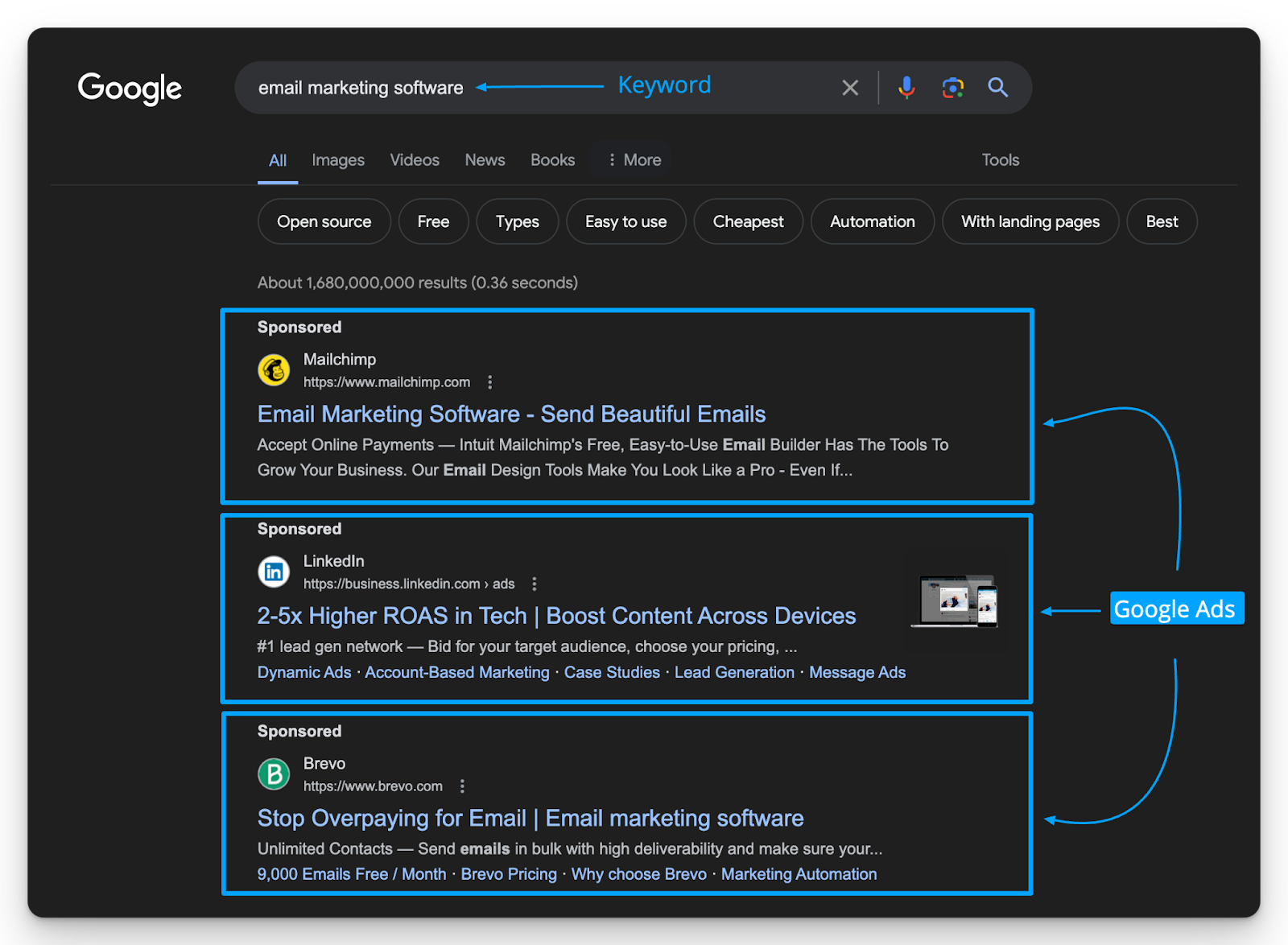
With 8.5B + searchers happening per day on Google there is a very HIGH likelihood your ideal B2B buyer is using Google to find information, and research solutions.
Is Your Ideal B2B Buyer Searching on Google?
Depending on the niche you’re in Google may or may not make sense.
You can create a free Google Ads account and leverage the Keyword Planner to validate demand.
All you need to do is research the ideal keyword your dream buyer would search and review the average monthly search volume and top of page bid estimates.
In the example below, I can see that for “email marketing software” there is:
- 1,000 - 10,000 average monthly searches
- $49.75 top of page bid estimate
If your ideal keyword has > 100 searches per month, Google can be a worthwhile return on effort.
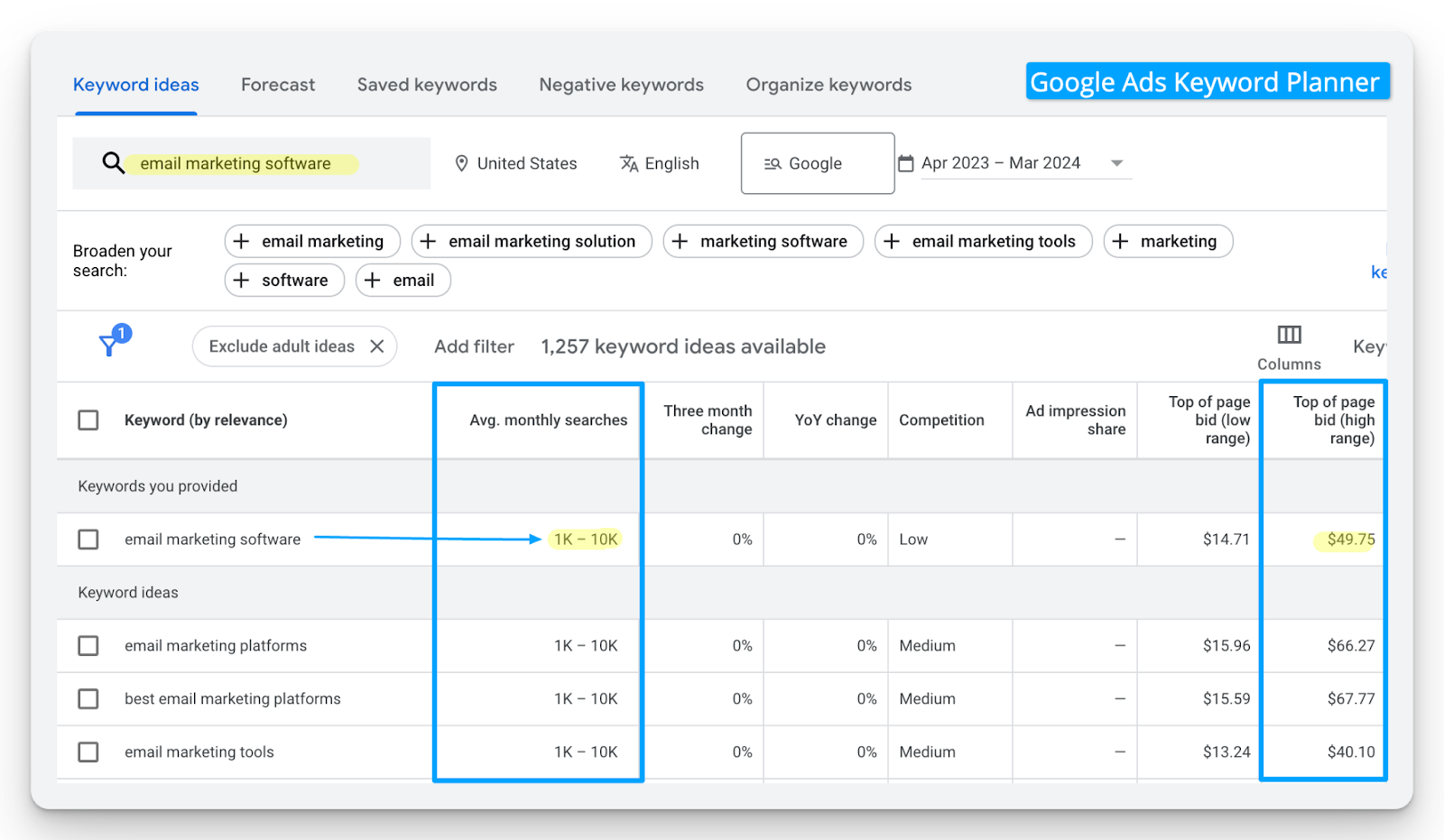
How Much Does Google Ads Cost?
Before diving into how much does Google Ads cost?
With Google Ads you’re only charged on a cost-per-click (CPC) basis.
Meaning you only pay Google if someone clicks your ad, so unlike traditional advertising you’re not being locked into a fixed contract and paying just for eyeballs (aka impressions).
So in short if someone sees your Google Ad and doesn’t click, you won’t pay.
This is what makes Google Ads so attractive, but extremely competitive.
Here’s two ways to find out how much Google Ads will cost for your ideal keywords:
1/ Review Top of Page Bid Estimates in the Google Ads Keyword Planner
As shown in the previous step you can leverage the Keyword Planner to find bid estimates.
In my experience these estimates are never 100% accurate and recommend adding 20% on top of the top of page bid estimate to be safe.
For example, with the keyword of email marketing software we have a $49.75 top of page bid estimate, adding 20% makes it $59.70 allowing us a margin of error to better set expectations.
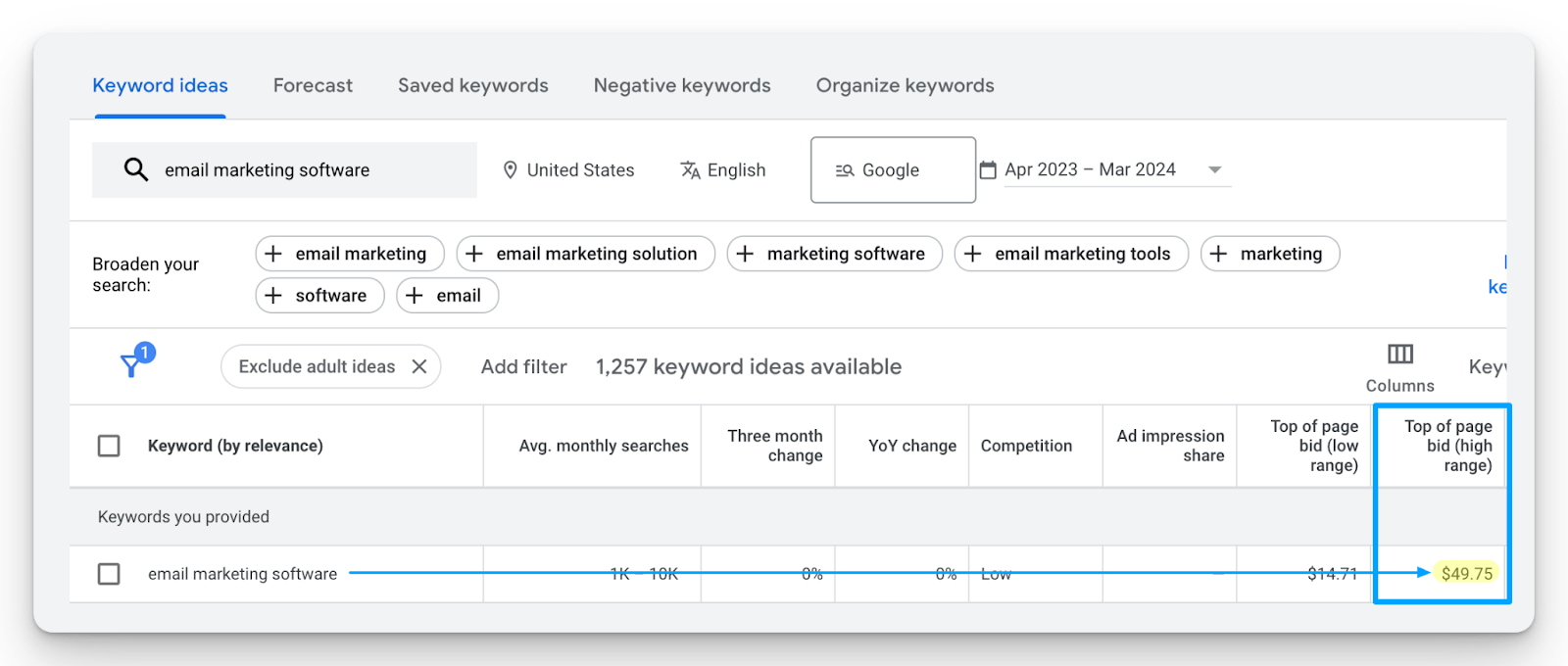
2/ Launch a Pilot Campaign for $100
Ultimately you’ll never know your real cost per click prices until launching.
If you’re seriously considering Google Ads I recommend launching a pilot campaign for $100.
The whole objective of this campaign is to understand; what is my REAL cost per click price?
Here’s a simple cheat sheet for setting up this campaign:
- Campaign Name = {Region}_{KeywordTheme}_{MatchType}
- Locations = {Your Target Country/Region/State}
- Match Type = Exact
- Bidding = Manual CPC
This setup will allow you to have the greatest control to discover your real CPC prices.
How to Forecast Your Google Ads Budget
Once you know the following:
- Your quarterly sales goal
- Average cost per click
- Opportunity win rate
- Revenue per sale
You can easily forecast a daily, monthly, and quarterly budget using our Google Ads Budget Calculator based on worst, moderate, and best case scenarios.
Give it a look, there’s a video tutorial on the page for you explaining the process.

Why is Google Ads So Powerful?
Intention Is what makes search advertising so powerful 🤝
You can reach exactly the right person, in the right place, in the right location searching for your specific product or service. At that point all you have to do is show up and not mess things up.
I always say Google Ads is a blessing and a curse; they bless you with intent, and curse you with scale.
Given your industry search volume will vary dramatically and it can become hard to scale.
The key is to win Google’s Ad Rank game to offset competitors and rising click prices.
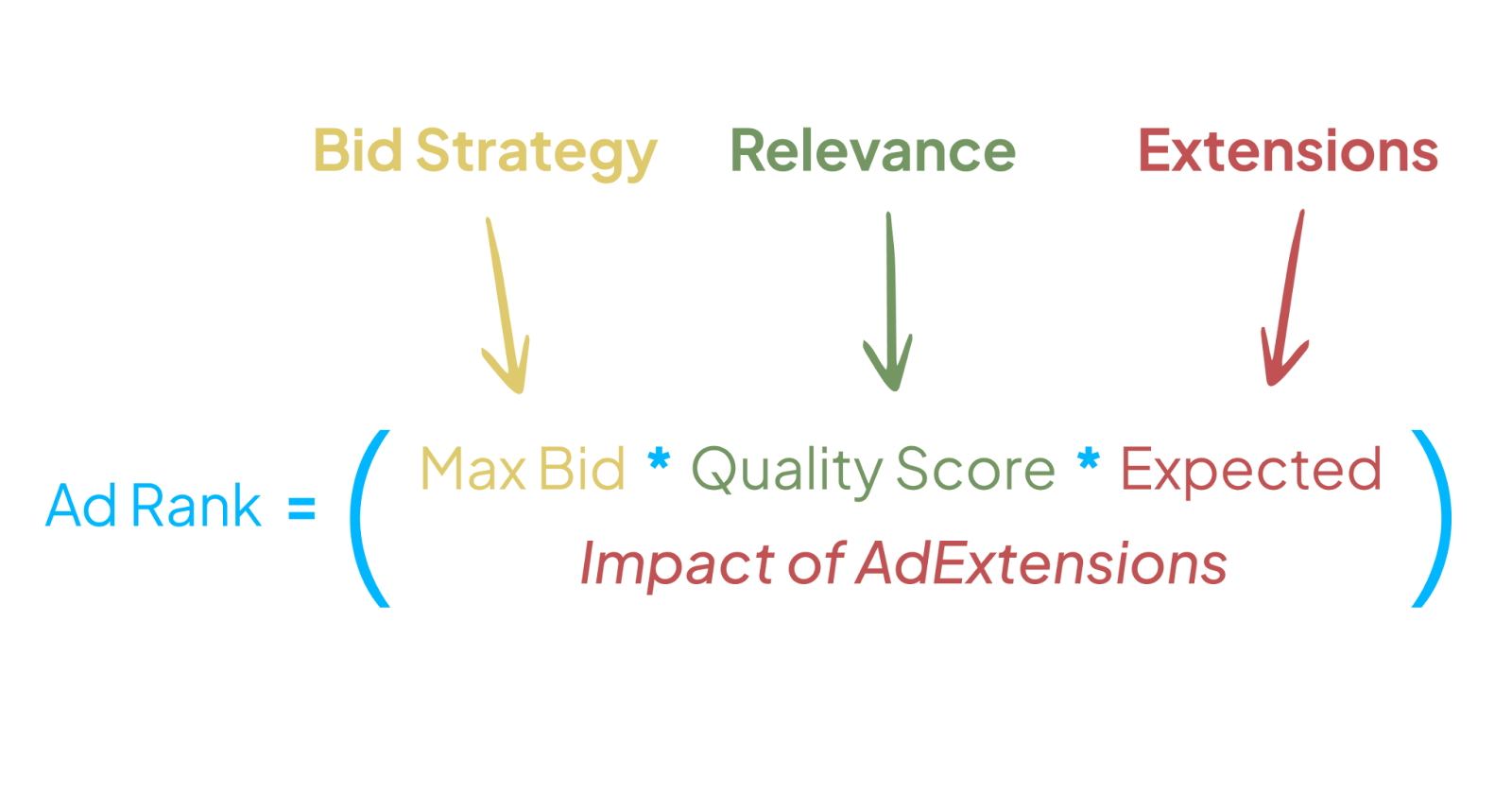
How Can You Get Your Ad Seen on the Top of Google?
Every time you search for something on Google (or other search engines such as Yahoo, Bing, and Firefox) the results page you’re directed to afterwards is the Search Engine Results Page (SERP).
I like to think of the SERP as the Battleground in which Google Ads takes place.
The SERP is Divided Between Paid and Organic Results.
The Google SERP usually has about 3-4 paid ads at the top and 3 at the bottom.

Ad Rank Determines the Position of Your Ad on the First Page
Which determines if your ad is on top of the first page of or nowhere to be seen.
Your goal is to appear in the top 3 spots as click-through rates decline with lower positions.
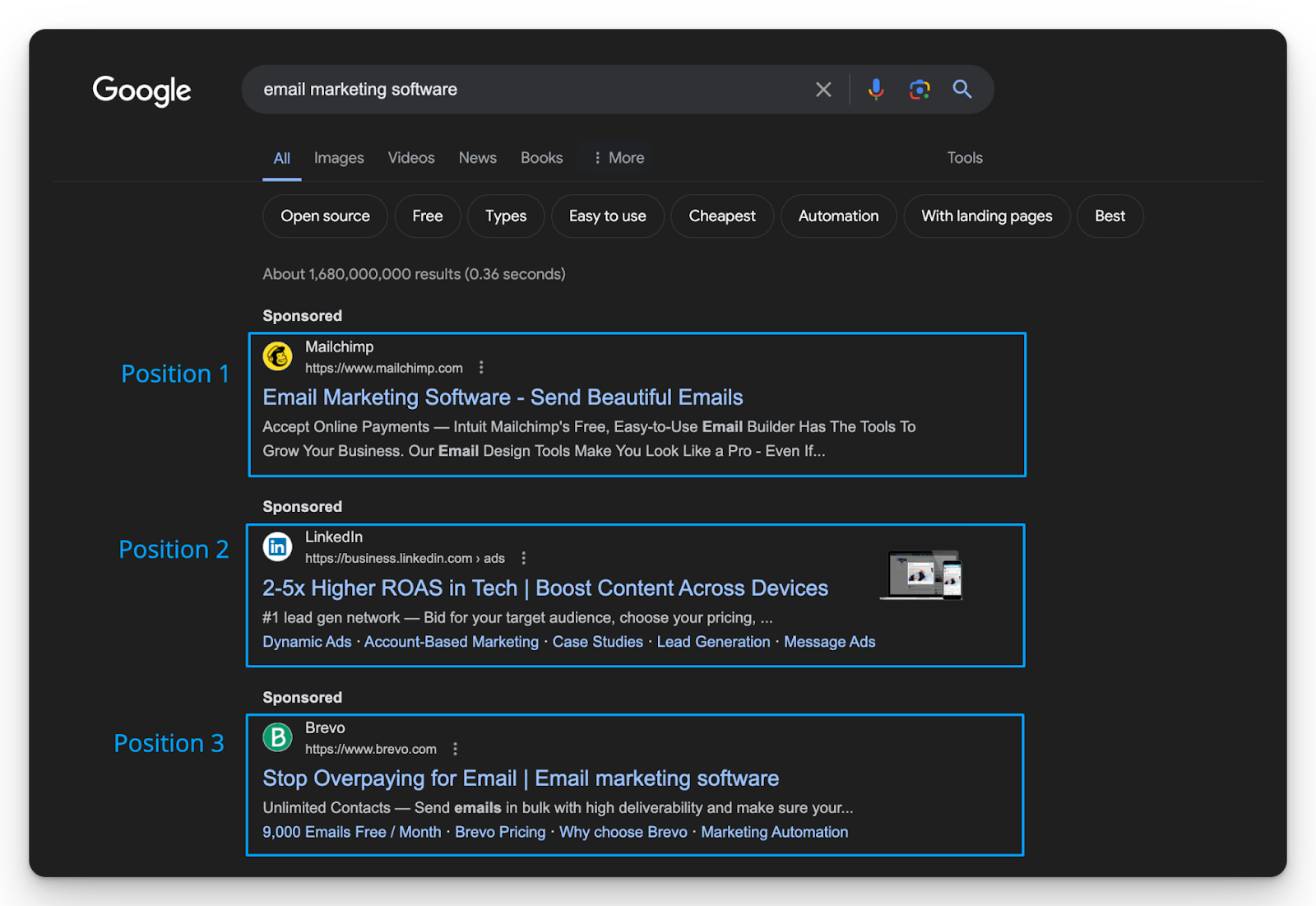
Higher Position Doesn't Always Mean Greater Cost
The remarkable thing about Google Ads is that you can be #1 on the page and pay less than your competitors who are in positions lower than you (hypothetical example below).
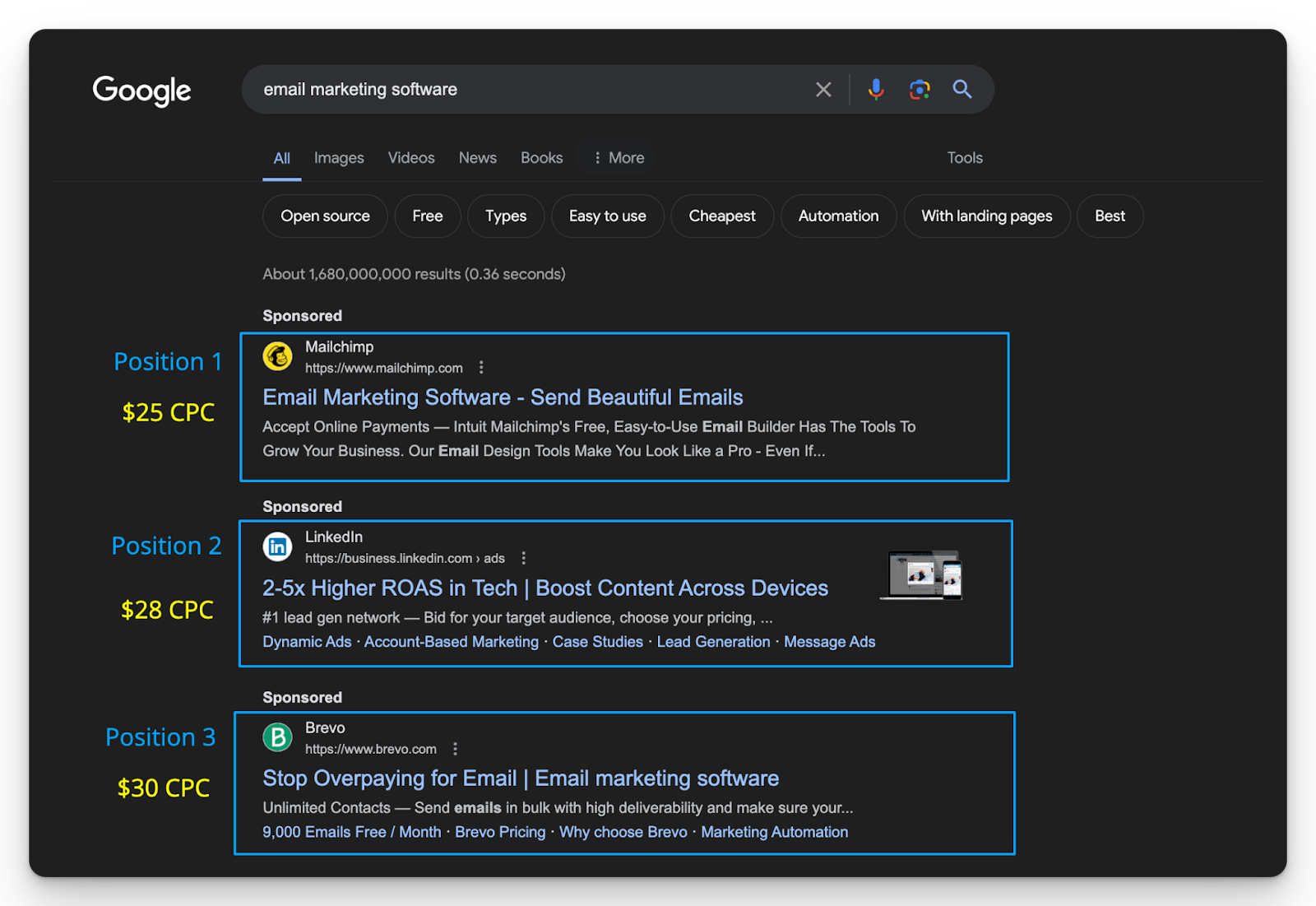
If after reading this article you believe Google Ads is worth further exploration.
Build on this fundamental understanding of Google Ads for B2B.
Hope you found this useful!
From Clicks to Conversions: Master Google Ads for B2B 🔥
If you want to become a Google Ads pro, check out our free B2B Google Ads courses, where you'll learn how to launch, optimize, and scale your campaigns to drive pipeline and revenue.

Here's what you'll learn in each course:
⚙️ B2B Google Ads 101 - How to Launch Dangerously Effective Campaigns for Beginners
- The Googleverse: The Game You're Playing & How To Win
- Measurement: How to Make Sure You're Profitable
- Targeting: How to Show Up For the Right Searcher
- Planning: Putting It All Together
🎯 Google Ads 102 - How to Clicks Into Profit
- Visibility: How To Find the Hole Sucking Profits
- Workflows: How to Optimize On a Daily, Weekly, Monthly & Quarterly Basis
- Experimentation: How to Test & Automate Profitability
- Troubleshooting: How To Solve Inevitable Problems
🚀 Google Ads 103 - How to Scale Google Ads For Advanced Advertisers
- Methodology: How to Vertically Scale Google Ads From A-Z
- Campaigns: Scaling Horizontally Through Campaign Themes
- Channels: Scaling Outside of Paid Search
Click Here to Join 1,000+ B2B Marketers Today and start leveling up your advertising skill set.
Takes < 90 seconds to sign up (seriously we timed it 😂)
People Also Ask
How can I effectively integrate Google Ads into my existing B2B marketing strategy?
Align your Google Ads campaigns with your overall marketing objectives by ensuring consistent messaging across all channels. Coordinate with sales and marketing teams to create cohesive campaigns that guide prospects through the sales funnel.
What are the best practices for managing budgets in B2B Google Ads campaigns?
Regularly monitor and adjust your budget allocation based on campaign performance. Prioritize spending on high-performing keywords and ads, and consider implementing bid strategies that align with your goals, such as target CPA or ROAS.
How can I leverage Google’s audience targeting features for B2B advertising?
Utilize features like custom intent audiences to reach users actively searching for products or services similar to yours. Combine this with demographic targeting to focus on decision-makers within your target industries.
What role does ad scheduling play in optimizing B2B Google Ads campaigns?
Implement ad scheduling (dayparting) to display your ads during times when your target audience is most active. This ensures efficient budget use and increases the likelihood of engagement during peak business hours.
How can I ensure compliance with Google’s advertising policies in B2B campaigns?
Regularly review Google’s advertising policies to ensure your ads meet all guidelines. This includes adhering to content standards, avoiding prohibited practices, and ensuring transparency in your ad copy and landing pages.



%20-%20new%20v2.png)





















.jpg)





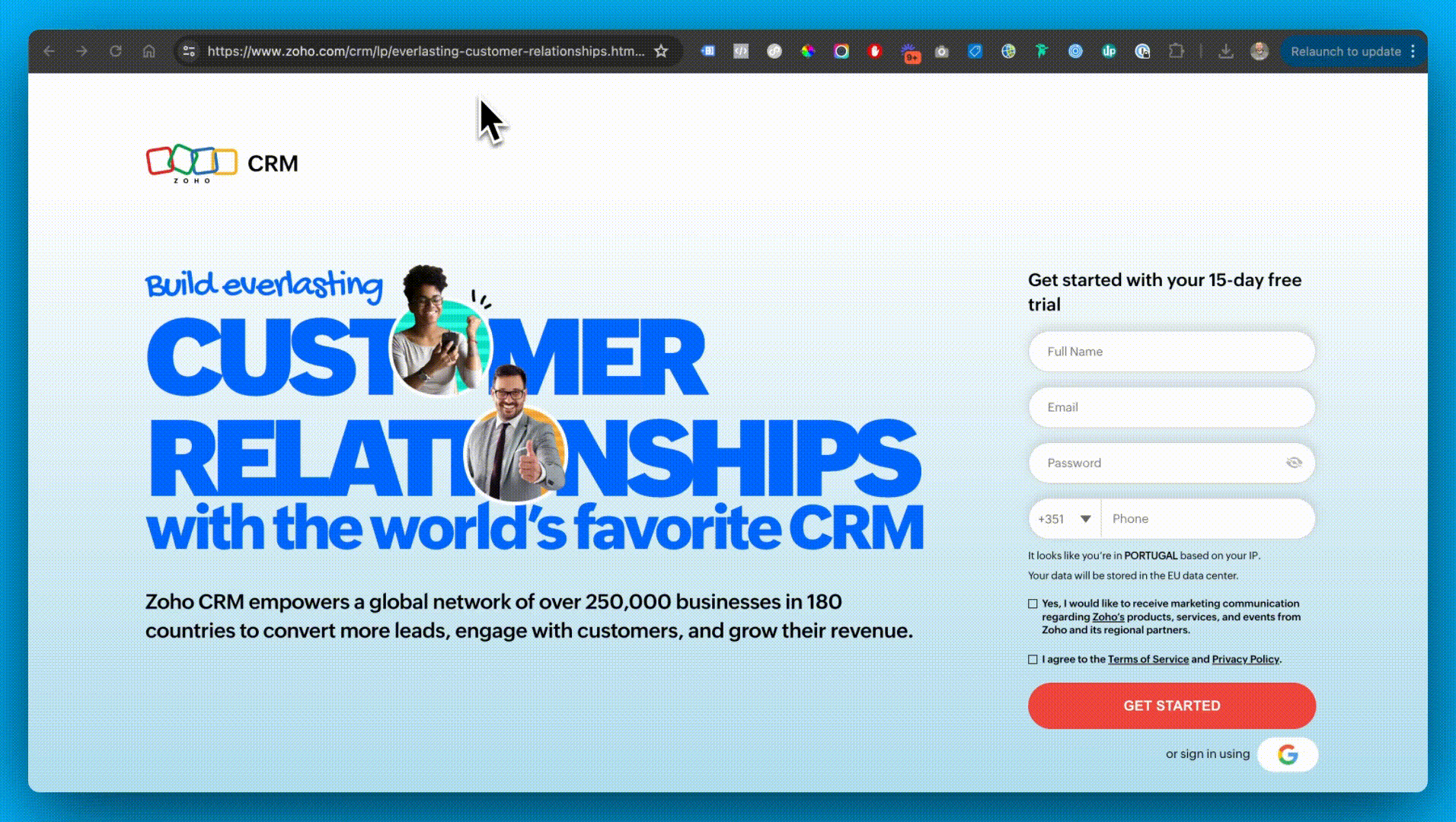
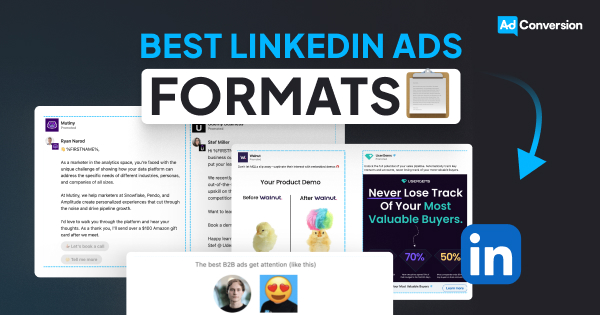

.png)
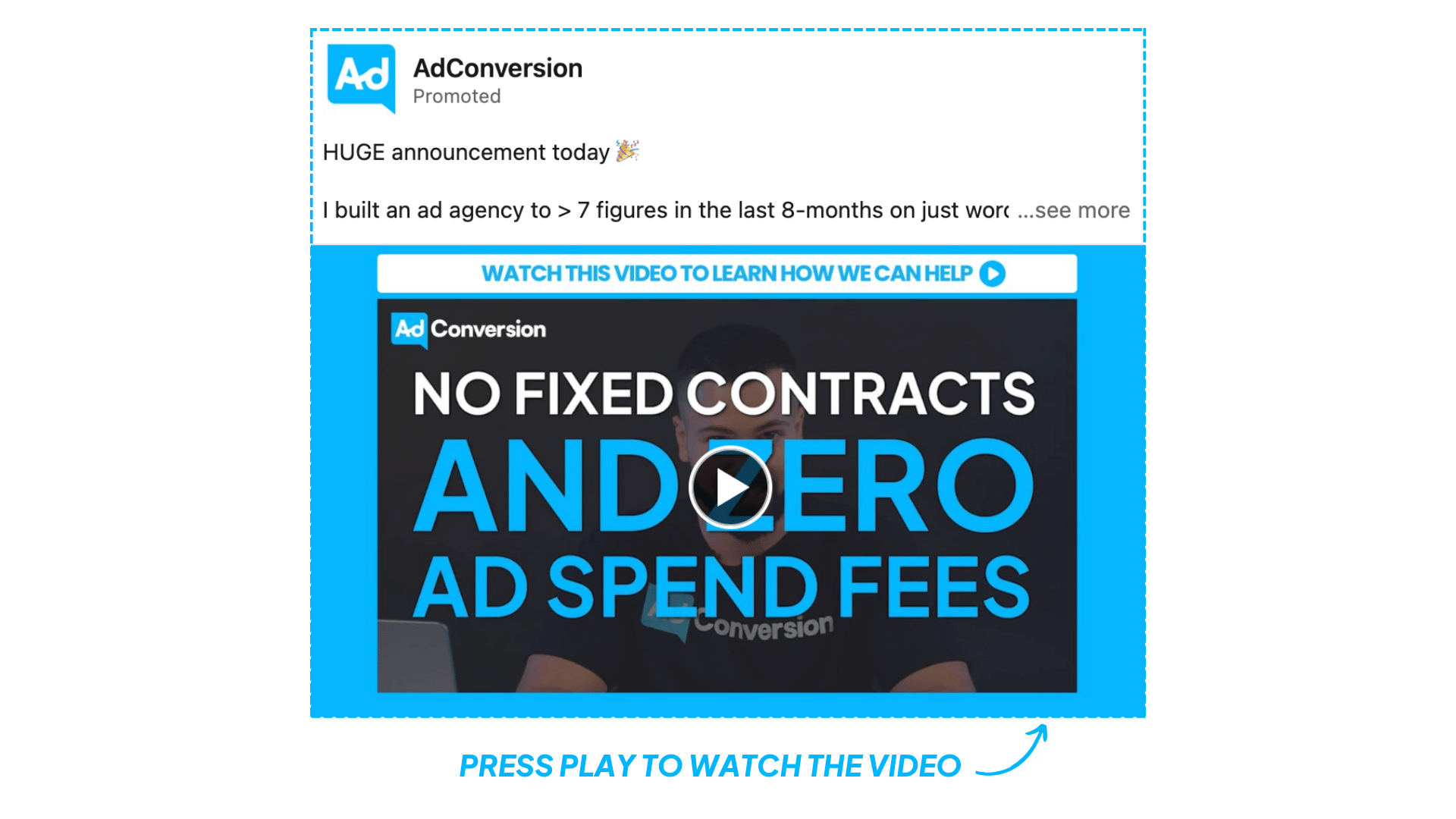
.gif)
.png)
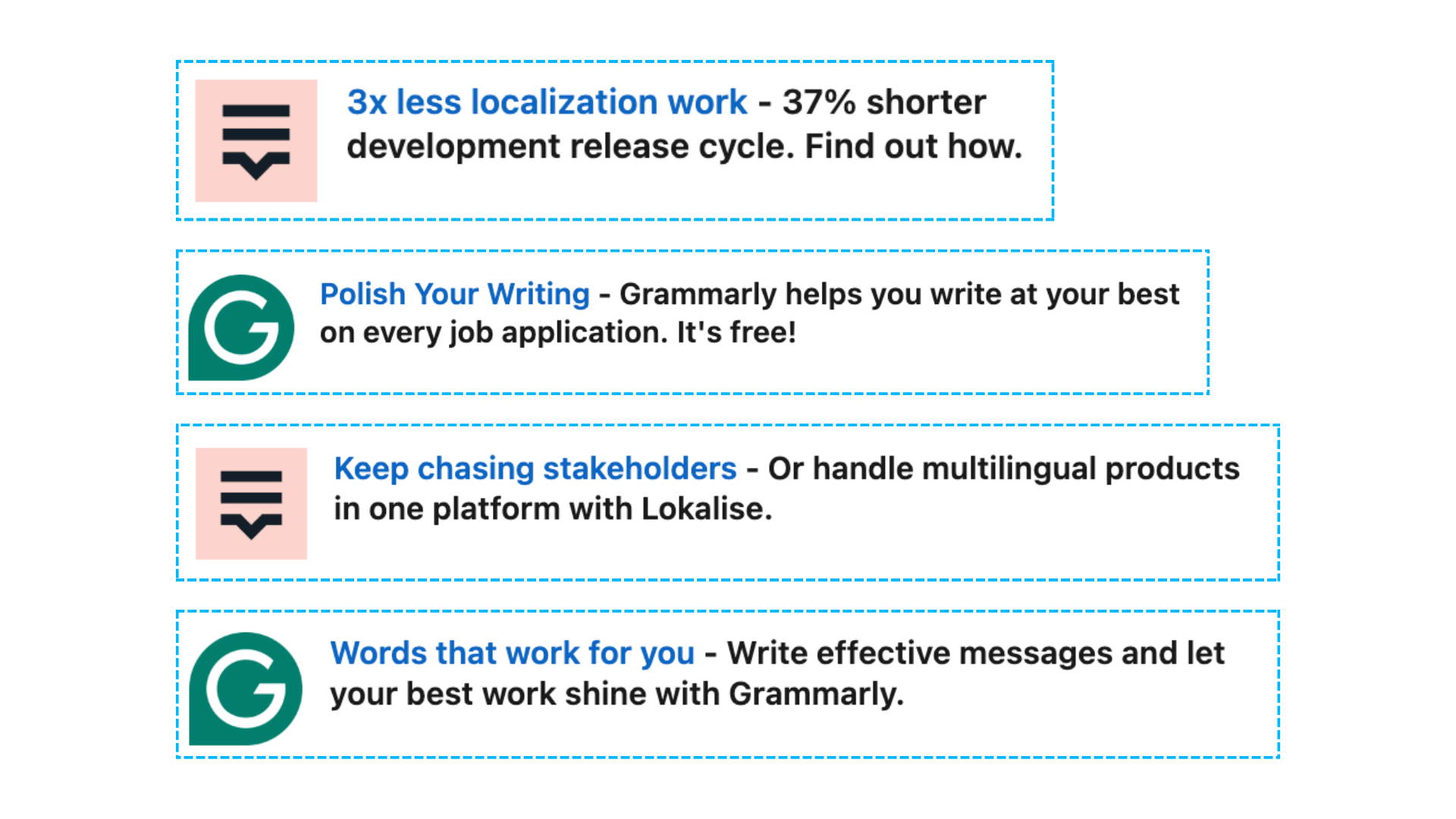
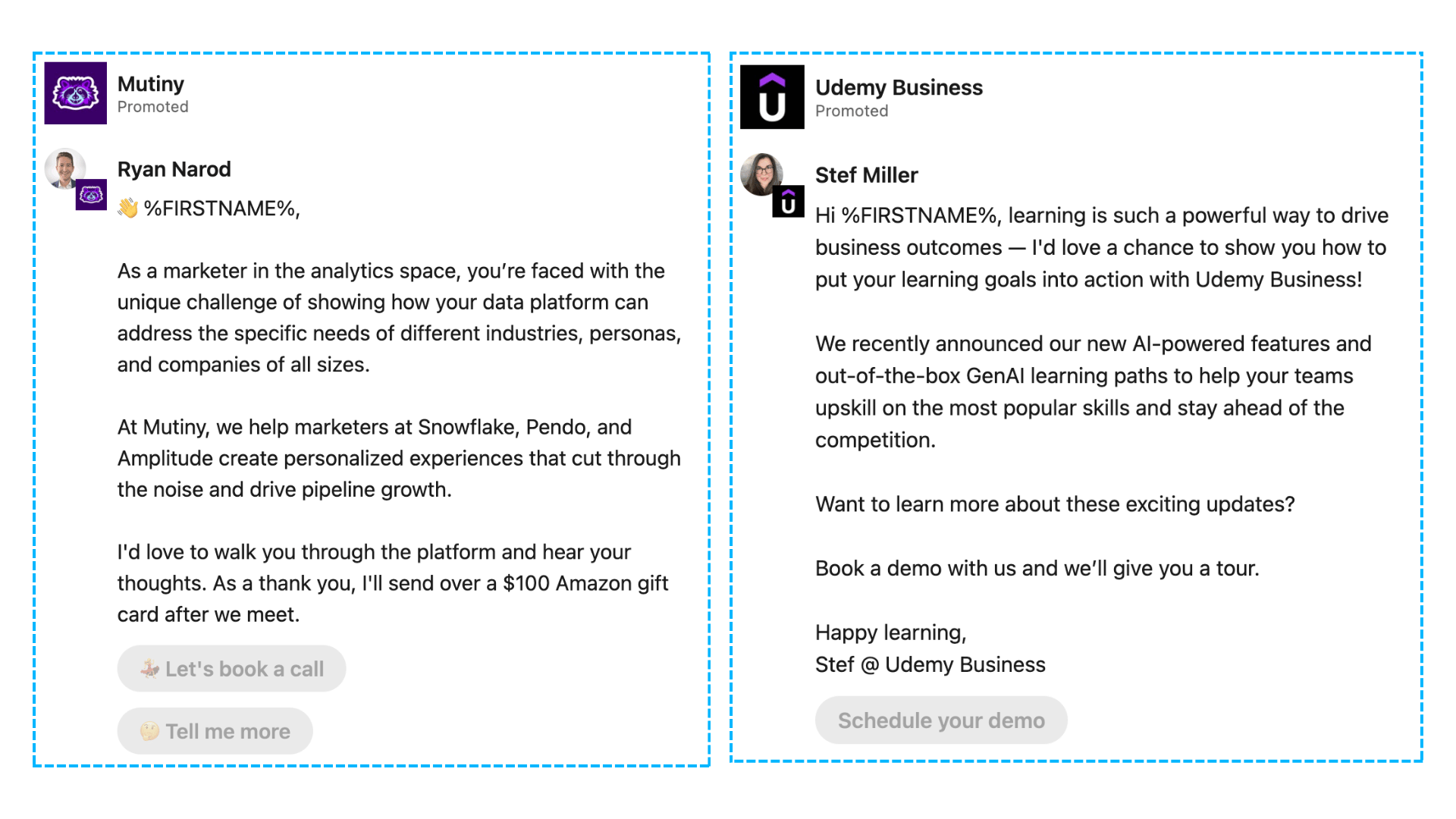
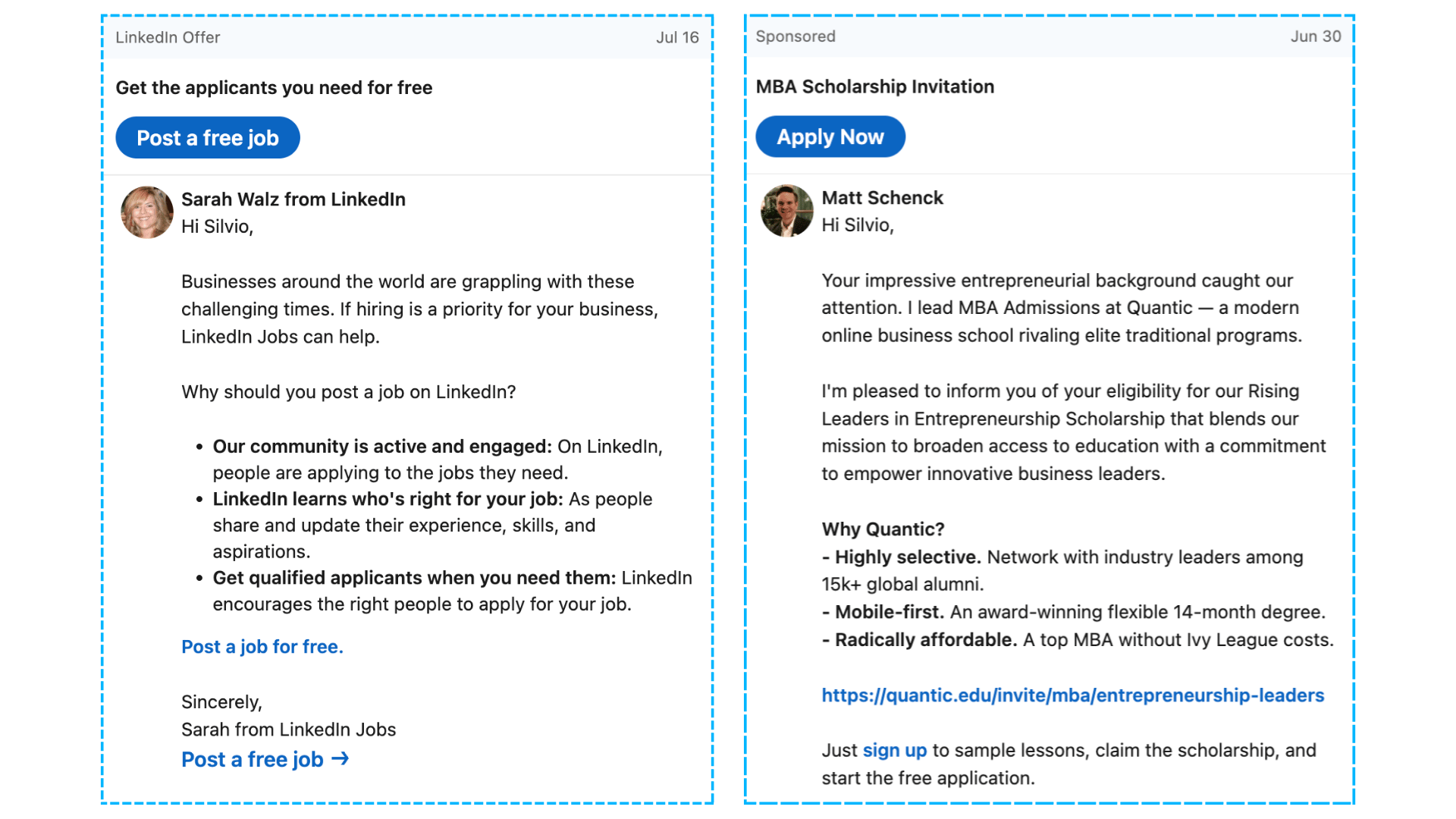

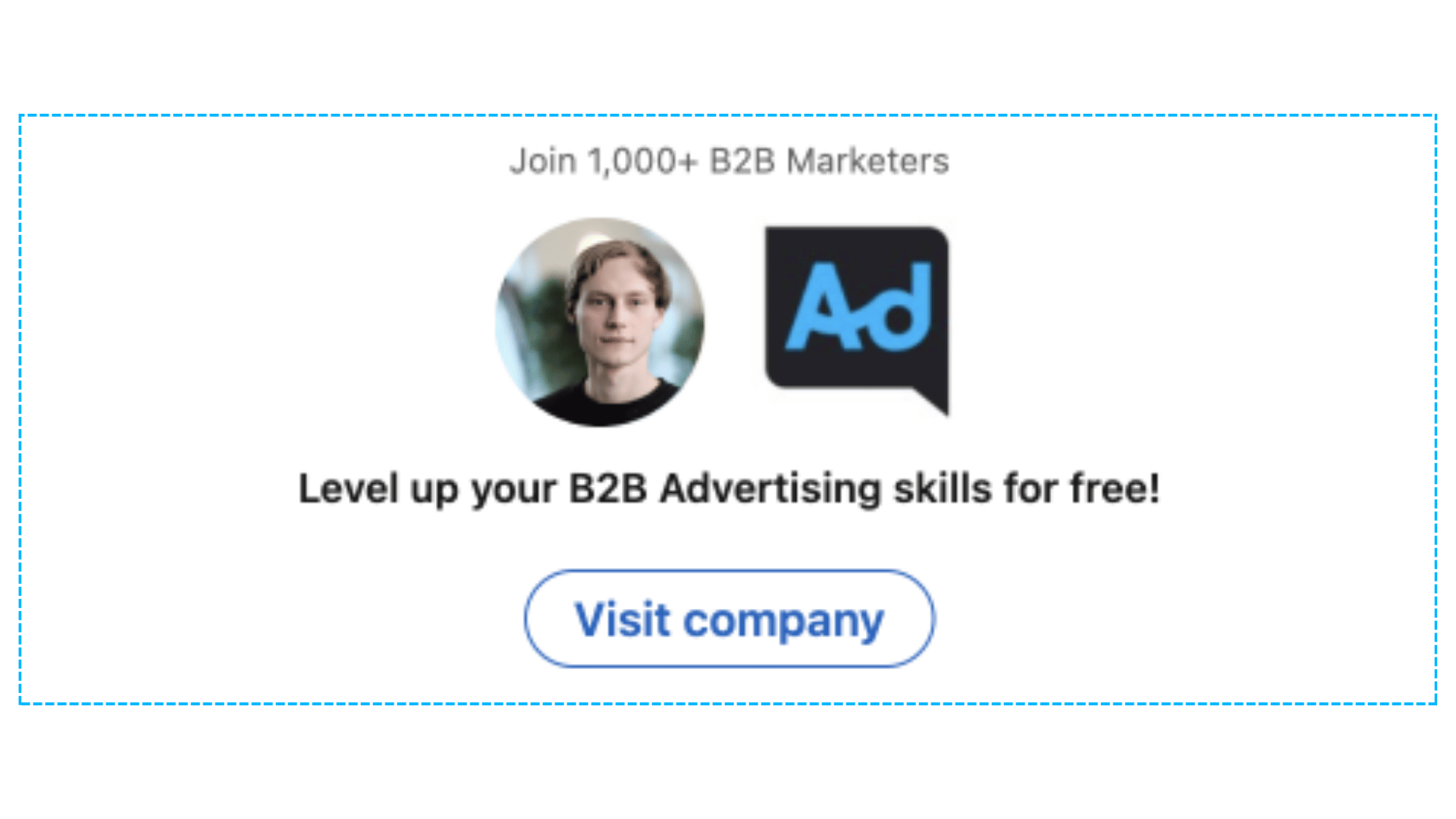
.gif)
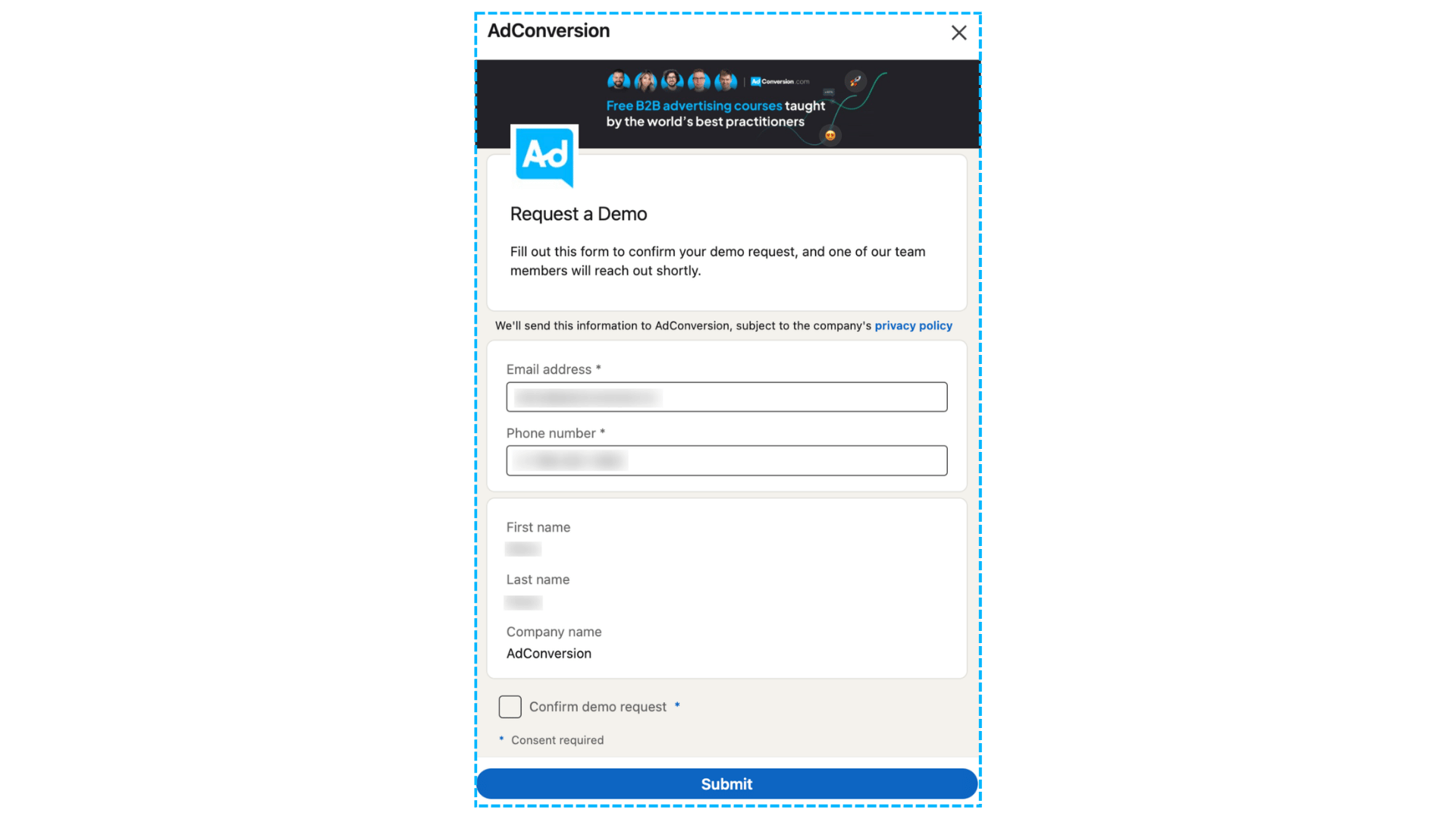
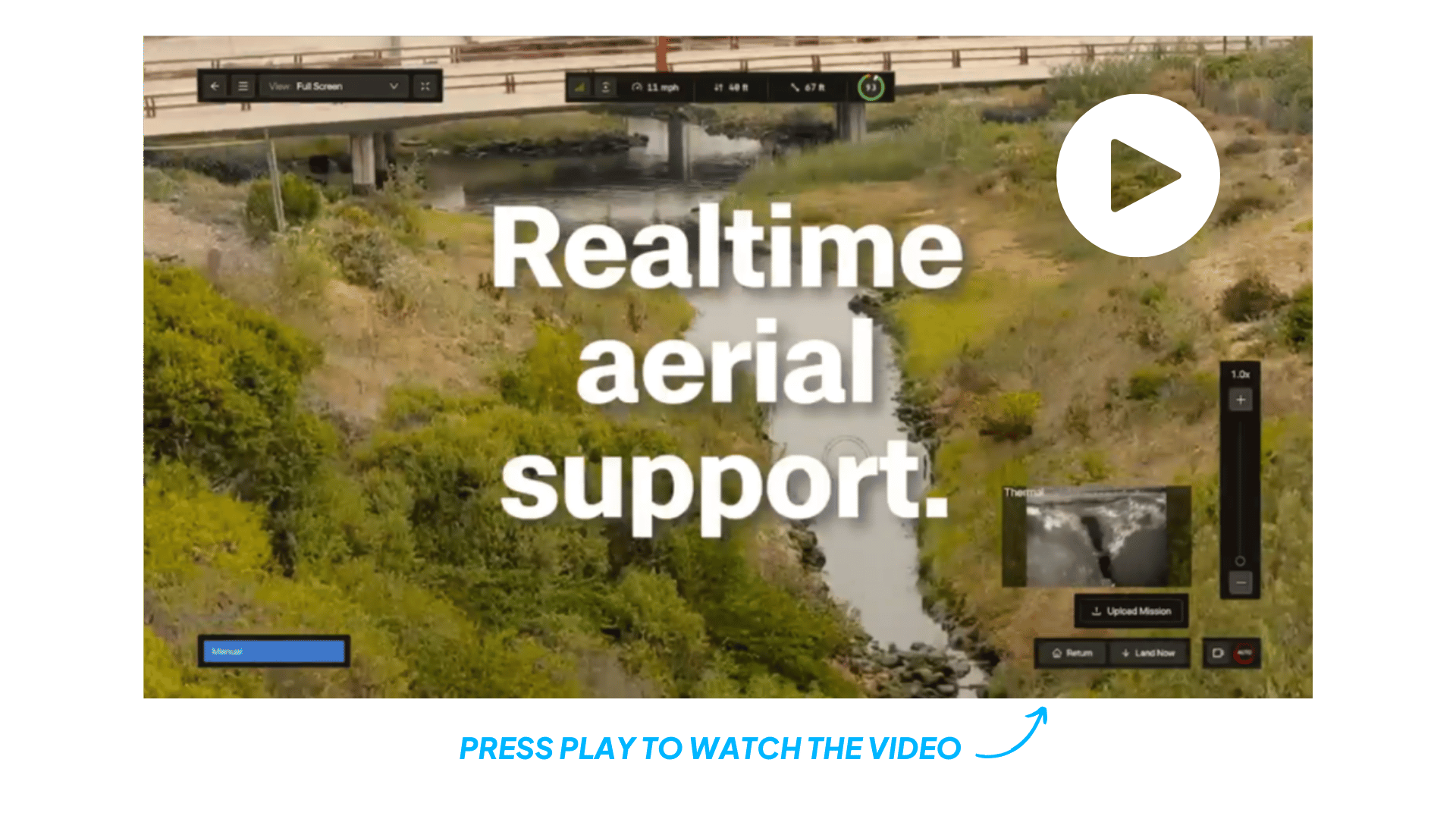
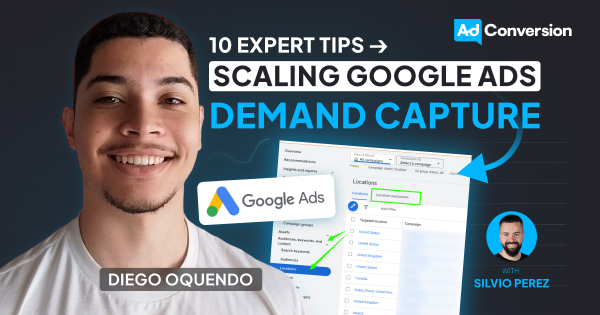


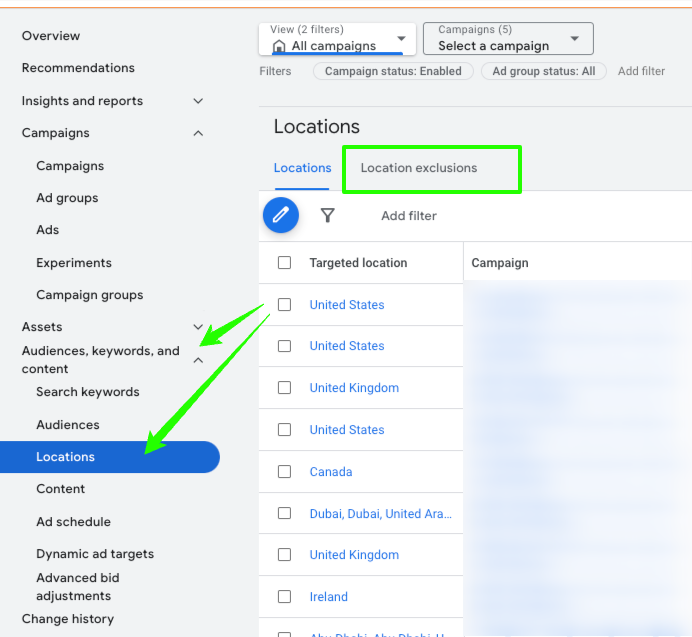
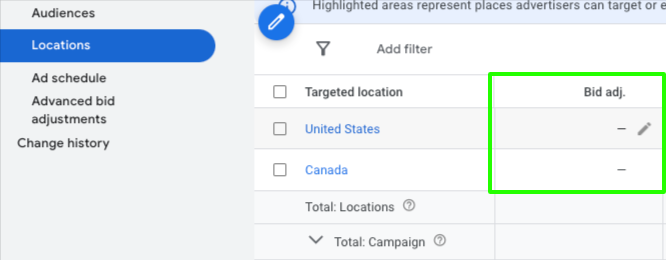
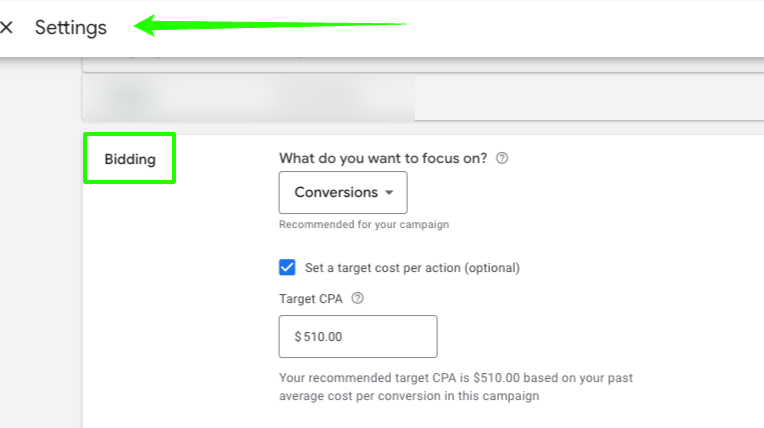
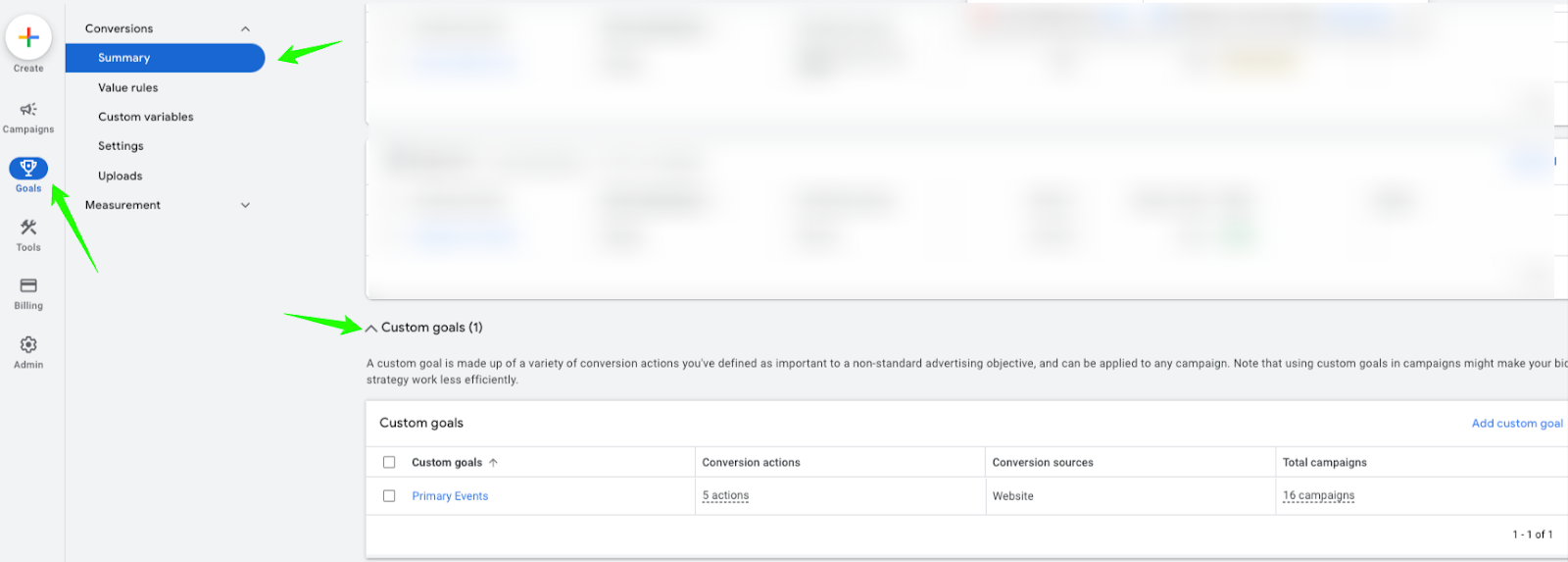
.jpg)

